Big Serge Thoughts
26 Apr 2024 | 4:55 pm
1. Maneuver, Position, Attrition
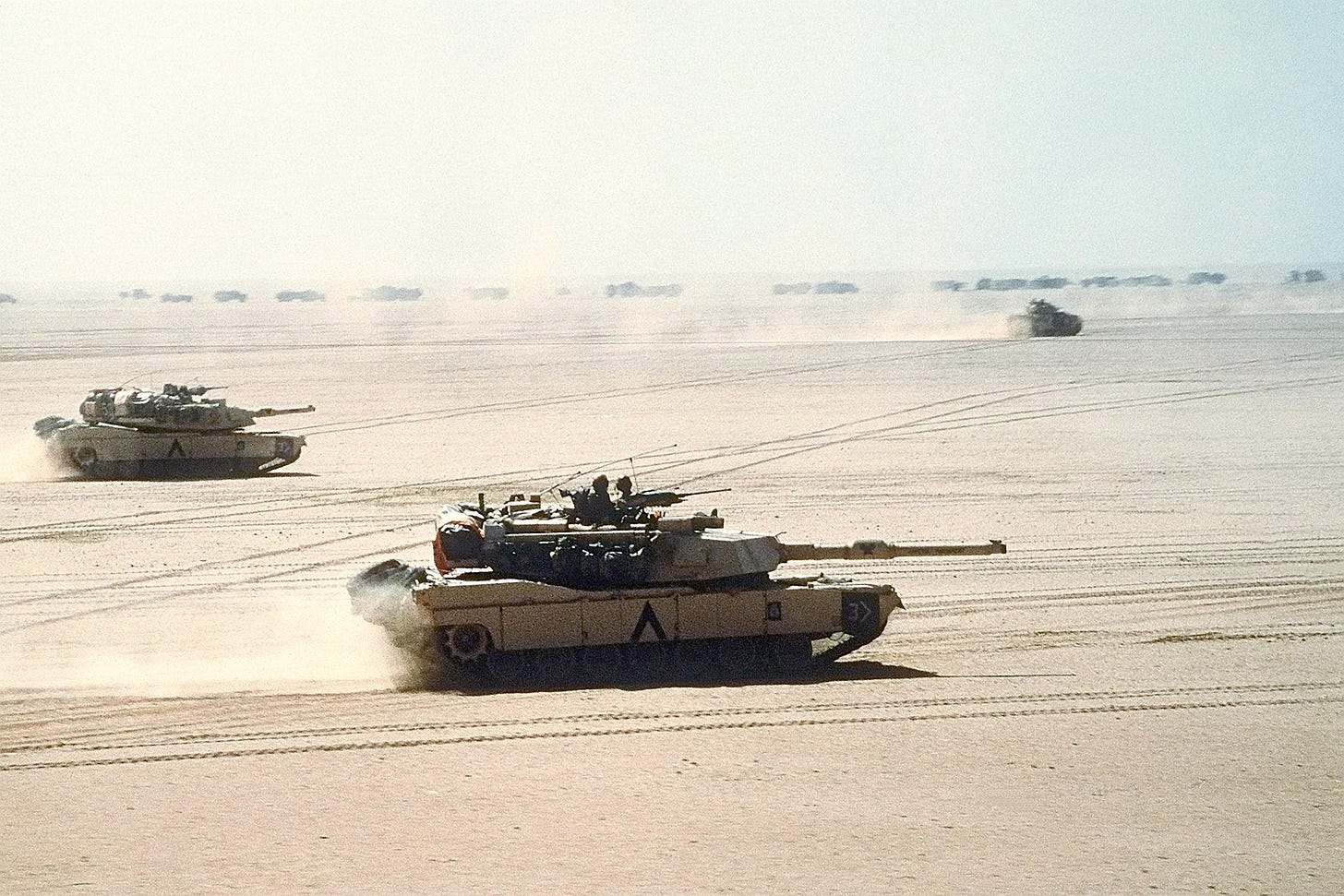
It makes no difference what men think of war, said the judge. War endures. As well ask men what they think of stone. War was always here. Before man was, war waited for him. The ultimate trade awaiting its ultimate practitioner. That is the way it was and will be. That way and not some other way.
~ Cormac McCarthy, Blood Meridian
It is undeniably true that war is among man's oldest preoccupations. The evidence is abundant that war is essentially as old as mankind's political life, predating cities and sedentary society. It seems that man took recourse to organized violence almost as soon as he grew to a socio-political pattern of life, and from that early period much of human political and technical innovation was spurred on by the relentless drive to fight and win.
Almost as soon as war graduated past its tribal phase, it seems that man stumbled upon his next great tradition - not a tradition quite as old as war, but nearly so. The oldest battle for which we have recorded details on battlefield movements (thus the oldest battle that can be reconstructed in some level of detail) was the Battle of Kadesh, fought between the Egyptian Pharoah Ramesses the Great and the neighboring Hittite kingdom. The climax of this battle was a heroic and audacious maneuver by Ramesses, who led a battlegroup of charioteers on a ride around the battlefield to attack the Hittites on the flank.
It thus seems that for nearly the entire history of warfare (which is to say the history of man), armies have been attempting to get a powerful grouping of combat power mobile, move it to the enemy flank, and attack it immediately. Such maneuver sits at the nexus of those two powerful coefficients of battle - rational calculation and emotive aggression. Warfare constantly mediates between these two, balancing the strategic benefits of planning with the initiative and vigor of instinctive aggression. Maneuver sits at the crossroads and harnesses their powers synergistically, promising victory through initiative, decisiveness, and aggression.
Yes, armies have been lusting for the enemy flank for millenia, but technical factors often frustrate their efforts to get there. Maneuver waxes and wanes as a battlefield expedient, at times kneecapped by various technical or material constraints, be it shortcomings in logistics, command and control, or the protection of assets on the move. Operational maneuver in particular has frequently gone through long periods of technical sterility. Today in Ukraine, the ability of both combatant armies to strike staging areas and troop concentrations has forced a re-emphasis on dispersion and concealment. With maneuver once again at a crossroads in Eastern Europe, we can conclude this series by considering maneuver in its eternal relation to the military arts writ large.
Trapped in TheoryHaving made a long an arduous walk through the timeline, we see disparate instances of the military art splattered like a temporal collage of violence. What is it that unifies the body of examples? Is there a conceptual connection between the oblique order of the Thebans at Leuctra, the Mongol flying columns in Persia, Napoleon's corps movements, and the Wehrmacht's panzer package? Is there a unifying theory of maneuver at all?
Maneuver, in the simplest terms, is the use in warfare of movement relative to the enemy to gain some advantage. However, as in all areas of human endeavor, definitions themselves can become battlegrounds. Maneuver has meant different things in different ages, and in the modern age has become the subject of self-conscious debate - as, for example, in the case of the US Marine Corps' internal wrangling over the "Maneuverist" school of warfare. It is easy to get bogged down in these arguments, or to come away thinking that "Maneuver", like obscenity, is something that we cannot define, but we know it when we see it.
Modern sensibilities of maneuver - particularly those of the American military - are in fact almost unrecognizable from earlier concepts. In particular, modern theories are intensely battle-centric and focused heavily on the use of tempo and initiative to disrupt the enemy's ability to process and fight. Furthermore, in the modern parlance, maneuver is held to be essentially the opposite of positional fighting; the former is mobile and decisive, the latter is static and incremental. Such a schema would have been alien to the great generals of the early modern era. In the era of early modern warfare "maneuver" meant something very different, being both distinct from recognizably active battle and intrinsically tied to position, rather than being opposed to it.
An example would likely help, and the best comes from the War of the Spanish Succession (1701-1714). A little studied and little appreciated war today, this was nonetheless a war of colossal import and great military interest - fought (at the risk of fantastical reductionism) to determine the balance of power in Europe between the Hapsburgs and the French, with the British backing the Hapsburgs to contain an increasingly powerful France from establishing continental hegemony.
In any case, the military aspects of the war are fascinating, because cosmetically it would appear to be a static and attritional conflict. Battles were linear, head on affairs (as was typical in the era of early musketry), and the front lines (which largely ran through modern Belgium) were dominated by complex networks of fortresses and earthworks. When viewed at satellite scale, this looked like a more primitive variation of World War One, with small territorial changes, powerful fortifications, and an apparently positional-attritional character.
In fact, the War of the Spanish Succession featured three of history's most gifted generals, including one from each of the primary combatants: Prince Eugene of Savoy for the Hapsburgs, John Churchill, Duke of Marlborough for the British, and Marshal Claude Louis de Villars for the French (shorthanded simply to Prince Eugene, Marlborough, and Marshal Villars). All three are recognized by historians as supremely talented commanders, with sensibilities that they would have clearly defined as "maneuverist."
The essence of campaigning in the WoSS was a complex series of marches and countermarches designed to lever the enemy out of position or create otherwise favorable circumstances for positional improvements. In such an operating, environment, however, the lines between maneuver and positional fighting were easily blurred. Let us take two notable examples from the career of the Duke of Marlborough, which usefully illustrate the issue.
By 1711, after a decade of war, the anti-French alliance had slowly but surely squeezed the French out of their positions in the Spanish Netherlands (as Belgium was rather confusingly called at the time), pushing the lines of contact into Northeastern France. Despite several years of setbacks, the French could feel confident in their position - the frontier was guarded by a well prepared defensive line, immodestly called the "Ne Plus Ultra Line". The line was essentially a defensive belt of rivers (many of which had been strategically dammed to raise water levels), earthworks, fences, and fortresses, with Marshal Villars prowling behind with the French Field Army. Villars felt, and not without reason, that the line was essentially impenetrable. His confidence was boosted by the unstable political position of Marlborough, who faced growing opposition back home in Britain. Villars felt that he was fighting from a position of great strength against an adversary who was under political pressure to take risks.

Marlborough, however, contrived a brilliant scheme to pierce the Ne Plus Ultra Line without firing a shot. Knowing that Villars' intention was to follow him laterally across the line to contest any attempt to cross, Marlborough moved west towards the fortress at Arras. Villars dutifully followed him. Marlborough then made a great show of preparing to offer battle - sending out screening cavalry detachments in full view of the enemy, and riding out with his staff to survey the terrain. French sentries observed the Duke gesturing with his cane, pointing out various terrain features and objectives to his officers. Villars implicitly believed that Marlborough would offer battle in the coming days, and sent a letter to King Louis XIV informing him that he had "brought Marlborough to his Ne Plus Ultra".
The order came down: "My Lord Duke wishes the infantry to step out." Marlborough would not offer battle - instead, he clandestinely struck camp as night fell, and began a forced march back towards the east at top speed, reaching a pre-designated crossing point over the Scheldt near the fortress at Bouchain, linking up with engineers and artillery that had been secretly positioned in wait. It was about 9:00 in the evening when Marlborough began his rapid shuttle to the east; Villars got wind that the British had gone at 2:00 AM, and though he immediately decamped in pursuit, that five hour head start was more than enough. Marlborough's forces covered over 30 miles in about 19 hours, and managed to move the entire body over the Ne Plus Ultra Line without a fight.
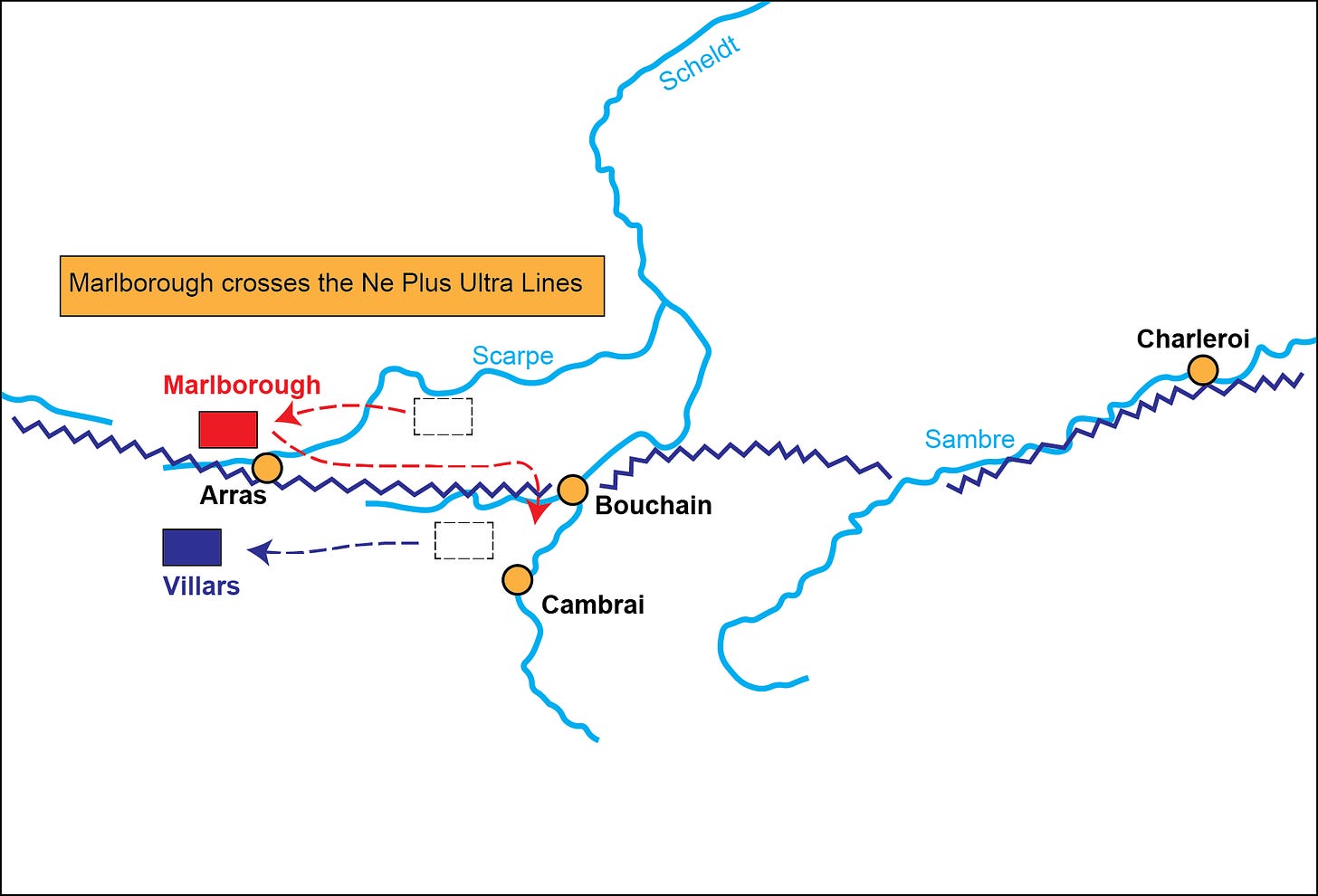
This was certainly an impressive and effective operational contrivance by Marlborough - drawing the main body of the French field army out of position with a feint towards Arras, then flying back up the road under the cover of darkness to cross the river lines near Bouchain. What seems incongruous, however, is that Marlborough used this maneuver to position himself for a siege of the Bouchain fortress. Having crossed the river lines and penetrated the French position, he set his men to work building fortifications of his own. Most importantly, Marlborough's men built a pair of long entrenchments and earthworks running back to the rear, creating in effect a protected lane of supply and communications which allowed them to haul up the ponderous and vulnerable siege train, with the enormous cannon required to reduce the Bouchain fortress.
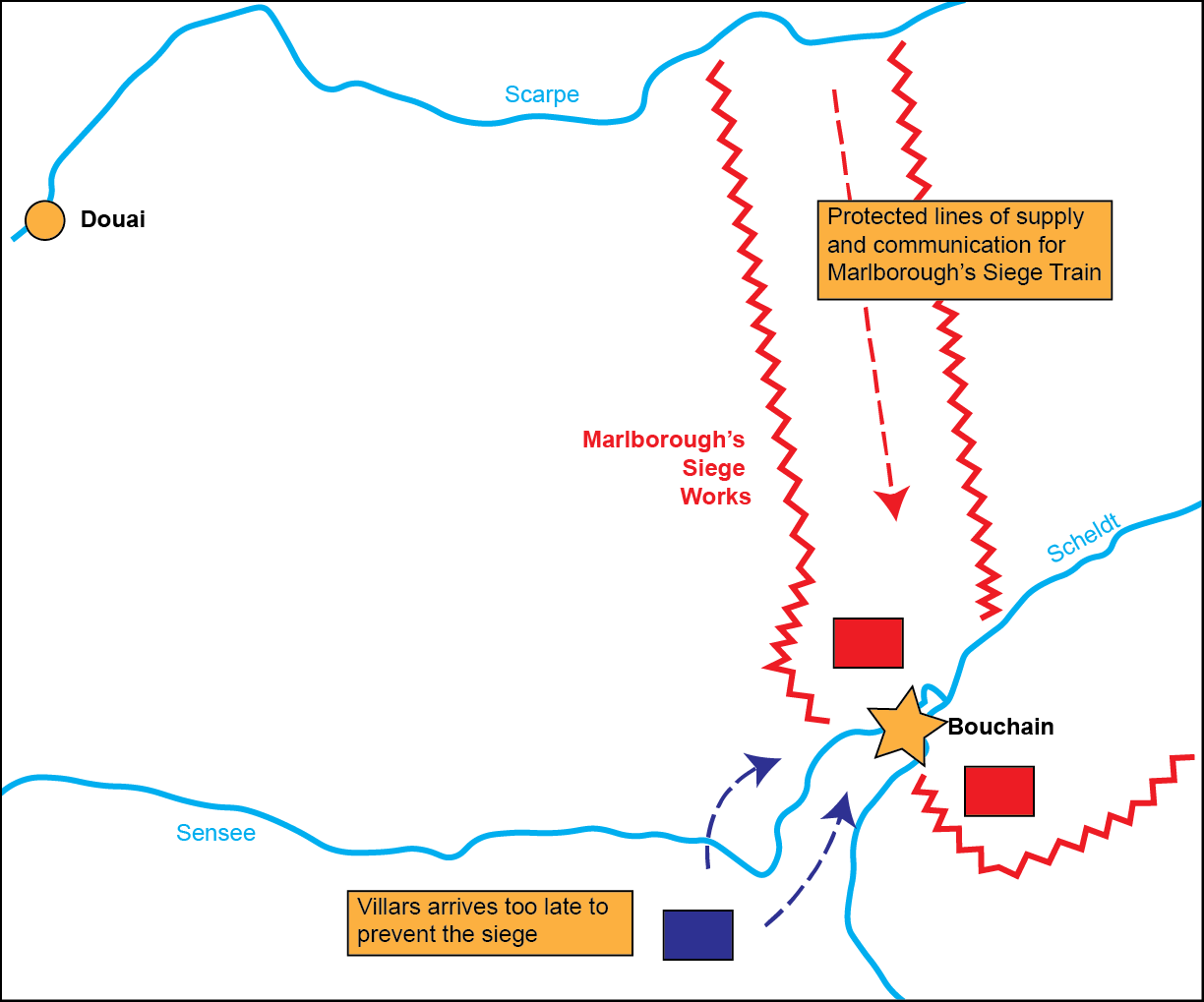
What relation did Marlborough's Bouchain operation have to "Maneuver", as such? In the modern scheme, the fit is not immediately obvious. None of the favored motifs about tempo or aggression particularly apply. Marlborough did not "open up" the front or create a state of mobile operations. Rather, he created a window of opportunity for himself to seize an important position. The usual dichotomy of war being either mobile or positional breaks down here; maneuver for Marlborough is not an alternative to positional combat, but an enhancement to it which allows him to seize an advantageous position.
Another campaign of the Duke's, however, offers an interesting counter-example, that being the famous 1704 march to the Danube and the subsequent Battle of Blenheim. The strategic conception was fairly straightforward: the French began the 1704 campaigning season by linking up with their Bavarian allies for an offensive into the Hapsburg heartland with the intention of threatening Vienna and forcing the Hapsburgs to negotiate, thus splintering the anti-French alliance. Marlborough, who had been wintering in the Netherlands, made the risky decision to march a portion of his army all the way to southern Germany to counter the French offensive.
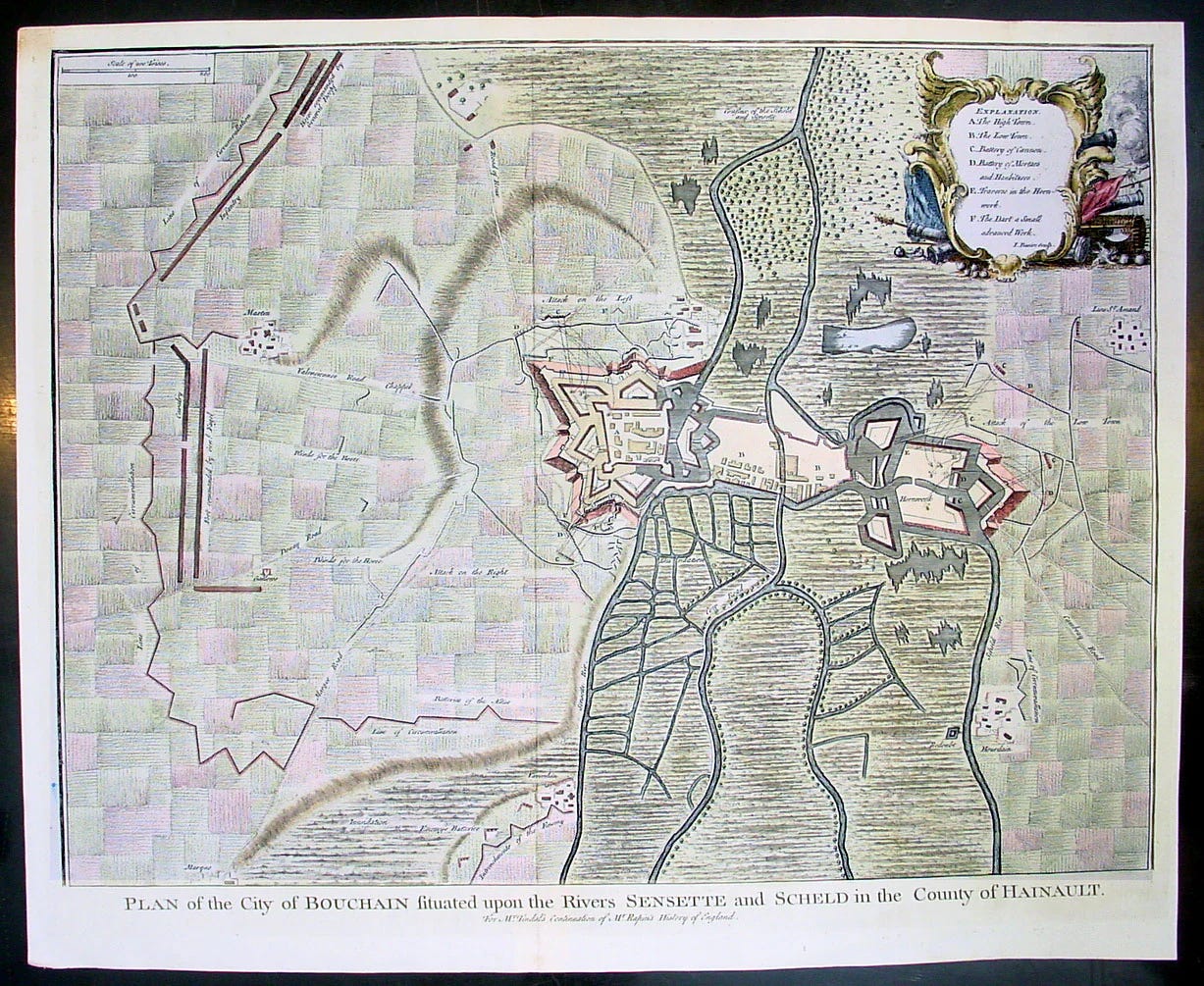
Marlborough's march up the Rhine has always drawn very high (and well deserved) marks from historians, for a variety of reasons.
The distance traversed was monumental for the day, with Marlborough's 20,000 strong force covering some 300 miles by foot in a month. Despite the enormous distance covered by this "scarlet caterpillar", as the long columns of redcoats were described, they arrived in the southern theater in superb fighting condition, much to the astonishment of their Hapsburg allies. This was thanks to extraordinary staff work by Marlborough and his team. The march route was carefully plotted out, and messengers were dispatched on horseback (with bags full of cash) far in advance of the main body to arrange supply depots. Consequently, the Duke's men would march into various and sundry towns on the scheduled day to find food and livestock fodder waiting for them. Marlborough thus kept his men well fed and minimized their fatigue. He even arranged to have them re-shoed, making an advance purchase to have tens of thousands of pairs of boots manufactured and delivered to Heidelberg, where the army found them waiting in enormous mounds. The precise planning of the march and the regularity of the supply were executed to near perfection.
Furthermore, the strategic redeployment entailed no small measure of risk at both the strategic and the operational level. Decamping for the Danube front left the Netherlands relatively undefended, but Marlborough accepted the hollowing out of this important front, correctly gambling that the French would not be able to exploit his absence. Furthermore, the march itself was perilous, because it necessarily involved moving laterally (that is, across the face) of the French border in marching columns. What this meant was that for an entire month, Marlborough would be presenting his flank to the enemy as he worked his way south. Again, however, the French were not positioned to capitalize.
The rapid and well-executed move to the south succeeded, without exaggeration, in saving the anti-French alliance. Linking up with Hapsburg forces under Prince Eugene, Marlborough and his allies smashed the French at the Battle of Blenheim, destroying much of a large French field army, killing its commander, and completely defeating France's southern strategy. The victory even succeeded in knocking the key French ally (Bavaria) out of the war. Blenheim is understood as a key turning point in the war which dissipated early-war French momentum.
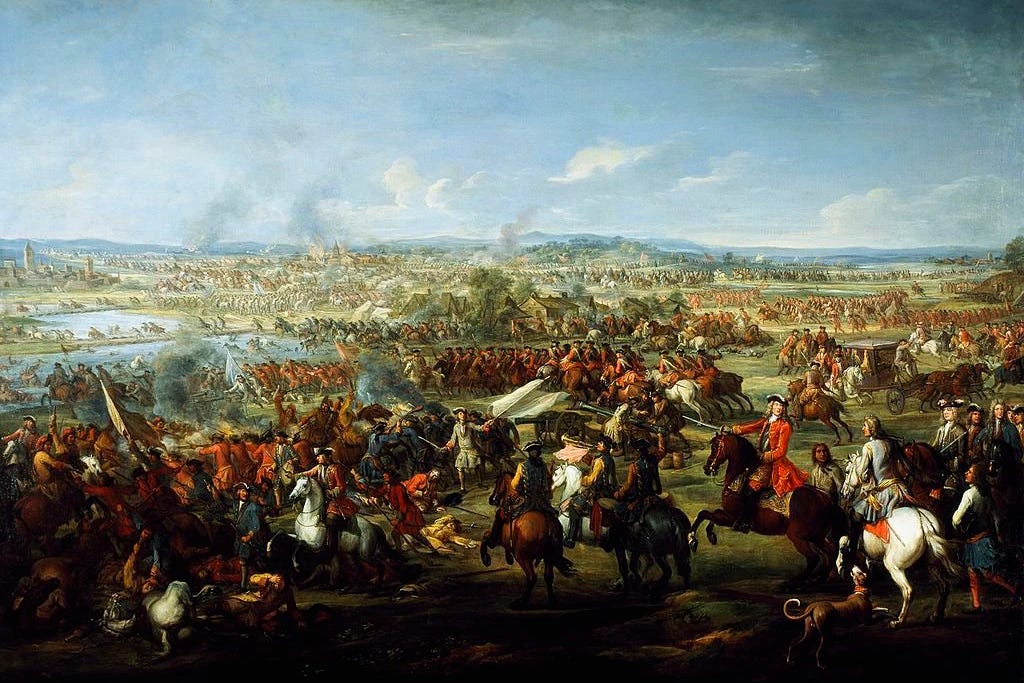
Marlborough's 1704 campaign impresses in a variety of ways. He demonstrated a decisive instinct for command along with a bold tolerance for strategic risk, and the staff work in organizing and supplying the long march was truly exceptional. There was absolutely nothing easy or automatic about marching an early 17th century army hundreds of miles away from its supply bases, but Marlborough executed it seamlessly. Then, having successfully redeployed to the south, he fought and won a close run battle against a powerful French force. All the while, he had to manage a politically delicate coalition with the Hapsburgs. This was a classic for the ages.
But what was the relation of the Blenheim campaign to Maneuver as such? While the speed of Marlborough's movement to the south certainly evokes an impression of maneuver, in fact the campaign was simply a footrace - an attempt to reach the southern theater in a timely manner to prevent Hapsburg defeat. Marlborough did not aim to gain some advantage from movement, but only wanted to reach the decisive theater in time. The Battle of Blenheim itself was a fairly straightforward and linear field battle, with the two armies drawn up in rather classic formation. This was a display of operational mobility, to be sure, but not maneuver.
Thinking about these two operations of Marlborough - the 1704 march to the south, and the 1711 penetration of the Non Plus Ultra Line - we see that maneuver as a concept can be easily misconstrued, in particular with the modern battle-centric scheme and the aversion to positional warfare.
In 1711, Marlborough genuinely did make use of operational maneuver, using rapid lateral movement to shake off Villars and slip across the river line uncontested. In the simplest terms, he used movement to achieve meaningful advantage - however, because that advantage manifested itself in a positional siege, it would seem to be out of sync with the open and battle-centric modern schema of maneuver. In contrast, the 1704 campaign utilized rapid movement, but this was a simple matter of reaching the critical theater, rather than generating some advantage that could be levered into battlefield success.
Having suffered through this long ancillary diatribe about Marlborough, we come to the point. Maneuver and movement are not synonymous, in that some operational movements are not maneuver as such, and some maneuvers do not lead to mobility. Our general conception tends to assume that war is one or the other - position or maneuver, attrition or annihilation - but in fact these concepts can coexist quite comfortably, with maneuver empowering position and vice versa.
In the age of Marlborough, in fact, maneuver generally manifested itself as antithetical to battle, in that it could allow a force to lever the enemy out of favorable positions. For example, we may return to our old friend Marshal Villars - it is easy to feel bad for him after being juked out of position by Marlborough, but in 1712 he would have his own moment of greatness and revenge - with the anti-French coalition on the verge of victory on the northern front, Villars maneuvered his forces through a seam in the enemy positions with an audacious night march, cutting them off from their supply depots and forcing them to withdraw. With one bold maneuver, he unraveled years of coalition gains and set the stage for the compromise peace that finally ended the war.
Warfare in Marlborough's era is usually described as "limited", or "positional" in nature, often characterized by agonizingly slow and incremental gains. This was not, however, due to some doctrinal preference for position, but rather due to the logistical constraints of the era. Standing armies had become quite large, with demands for food and animal fodder that made it impossible for them to live off the land. The only way to sustain early modern armies was by assembling enormous stockpiles of food, fodder, powder, and other supplies, and running constant convoys of horse drawn wagons to haul these supplies from the depot to the field army. Given the poor state of European roads at the time, however, the range and speed of these wagon convoys was poor. Thus, the nature of the supply system kept armies tightly chained to their logistical chains and tended to keep them close to their depots, and maneuvering to threaten the links between army and depot was one of the main operational goals of all the combatants. This is why Marlborough's march to Blenheim was considered so exceptional - it remains one of the only examples of the era where an army managed to operate away from its own supply magazines.
The point here is that for generals like Marlborough or Villars, "maneuver" took on a particular meaning based on the material context of the war. The "limited" and position-oriented nature of their maneuvers was not due to some lack of vision or skill on their part, but deeply entwined with the constraints of the military system at the time.
Maneuver and position only began to separate with the later advent of the Prussian operational sensibilities and the kinetic operations of the Napoleonic era. Napoleon practiced a highly mobile and aggressive form of warfare, but it was not recognizably a form of maneuver as defined by the likes of Villars and Marlborough. To those earlier generals, maneuver was about levering the enemy by manipulating position and threatening crucial lines of supply and communications that connected enemy depots, fortresses, and field armies. Men like Napoleon and Frederick the Great, on the other hand, liked to get after the enemy at top speed and attack him immediately - on the flank, if possible, but frontally if necessary. Napoleon had little time for wriggling his way on to the enemy's supply lines - he wanted to find the main enemy field army and crush it.
Thus, the concept of maneuver expanded over time. Napoleon did not always use positional manipulation to defeat the enemy. Sometimes - as in the case of the famous Ulm Campaign - he would use a Marlboroughean (is that a word?) form of maneuver, to lever the enemy into surrender, but often he simply attacked frontally in a conventional field battle and smashed the enemy with the superior French tactical package and his own magisterial feel for command.
Modern theorists, like John Boyd, finally offered the conceptual framework to expand the definition of "maneuver" to include the generalship of men like Napoleon and Frederick. The key, according to this American school of thought, is in tempo, speed, and the disruption of the enemy's ability to process information and make decisions. Napoleon's operations were a form of maneuver because the French army used its superior speed and agility to disrupt the enemy's deployment and command.
The American theorist William Lind (a disciple of Boyd), who wrote the self-importantly titled "Maneuver Warfare Handbook" even went so far as to argue that operational maneuver was exclusively about time, speed, and cognitive processing. He noted in that 1985 book that that the Soviet doctrinal guidelines defined maneuver as "the organized movement of troops during combat operations… for the purpose of taking an advantageous position relative to the enemy." Marlborough and Villars are nodding, but Lind disagreed. Maneuver, he insisted, was not a question of spatial arrangements or position, but mental processing, and maneuver warfare was the art of acting and thinking faster than the enemy.
"But Serge, you onerously verbose rapscallion", I hear you say. "Why does any of this matter? Is theory really that important? Isn't this just an obscure debate among historians?" Well yes, I reply, but theory does matter a great deal, because it creates the cognitive architecture that militaries take to war. Armies become trapped in their theoretical animuses, which prime them to view warfare in a particular way. Misinterpreting the past to shoehorn events into a predetermined theoretical framework is often a path to battlefield difficulties or even defeat.
The German officer corps provides a poignant example of this. In the interwar period, the vestiges of the German army did an extensive amount of navel gazing, contemplating where they had gone wrong and how the first world war could have been lost. This period of soul searching reinforced the sense that war had to be fought in a mobile, attacking way - concepts from the the German operational tradition, like Schwerpunkt, Concentric Attack, and the fetishization of mobile operations became ever more deeply entrenched.
When this system worked, it worked brilliantly. German operational sensibilities and aggression carried the Wehrmacht agonizingly close to victory, churning its legs to the end at Moscow, in the Caucasus, and in North Africa. However, during the second half of the war the Wehrmacht increasingly looked like an army trapped in an alternate reality, enslaved to its own doctrine and historical self-conception. The late war history of the Wehrmacht is littered with operational schema that no longer made any sense - counterattacking the beach at Salerno, or the Mortain Gap in Normandy, or drawing up a phantasmagorical counteroffensive through the Ardennes in late 1944.
In the comfort of our hindsight, it is easy to dismiss ideas like "Schwerpunkt", or "Concentric Operations", or any of these other buzz words as simply artifacts of history - obscure lexical curiosities for military historians to throw around. They are that, but they were once more. These words and concepts were central to the way that German officers viewed and fought the war. They are splattered across the war diaries of the Wehrmacht and embedded in their orders and maneuver schemes. A unifying theory or doctrine of warfare is important for a military, because it provides a cohering intellectual framework that allows the officer corps to see and interpret events the same way, and thus act in a more unified manner. However, these theories and doctrines can easily become traps when they no longer correspond to the physical substrate of the war, and the events of recent decades have shown us just how fast that substrate can shift.
Maneuver's Eternal ReturnThe American military establishment spent the post-Vietnam decades thinking intensely about how to fight a major ground war, particularly in Europe, under peculiar cold war conditions. The fruits of this American reinvention were a reinvigorated training regimen, an array of new weapons systems and vehicles, and a totalizing commitment to agile command and control, strategic use of deep fires, and mobile operations.
Fortunately, the wargaming of the cold war remained an intellectual exercise only, and there was never occasion to test American doctrines and systems against massed Warsaw Pact tank armies. The Fulda Gap remained at peace, and Mikhail Gorbachev opted to unravel the Soviet Union with a series of self destructive political reforms. The bipolar world collapsed, as if spontaneously, into a temporary moment of unipolarity and utter American hegemony, and the American military was left holding an enormous hammer with nothing to smash.
Hence, the Gulf War - an unrivaled display of profligate military supremacy. America's Desert Storm stands at the pinnacle of the military art; a surgical, almost surreal dismantling of the adversary. America and her coalition axillaries destroyed, in the course of only a few weeks, the 4th largest army in the world, shattering a million man Iraqi army at the cost of fewer than 300 dead among the entire coalition, and a mere 148 Americans. The "kill ratios" were astonishing: something on the order of 70-1 in personnel and 80-1 in armored vehicles. In a sense, it appeared that the United States had "solved" conventional war, winning total victories at near-zero cost.
In hindsight, of course, it was easy to point out all manner of deficiencies in the Iraqi military which betrayed it to be a vast, but overmatched force. Iraqi command and control, morale, training, integration of fires, field grade command, and small unit tactics were exposed as utterly inadequate, and American forces enjoyed critical technological advantages, such as its airborne electronic warfare and ISR platforms, precision guided munitions, and the superlative fire control system on the M1 Abrams tank, which allowed American tankers to trade at exorbitant ratios when dicing it up with Iraqi armor.
It is probably fair to say that American and coalition forces enjoyed decadent advantages in virtually every dimension of combat effectiveness, including the technological, the institutional, and the human. All that being said, however, the Coalition campaign was extremely well organized, and this fact greatly augmented the inherent advantage in combat effectiveness. The situation can be somewhat compared to the German conquest of Poland in 1939 - Germany had insuperable military advantages, but a well designed maneuver scheme allowed the Wehrmacht to leverage the biggest and most overwhelming victory possible.
The Gulf War saw two distinct phases: a strategic air campaign (the first modern air campaign at scale against an enemy with an integrated air defense) and a maneuver campaign. We can consider the characteristics of each in turn.
The coalition Strategic Air Campaign (with over 90% of the sorties provided by American aviation) had a powerful shaping effect, in that it degraded and paralyzed Iraqi capabilities at both the strategic and operational level. Strategic targets included power generation, road and rail infrastructure, government offices in Baghdad, and industrial facilities - closer to the battlefield, critical targets like air defense, command and control posts, strike systems (particularly SCUD missile launchers), and communications were hunted.
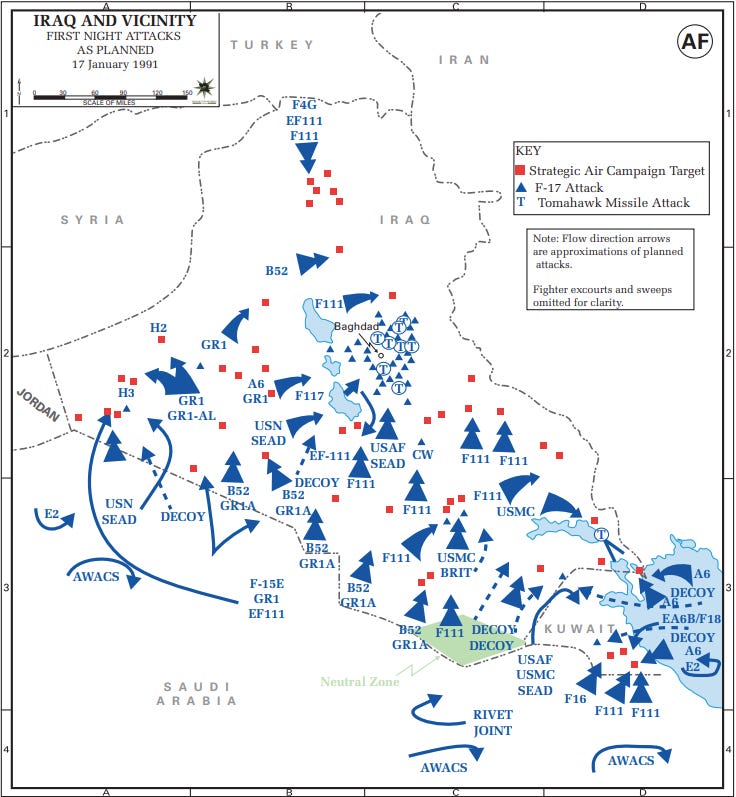
The most impressive element of the air campaign, however, was the eradication of the Iraqi air force and air defense. On paper, the Iraqis had a sizeable park of air and air defense assets, with the world's sixth largest air force (parked in specially built hardened aircraft bunkers), over 100 SAM (Surface to Air Missile) batteries, and an integrated air defense network. The Iraqi air defense net was tied to a centralized command and control bunker which ran on a French-designed computer system called Kari (the French name Irak spelled backwards). A prewar report from the Pentagon described the Iraqi air defense the following way:
The multi-layered, redundant, computer-controlled air defense network around Baghdad was denser than that surrounding most Eastern European cities during the Cold War, and several orders of magnitude greater than that which had defended Hanoi during the later stages of the Vietnam War. The multi-layered, redundant, computer-controlled air defense network around Baghdad was denser than that surrounding most Eastern European cities during the Cold War, and several orders of magnitude greater than that which had defended Hanoi during the later stages of the Vietnam War.
In fact, this was rather overly generous. The size of the Iraqi defense system belied a variety of major problems. First and foremost, Iraqi defense batteries were deployed in a point-defense role, creating clusters of air defense around strategic targets (particularly Baghdad and the invading Iraqi forces in Kuwait) with enormous gaps that allowed easy penetration of Iraqi airspace.
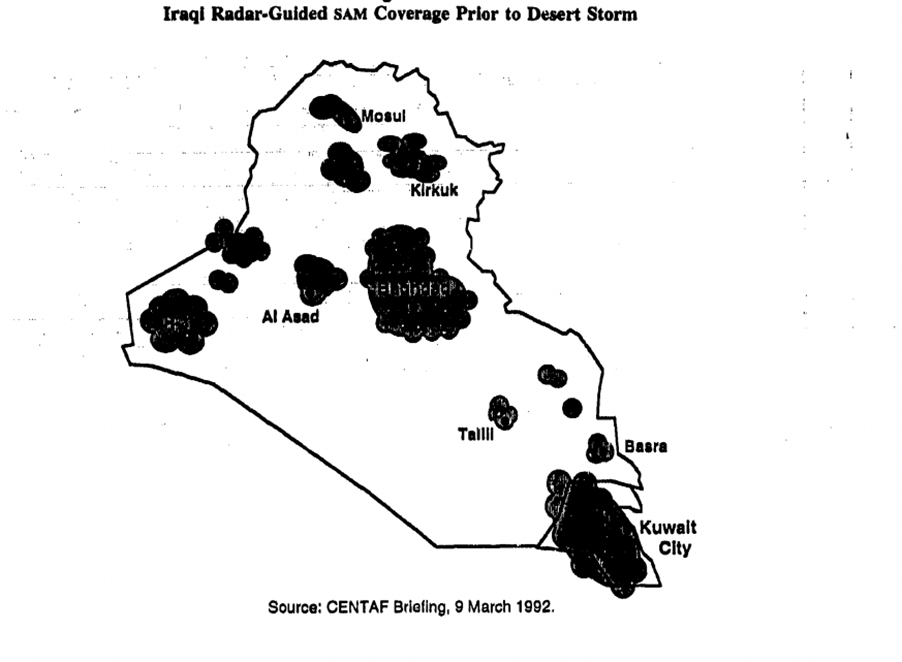
2 Apr 2024 | 3:19 pm
2. Index of Articles
For ease of reference, I will endeavor to keep this list updated with all the articles published here, ordered chronologically by topic or series.
Russia-Ukraine WarSound and Fury: Nukes and Force Generation Problems (Oct 28, 2022
Surovikin's Difficult Choices: Russian Kherson Withdrawal (Nov 12, 2022)
Coming Soon
Military History: ManeuverPart 2: Dispersement, Ambiguity, and Concentric Movement (Nov 10, 2022)
Part 4: Turning Movements and the Geometry of Musket Armies (Nov 28, 2022)
Part 6: The Failure of Decisive Battle in the American Civil War (Dec 16, 2022)
Part 8: The Failure of Maneuver in the First World War (Jan 17, 2023)
Part 12: The Troubled Beginnings of Soviet Operational Art (Apr 27, 2023)
Part 13: Death Trap on the Volga: The Stalingrad Campaign (May 9, 2023)
Part 14: Death Tango in the Dnieper Campaign (June 23, 2023)
Part 16: The Eagle has Landed: America Meets the Wehrmacht (Aug 2, 2023)
Part 19: One Final Effort: Germany's Last Battle (Oct 26, 2023)
Coming Soon
Miscellaneous28 Mar 2024 | 9:23 pm
3. Maneuver Theory and the Cold War
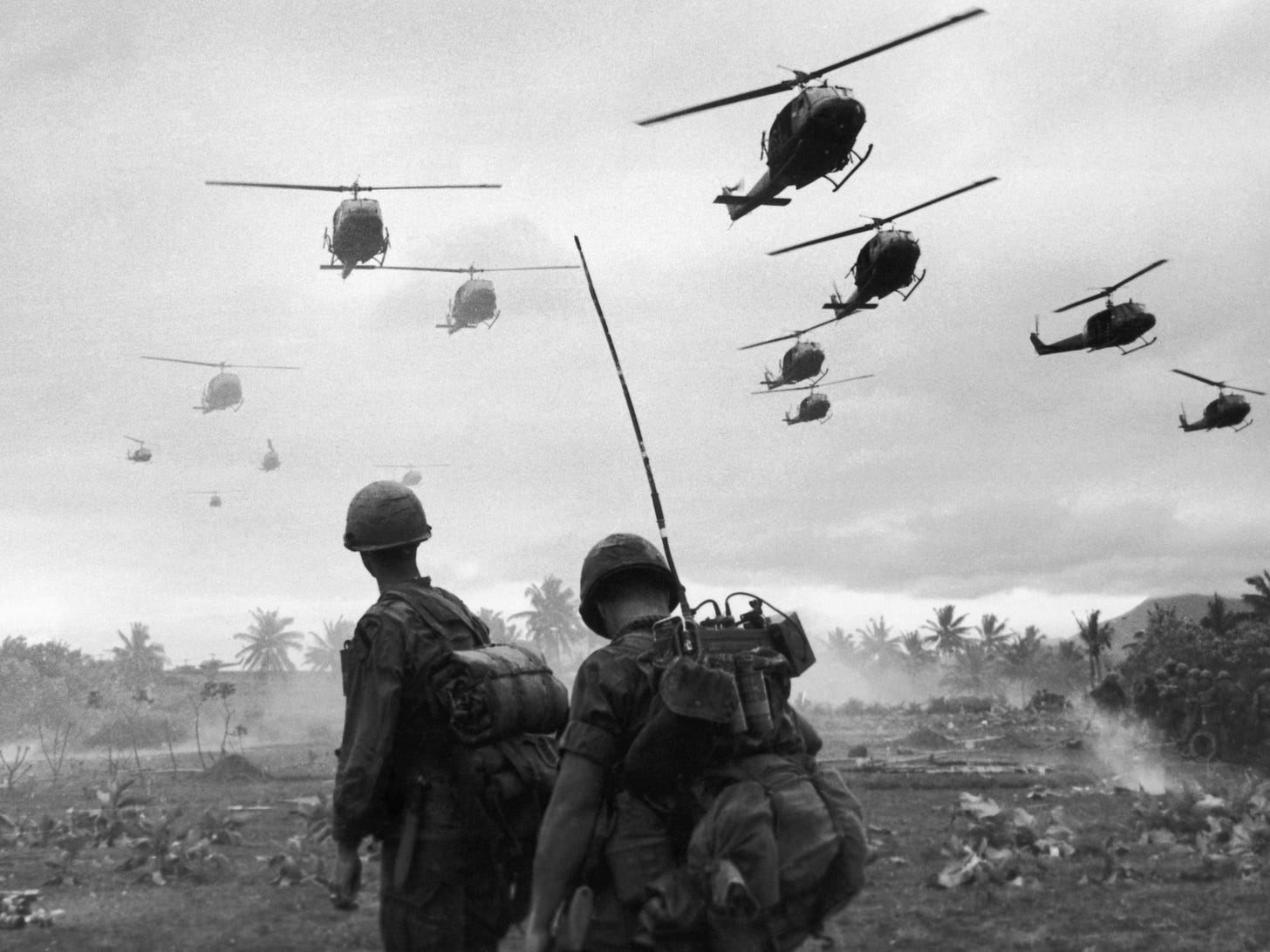
American military supremacy is an article of faith for most Americans, granting the military a strong measure of resistance to the broad decay in the trust that people have in their public institutions. Congress, the president, courts, banks, and tech companies are all lousy and crooked in the eyes of most Americans, but the military, almost uniquely, retains the trust and support of the majority. The prevailing view remains that the American military is the best trained, most technologically advanced, most competently lead, and liberally equipped force in the world. America's colossal defense budget is practically a point of pride.
America is, to be sure, one of the great martial nations of world history. It has generally won conventional conflicts, and won them big. It retains world leading capabilities in many domains, enormous power projection, and it produces exceptional fighting men. Where Americans go wrong, however, is taking this excellence to be a law of nature. An army is not a tiger, dictated by biology to be the largest, fastest, and most powerful predator in the world. It is, rather, an institution which evolves and learns over time, developing particular patterns of war-making which may or may not be well calibrated for particular operating environments.
In the latter half of the 20th Century, during that peculiar security condition that we call the Cold War, the United States Army underwent a roller coaster of institutional change - rapidly demobilizing after the defeat of Germany, coming aghast at its own unpreparedness in Korea, and cannibalizing itself in Vietnam. By 1970, the US Army was in a state of clear crisis, with its own senior leadership increasingly concerned about their ability to win a high intensity land war. From this crisis, however, the American land force began a climb back to the apex, with a radically revamped operational doctrine, new weapons programs, and an invigorated commitment to fighting an American brand of maneuver warfare.
The Menace: Stalin in ManchuriaThe Second World War had a strange sort of symmetry to it, in that it ended much the way it began: namely, with a well-drilled, technically advanced and operationally ambitious army slicing apart an overmatched foe. The beginning of the war, of course, was Germany's rapid annihilation of Poland, which rewrote the book on mechanized operations. The end of the war - or at least, the last major land campaign of the war - was the Soviet Union's equally totalizing and rapid conquest of Manchuria in August 1945.
Manchuria was one of the many forgotten fronts of the war, despite being among the oldest. The Japanese had been kicking around in Manchuria since 1931, consolidating a pseudo-colony and puppet state ostensibly called Manchukuo, which served as a launching pad for more than a decade of Japanese incursions and operations in China. For a brief period, the Asian land front had been a major pivot of world affairs, with the Japanese and the Red Army fighting a series of skirmishes along the Siberian-Manchurian border, and Japan's enormously violent 1937 invasion of China serving as the harbinger of global war. But events had pulled attention and resources in other directions, and in particular the events of 1941, with the outbreak of the cataclysmic Nazi-Soviet War and the Great Pacific War. After a few years as a major geopolitical pivot, Manchuria was relegated to the background and became a lonely, forgotten front of the Japanese Empire.
Until 1945, that is. Among the many topics discussed at the Yalta Conference in the February of that year was the Soviet Union's long-delayed entry into the war against Japan, opening an overland front against Japan's mainland colonies. Although it seems relatively obvious that Japanese defeat was inevitable, given the relentless American advance through the Pacific and the onset of regular strategic bombing of the Japanese home islands, there were concrete reasons why Soviet entry into the war was necessary to hasten Japanese surrender.
More specifically, the Japanese continued to harbor hopes late into the war that the Soviet Union would choose to act as a mediator between Japan and the United States, negotiating a conditional end to war that fell short of total Japanese surrender. Soviet entry into the war against Japan would dash these hopes, and overrunning Japanese colonies in Asia would emphasize to Tokyo that they had nothing left to fight for. Against this backdrop, the Soviet Union spent the summer of 1945 preparing for one final operation, to smash the Japanese in Manchuria.

The Soviet maneuver scheme was tightly choreographed and well conceived - representing in many ways a sort of encore, perfected demonstration of the operational art that had been developed and practiced at such a high cost in Europe. Taking advantage of the fact that Manchuria already represented a sort of salient - bulging as it did into the Soviet Union's borders - the plan of attack called for a series of rapid, motorized thrusts towards a series of rail and transportation hubs in the Japanese rear (from north to south, these were Qiqihar, Harbin, Changchun, and Mukden).
By rapidly bypassing the main Japanese field armies and converging on transit hubs in the rear, the Red Army would effectively isolate all the Japanese armies both from each other and from their lines of communication to the rear, effectively slicing Manchuria into a host of separated pockets.
There were, of course, a host of reasons why the Japanese had no hope of resisting this onslaught. In material terms, the overmatch was laughable. The Soviet force was lavishly equipped and bursting with manpower and equipment - three fronts totaling more than 1.5 million men, 5,000 armored vehicles, and tens of thousands of artillery pieces and rocket launchers.
The Japanese (including Manchurian proxy forces) had a paper strength of perhaps 900,000 men, but the vast majority of this force was unfit for combat. Virtually all of the Japanese army's veteran units and equipment had been steadily transferred to the Pacific in a cannibalizing trickle - a vain attempt to slow the American onslaught. Accordingly, by 1945 the Japanese Kwantung Army had been reduced to a lightly armed and poorly trained conscript force that was suitable only for police actions and counterinsurgency against Chinese partisans.
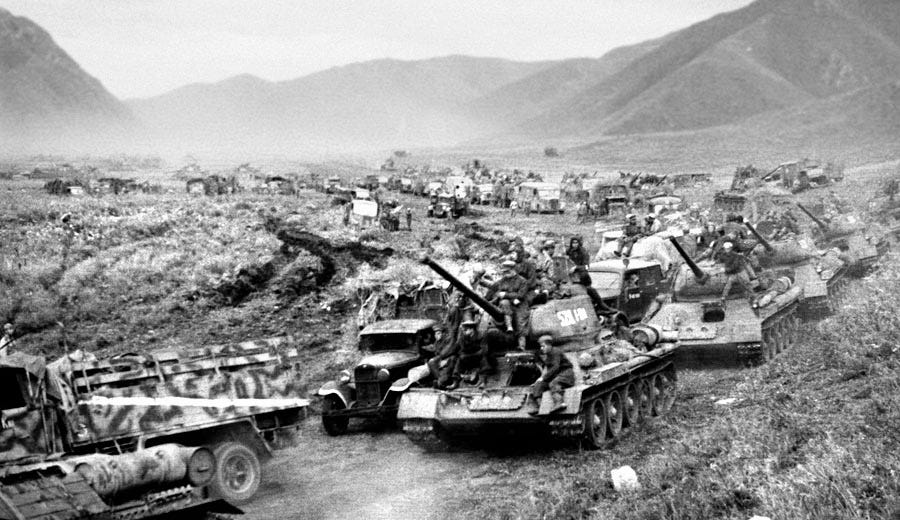
Really, there was nothing for the Japanese to do. The Kwantung Army had far less of a fighting chance in 1945 than the Wehrmacht had in the spring of that year, and everyone knows how that turned out. Unsurprisingly, then, the Soviets broke through everywhere at will when they began the assault on August 9. Soviet armored forces found it trivially easy to overrun Japanese positions (armed primarily with archaic, low caliber antitank weaponry that could not penetrate Soviet armor even at point blank range), and by the end of the first day the Soviet pincers were driving far into the rear.
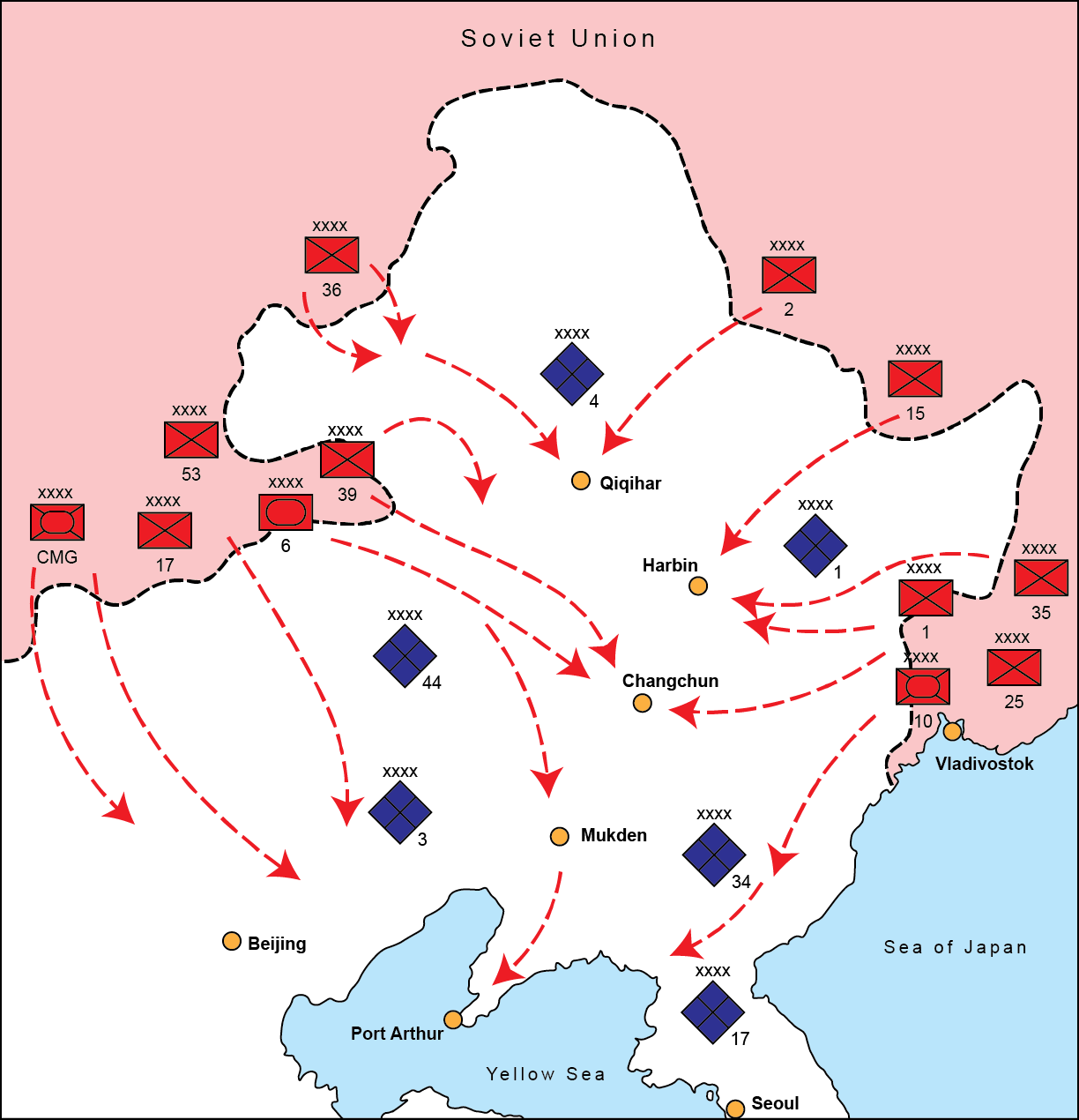
It is easy, in hindsight, to write off the Manchuria campaign as something of a farce: a highly experienced, richly equipped Red Army overrunning and abusing an overmatched and threadbare Japanese force. In many ways, this is an accurate assessment. However, what the offensive demonstrated was the Red Army's extreme proficiency at organizing enormous operations and moving at high speeds. By August 20 (after only 11 days), the Red Army had reached the Korean border and captured all their objectives in the Japanese rear, in effect completely overrunning a theater that was even larger than France. Many of the Soviet spearheads had driven more than three hundred miles in a little over a week.
To be sure, the combat aspects of the operation were farcical, given the totalizing level of Soviet overmatch. Red Army losses were something like 10,000 men - a trivial number for an operation of this scale. What was genuinely impressive - and terrifying to alert observers - was the Red Army's clear demonstration of its capacity to organize operations that were colossal in scale, both in the size of the forces and the distances covered.
More to the point, the Japanese had no prospect of stopping this colossal steel tidal wave, but who did? All the great armies of the world had been bankrupted and shattered by the great filter of the World Wars - the French, the Germans, the British, the Japanese, all gone, all dying. Only the US Army had any prospect of resisting this great red tidal wave, and that force was on the verge of a rapid demobilization following the surrender of Japan. The enormous scale and operational proclivities of the Red Army thus presented the world with an entirely new sort of geostrategic threat.
Soviet forces would begin a formal withdrawal from Manchuria and Korea in 1946, but as they receded they left in their wake consolidated and well supported communist political machines, including the Workers Party of Korea under Chairman Kim Il Sung, and the Communist Party of China under Chairman Mao Zedong. In this regard, Communism showed itself to be a much more geopolitically agile and adaptable ideology than Nazism or Japanese imperialism, as it preached a millenarian, transnational, and ostensibly scientific ideology that could motivate indigenous political parties, and the Soviet government had already developed tried and true institutional mechanisms for mobilizing resources and maintaining a political monopoly. In other words, while Nazism had always clearly been for the Germans and the Germans alone, communism could recruit and galvanize local believers around the world, and the Soviet model could give them the tools to take and hold power.
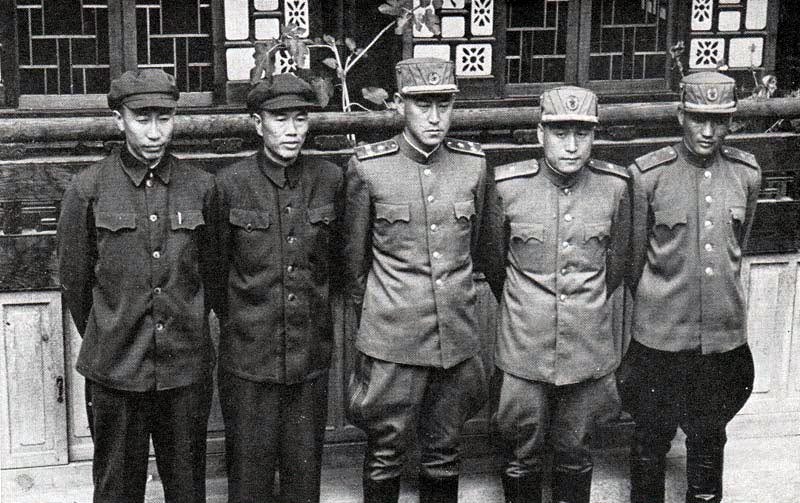
Thus, the Soviet Union presented something of a unique geopolitical triple threat. It had astonishing state capacity in its own right, in its ability to field huge armies and roll them over continent sized spaces; it had ideological penetration and appeal stemming from Communism's universalizing claims and an attractive message of social justice and scientifically ordered abundance; and it had a proven model of effective political institutions which could allow local communist parties to establish powerful political monopolies. Add it all together and you get the great menace of the Cold War: a vast and powerful Red Army that could roll over its enemies with ease, recruit enthusiastic cadres of local communists, and establish durable state structures.
All of these powers had been on full display in Asia, with the lightning advance, the rapid consolidation and funneling of resources to local communist parties, and the durable North Korean and Chinese party-states that were left behind once the Red Army withdrew. To make matters even worse, this powerful Soviet expansion apparatus was now precariously forward deployed deep in the heart of Europe, with the Soviet frontier pushing all the way into Central Germany.
The fear that the Soviet Union would replicate its Manchurian exploits in Europe became the foundational anxiety of the Cold War - predating both Soviet atomic weapons and, by extension, the fear of nuclear war. As early as 1947, France and the United Kingdom began signing joint defense pacts, which expanded to include Belgium and the Netherlands with the 1948 Treaty of Brussels, bringing about the short-lived "Western Union Defense Organization" (WUDO). It was clear, however, that such a limited alliance structure would be utterly inadequate in the event of war with the Soviet Union. France and Britain were degraded, threadbare powers in no place to fight yet another major war. One telegram sent from Field Marshall Bernard Montgomery's staff at WUDO headquarters to a liaison at the American State Department simply said:
Present instructions are to hold the line of the Rhine. Presently available forces might enable me to hold the tip of the Brittany Peninsula for three days. Please advise.
Montgomery himself, though, said it best. Asked what it would take for the Red Army to break through to the Atlantic, he simply answered:
Thinking about the UnthinkableShoes.
The transition from the end of the Second World War to the beginning of that peculiar global security dilemma which we call the Cold War is often poorly understood or even glossed over - obviously, the entire history of the late 1940's is beyond the purview of our interest in the history of maneuver doctrine and operations, but a skeletal recollection may still be useful.
The beginning of the Cold War, as such, can probably be best identified as a sequence of events in 1948 and 1949, which together represented the breakdown of the post-war Soviet-American cooperation in Europe and the consolidation of the power blocs that would characterize the Cold War. In those intervening years after the end of the Second World War, the United States and the Soviet Union undertook a series of actions designed to consolidate their positions in Europe according to the postwar settlement.
These actions took the form of both direct influence and attempts to exclude the other party from the appropriate sphere. The United States, for example, rehabilitated and integrated Western European economies under the Marshall plan while the USSR forbade eastern bloc countries from participating, fearing American economic and political penetration into its satellites. While the USSR reconstituted governments in Eastern Europe into Soviet style communist political monopolies, communists were ejected from governments in France and Italy. There was thus a certain degree of symmetry as both the USSR and the United States consolidated the two spheres of Europe, creating a sharp split down the spine of the continent.
The situation continued to spiral, with the United States intervening in Greece in 1947 to prevent a communist takeover, a 1948 Soviet-backed coup by communists in Czechoslovakia, and the subsequent Soviet abandonment of the Allied Control Council (in effect ending the primary post-war joint body for administration in occupied Germany). The culminating point of all this was an attempted communist putsch in Berlin, followed by the infamous Soviet blockade of the German capital and the Berlin airlift in the winter of 1948. It is not a coincidence that the formation of NATO on April 4 coincided with the closing weeks of the Berlin blockade and the collapse of the Allied Control Council. The formation of a formal American military bloc in Western Europe was the natural culmination of a security situation that had deteriorated with alarming speed. The Soviet Union predictably followed with the Warsaw Pact a few years later. The Cold War was on.
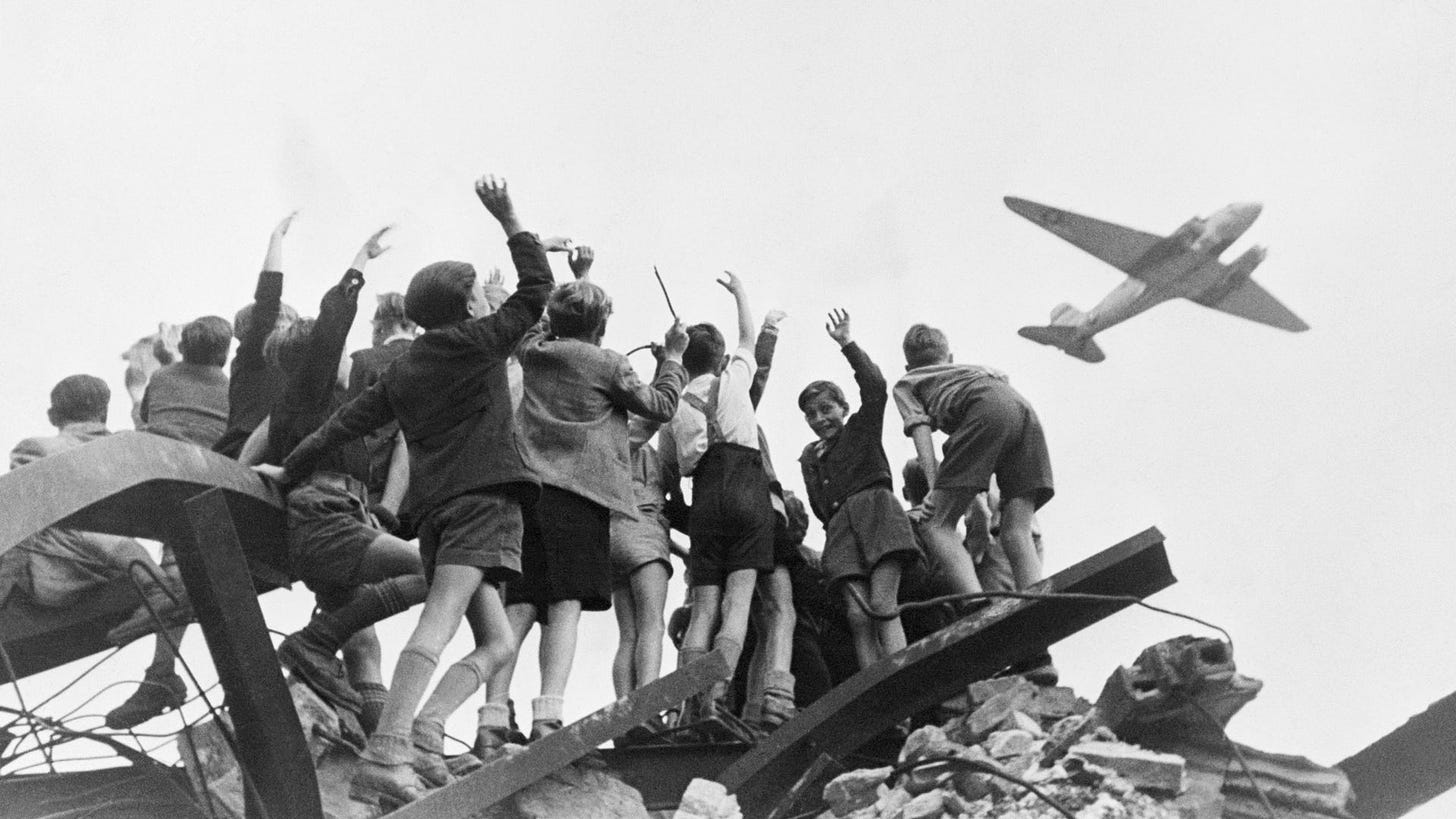
What matters most for our purposes, of course, is not this whirlwind sequence of events or even the breakneck bifurcation of postwar Europe into Soviet and American spheres. What is interesting to us is the fact that the onset of the Cold War presented the United States with a novel problem, namely how to plan for and think about a future war on the European Continent against the Soviet-led forces of the Warsaw Pact. This was, in fact, a very new position for the United States, which for most of its existence had maintained a relatively skeletal officer corps that did not think deeply about operations, or military doctrines at all.
The American Army had always been most unlike its European counterparts, spending most of its life as a border constabulary in the expanding American West. It was certainly nothing like, say, the Prusso-German Officer Corps, which was accustomed over the decades to theorizing, debating, planning, and simulating ad nauseum. While all the major continental armies spent the 1930's thinking deeply about armored warfare and doctrinal concepts, the US Army had no armored force at all, and the simple field regulations issued to officers had nothing to say about the matter. It was not until 1941 (after the German campaigns in Poland, France, and the invasion of the Soviet Union) that the US Army conducted its first ever operations scaled mechanized field maneuvers.
The difference between the pre and post World War Two American security dispositions could not have been more stark, therefore. While the pre-war army thought very little about continental warfare in a systemic or doctrinal way, the US Army in the Cold War was frequently preoccupied with theorizing about a future European war against the Soviet bloc. While prewar America was secure in its latent industrial power and the strategic depth provided by the Atlantic and Pacific Oceans, postwar America remained forward deployed in both hemispheres. Central European lands that had once been the stomping ground of Prussian and French armies now became an American security fixation.
Matters were further complicated by the entirely novel kinetic additive of atomic weapons, which gave frightening new capabilities and an uncertain use case. Throughout the cold war, both the USSR and the USA would be constantly assessing and reassessing both theirs and the other's willingness to use nuclear weaponry, and this in turn fed assumptions about how a ground war in Europe would be fought.
America's atomic monopoly did not last very long in absolute terms, but it nevertheless shaped the base of Cold War military thinking. In the years leading up to the Soviet Union's first successful atomic test in 1949, there were many assumptions made about the security that the west could derive from the American nuclear monopoly (including, most fantastically, Bertrand Russell's call for a preemptive nuclear attack on the Soviet Union). All of these assumptions were shattered by the speed at which the USSR was able to demonstrate its own atomic powers.
Paradoxically, however, the Soviet Union's 1949 atomic test did not ameliorate Soviet insecurities in the short term. This was because, although the test was an important milestone and show of force, the USSR was not able to immediately convert the test into use-ready atomic weaponry. In fact, the Soviet Air Force did not take delivery of operational atomic bombs until 1954. This meant nearly a full decade of acute atomic vulnerability which strongly shaped Soviet strategic sensibilities.
The upshot of all this was that America's atomic monopoly lasted much shorter than the United States had originally hoped and anticipated, but much too long for Moscow's comfort. The security of the early atomic monopoly allowed the United States to rapidly demobilize its armies; simultaneously, the Soviet Union hoped to lean on vastly superior conventional forces as a counterposition to the American nuclear arsenal, and those same gargantuan conventional forces deepened the sense of crippling insecurity in Western Europe.

As previously mentioned, by the late 1940's it was already clear that the limited WUDO alliance (comprised essentially of France, Britain, and the Low Countries) was simply too weak to present a credible opponent to the Soviet Union and the emerging Eastern Bloc. This sense of European insecurity only intensified between 1949 and 1951, with the successful Soviet atomic test, the victory of the communists in China, and the war in Korea. Any earnest attempt to contend with the Red Army would inevitably require the involvement of the United States.
Even with American involvement in European security via NATO (formed in 1949), there were a host of difficult and divisive issues to parse out. In contrast to the Russian perception of NATO as nothing but a tool of American foreign policy, the alliance's early history was wracked with disagreements about how to ensure European security. First and foremost was the question of Germany's role in Europe.
It was quite clear to many, particularly in America, that any credible European alliance would require the rehabilitation and integration of West Germany (formally the Federal Republic of Germany), which was formed in 1949 through the merging of the British and American occupation zones. Even after the trauma of the Second World War and the division of the country, West Germany was by far the most populous and potentially powerful country in Western Europe. It was also, rather obviously, likely to be the critical battleground in any future war with the Soviet Union. Therefore, the Anglo-Americans decided early on that the rehabilitation and rearmament of West Germany was critical for European security. This plan ran into vehement opposition from the French, who remained deeply resentful towards Germany and suspicious of any attempt to rearm them - one particularly bold French proposal even called for German infantry to be inducted into the European commands (in effect, preventing the West Germans from having any organic units higher than a battalion and subordinating them to French divisions).
In the end, it was clear that German manpower and resources would have to be fully leveraged, particularly in light of NATO's preliminary goals of fielding a 50 division army in Western Europe. Therefore, as a sop to the French, the unification and rearmament of Germany was counterweighted by additional American deployments in Europe, as a gesture of America's commitment to European defense and a guarantee that France would not soon find itself dominated once again by the Germans. The integrated NATO military command and preponderance of American influence ensured that German resources could be mobilized without granting West Germany any genuine strategic autonomy. Thus, the basic strategic arrangement of European security was established by the early 1950's, with the first General Secretary of NATO, Lord Hastings Ismay, famously observing that NATO had been structured to "keep the Americans in, the Russians out, and the Germans down." Notably, however, the item about "keeping the Americans in" was viewed not as an American attempt to maintain influence in Europe, but the other way around: Europeans feared being abandoned by the Americans and wanted to ensure an American commitment to European security.
Even with all of this diplomatic and geostrategic horse trading, however, the math of force generation was simply not in NATO's favor. Even with plans to raise 12 German divisions, it was clear that NATO's 1952 decision to field a 50 division force was simply unrealistic - particularly because western leadership was loathe to risk the fragile economic recovery of Western Europe by adopting a crash rearmament program. This was plainly evident to Dwight Eisenhower, with his intimate knowledge of the European theater, and when he became president in 1953 his national security team immediately began to implement a new defense posture that aimed to use atomic weaponry as a substitute for conventional ground forces in Europe.
In the mid 1950's, therefore, NATO's war planning (really, America's) was built around a 30-division ground force which would be tasked with delaying and funneling Soviet forces into concentrated masses which would offer enticing targets for tactical (battlefield) atomic weapons, paired with a policy of so-called "massive retaliation", which promised catastrophic atomic bombing of Soviet rear areas and cities. Eisenhower's Secretary of State, John Foster Dulles, said in a public 1954 speech:
We need allies and collective security. Our purpose is to make these relations more effective, less costly. This can be done by placing more reliance on deterrent power and less dependence on local defensive power... Local defense will always be important. But there is no local defense which alone will contain the mighty land power of the Communist world. Local defenses must be reinforced by the further deterrent of massive retaliatory power.
Perhaps at this point an editorial comment is warranted. Our focus in this (very long) series of articles has been the history of maneuver in warfare. It would seem warranted to ask whether we've lost the plot here, with a very long digression into the early history of NATO and America's nuclear use doctrine. This is fair enough. What we wish to establish, however, is that during the first decades of the Cold War American operational sensibilities were heavily predicated on the inevitability of atomic use, the application of atomic weaponry as a deterrent, and the battlefield uses of atomic weapons.
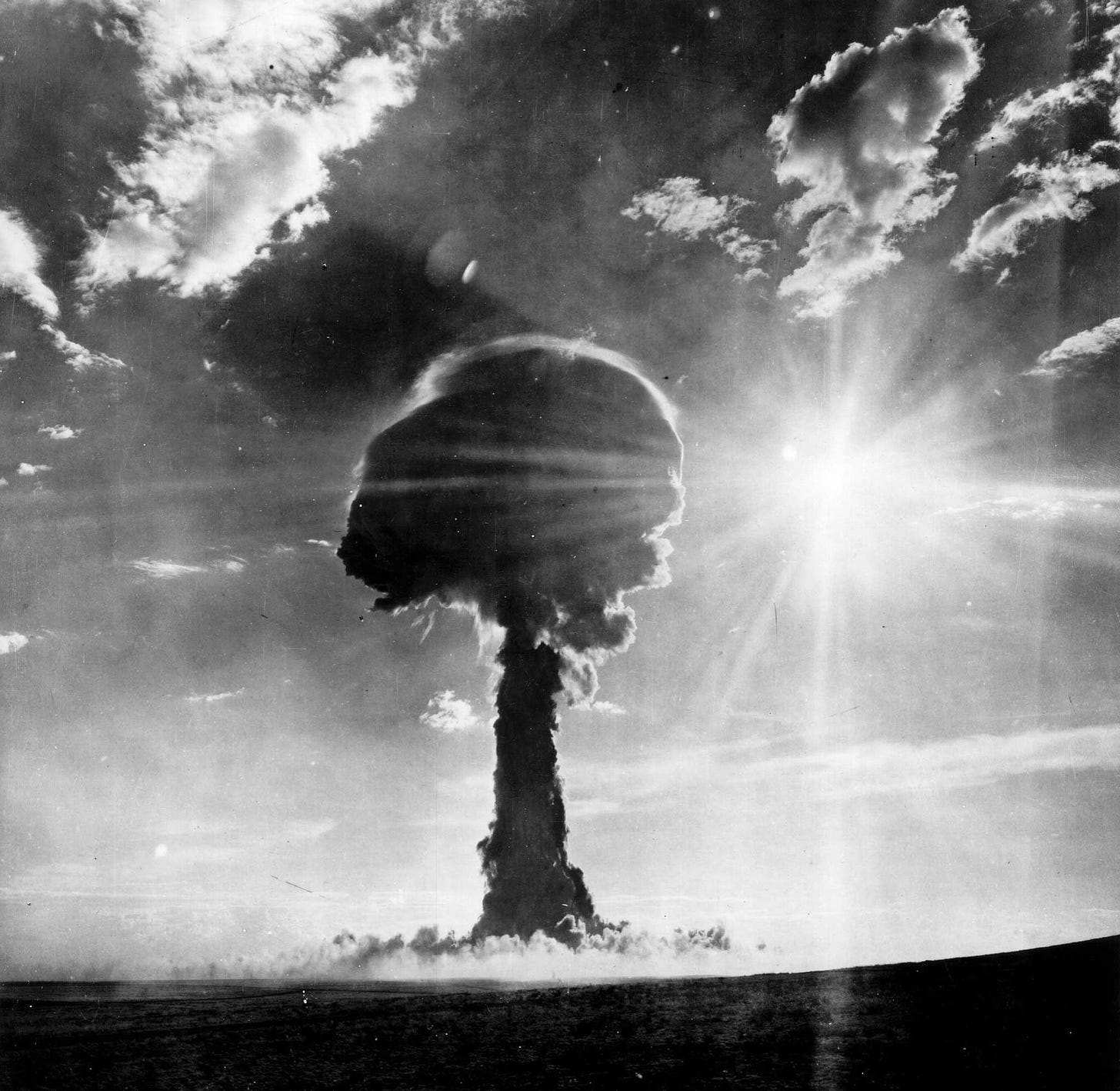
Almost no thought was given to winning a conventional war against the USSR. Louis A Johnson, Secretary of Defense from 1949-1950, was frank in his belief that America had practically no need for non-nuclear forces, and openly mused that the Navy and the Marine Corps out to be abolished outright. In such an environment, little thought was given to conventional operations. By the end of the 1940's, General Omar Bradley was of the opinion that the US Army "could not fight its way out of a paper bag."
This thinking was soon mirrored by the Soviets themselves, particularly with Nikita Kruschchev's 1960 address to the Supreme Soviet in which he proclaimed a new strategy of comprehensive nuclear missile warfare. Under such a framework, there was virtually no distinction between attack and defense - any conventional conflict with the west would be implicitly presumed to go nuclear, therefore the only way to fight such a war was to immediately launch an all-out ground offensive paired with nuclear annihilatory strike. As a 1960 Soviet handbook put it:
Soviet military doctrine sees concerted offensive operations as the only acceptable form of strategic actions in nuclear warfare, and stresses that strategic defense contradicts our view of the character of a future nuclear war and of the present state of the Soviet armed forces… Under modern conditions, passivity at the outset of a war is out of the question, for that would be synonymous with annihilation.
Throughout the 1960's, therefore, the Soviet Union conducted an enormous armaments program which expanded not only their own conventional and nuclear forces, but also the forces of Warsaw Pact satellites, which received over 1,200 new aircraft, 6,000 tanks, and 17,000 armored equipment in the first half of the decade. There was particular emphasis on the base of fire, with Soviet divisions expanding from 8,000 to 12,000 men to increase the size of the organic divisional artillery, and a host of new rocket brigades being provisioned for Warsaw Pact armies.
The culmination of the Soviet "60's program", if we can call it that, was the 1969 Zapad-69. The Red Army simulated a nominal "attack" by NATO, and responded with an all-out offensive by five different army groups, which went punching into West Germany, shooting over the Rhine, south towards the Swiss border, and northward into Denmark. Given the enormous preponderance of Eastern Bloc force generation, Soviet planners concluded (probably realistically) that by the fourth day of the war their spearheads would be well established on the Rhine, and NATO would resort to atomic weapons to avoid total defeat. At that point, the conventional phase of the war would be over and a full nuclear exchange would be underway.
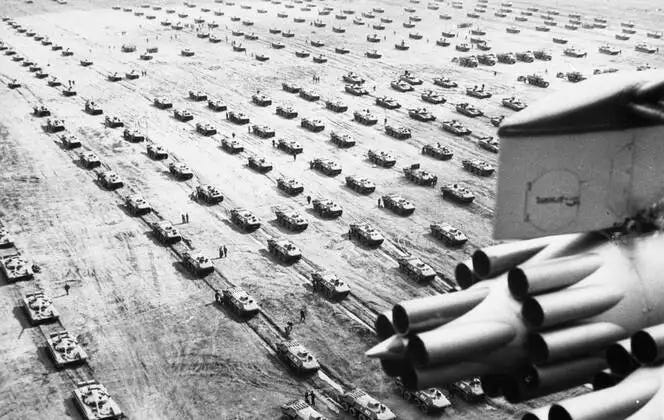
All that is to say, that although both the USSR and the USA followed their own unique paths of strategic development, by the 1960's had come to the assumption that conventional war would lead necessarily to nuclear war. A host of different doctrinal names, like Eisenhower's "massive retaliation" and Khrushchev's "comprehensive nuclear missile warfare" all related essentially to the primacy of nuclear warfare and the growing centrality of escalation management and game theory.
In such an operating environment, there was little role for dynamic thinking about how to fight a conventional war in Europe, particularly for the US Army. Eisenhower rather explicitly viewed US ground forces as little more than a trip wire and a delaying screen that would set the stage for decisive action from the US Strategic Air demand.
Ground forces became so subordinate that the US Army Chief of Staff, General Maxwell Taylor, contrived an entirely new structure for US Army Divisions that would allow them to have organic nuclear weapons systems (an 8-inch howitzer battery equipped with atomic shells and the MGR-1 Honest John Atomic Rocket system). His rational was essentially the institutional survival of the army: nuclear war had become so fundamental to European war scenarios that Taylor believed the Army would have to carve out an atomic role for itself if it wanted to retain its budgetary and personnel access.
A conventional war of mobile operations, in the style of the Second World War, increasingly seemed like an anachronism. Mid-century American conflicts like Korea and Vietnam offered few glimpses into what a peer war in Europe would be like. Korea, after episodic periods of mobility, largely developed into a firepower intensive slugfest amid the mountainous and unfriendly terrain of the peninsula. Vietnam, of course, devolved into an infamous American military headache, but one which seemed to have few parallels to a future war in Europe. Between the focus on atomic weaponry and befuddling Asian misadventures, the world-beating US Army seemed adrift. Then the Israeli Defense Forces recieved a nasty surprise on the Jewish holy day of Yom Kippur.
Revival (in Theory)The Vietnam War as a major socio-political stressor for mid-century America is a well worn and well understood story. Less well known, however, was the way that the war brought the American military establishment to a state that bordered on crisis. Beginning with Lyndon Johnson's decision to fight Vietnam without mobilizing reserves or national guard (instead choosing to lean on the active force and the draft) caused the war to cannibalize and drain the active force. Meanwhile, the financial drain of the war ate away at the defense budget, to the effect that the army fielded no major new systems during the 1960's. Finally, defeat was brushed aside as a manifestation of American political failures and the peculiar nature of fighting a tropic counterinsurgency - the broad conclusion seems to have been that the military did not fail in Vietnam so much as the parameters of the war had failed to accommodate the military.
As a result, the US Army entered the 1970's with aging weapons systems, low institutional confidence, and no real lessons learned. It is not an exaggeration to say that the US Military (and the Army in particular) were at a sort of institutional nadir at this point. This happened to coincide, however, with a renewed interest in thinking about winning a conventional war in Europe, that is to say, without immediate recourse to atomic weaponry, largely due to the growth of Soviet second strike capabilities. In other words, the US Army had a sudden revival of interest in fighting a conventional ground war at exactly the time that it had the lowest capacity to due so.
1 Mar 2024 | 9:15 pm
4. Russo-Ukrainian War: The Deluge
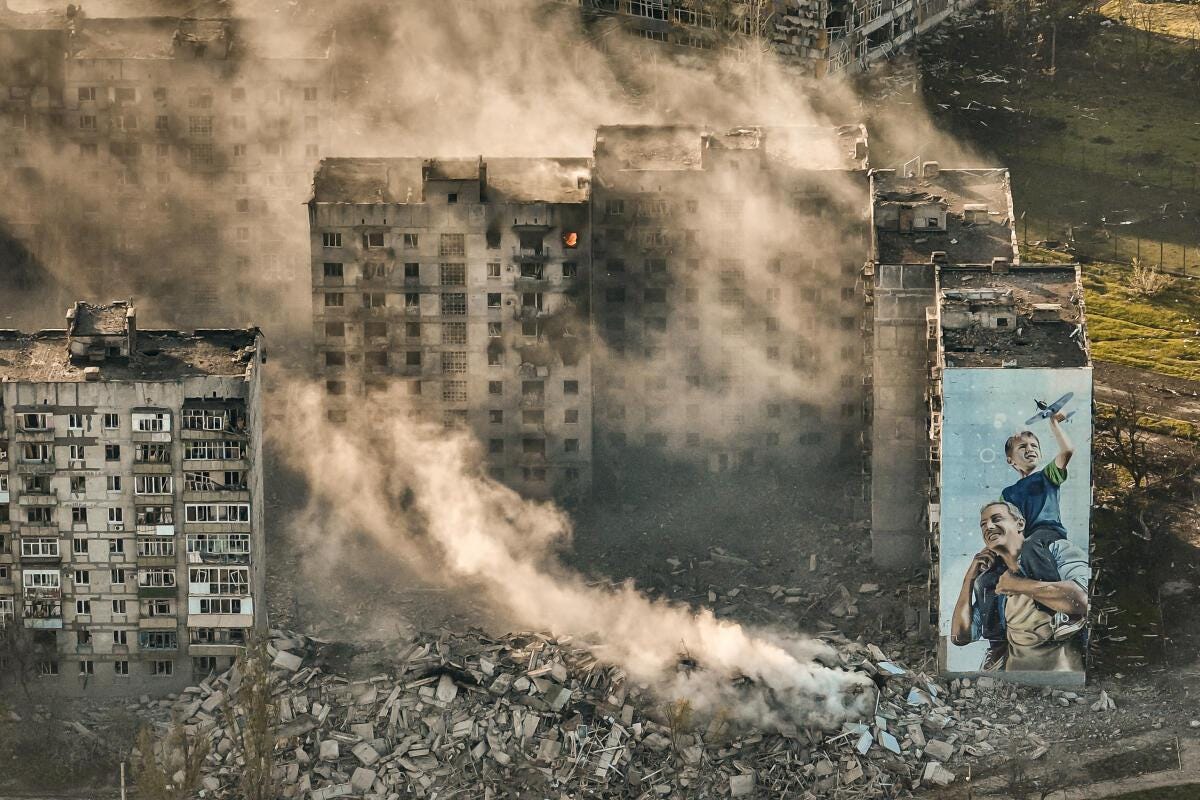
As the calendar barrels into another year and we tick away the days of February, notable anniversaries are marked off in sequence. It is now 2/22/2022 +2: two years since Putin's address on the historic status of the Donetsk and Lugansk regions, followed on 2/24/2022 by the commencement of the Special Military Operation and the spectacular resumption of history.
The nature of the war changed dramatically after a kinetic and mobile opening phase. With the collapse of the negotiation process (whether thanks to Boris Johnson or not), it became clear that the only way out of the conflict would be through the strategic defeat of one party by the other. Thanks to a pipeline of western support (in the form of material, financial aid, and ISR and targeting assistance) which allowed Ukraine to transcend its rapidly evaporating indigenous war economy, it became clear that this would be a war of industrial attrition, rather than rapid maneuver and annihilation. Russia began to mobilize resources for this sort of attritional war in the Autumn of 2022, and since then the war has attained its present quality - that of a firepower intensive but relatively static positional struggle.
The nature of this attritional-positional war lends itself to analytic ambiguity, because it denies the most attractive and obvious signs of victory and defeat in large territorial changes. Instead, a whole host of anecdotal, small scale positional analysis, and foggy data has to suffice, and this can be easily misconstrued or misunderstood. Ukraine's supporters point to nominally small scale advances to support their notion that Russia is suffering cataclysmic casualties to capture small villages. This suggests that Russia is winning meaningless, pyrrhic victories which will lead to its exhaustion, so long as Ukraine receives everything it asks for from the west. At the same time, the Z-sphere points to these same battles as evidence that Ukraine can no longer hold even its most heavily defended fortress cities.
What I intend to argue here is that 2024 will be highly decisive for the war, as the year in which Ukrainian strategic exhaustion begins to show out at the same time that Russia's strategic investments begin to pay off on the battlefield. This is the way of such an attritional conflict, which burdens armies with cumulative and constant stressors in a test of their recuperative powers. Wear and tear and the raging of the waters will erode and burden the dike until it bursts. And then the deluge comes.
Avdiivka: Tactical OvermatchThe signature operational development of 2024 is at this point clearly the complete Russian capture of Avdiivka. The strategic significance of Avdiivka has itself been subject to debate, with some dismissing it as little more than a dingy suburb of Donetsk, targeted to give Putin a symbolic victory on the eve of Russian elections.
In fact, Avdiivka is clearly a locale with great operational significance. A Ukrainian fortress since the beginning of the Donbass War in 2014, Avdiivka served as a keystone blocking position for the AFU on the doorstep of Donetsk, sitting on a major supply corridor. Its capture creates space for Russia to begin a multi-pronged advance on next-phase Ukrainian strongholds like Konstantinivka and Pokrovsk (more on that later) and pushes Ukrainian artillery away from Donetsk.
The subject that would seem to be of particular importance, however, was the manner in which Russia captured Avdiivka. The struggle amid the wreckage of an industrial city provided something of a Rorschach test for the war, with some seeing the battle as yet another application of Russian "meat assaults", overwhelming the AFU defenders with mass amid horrific casualties.
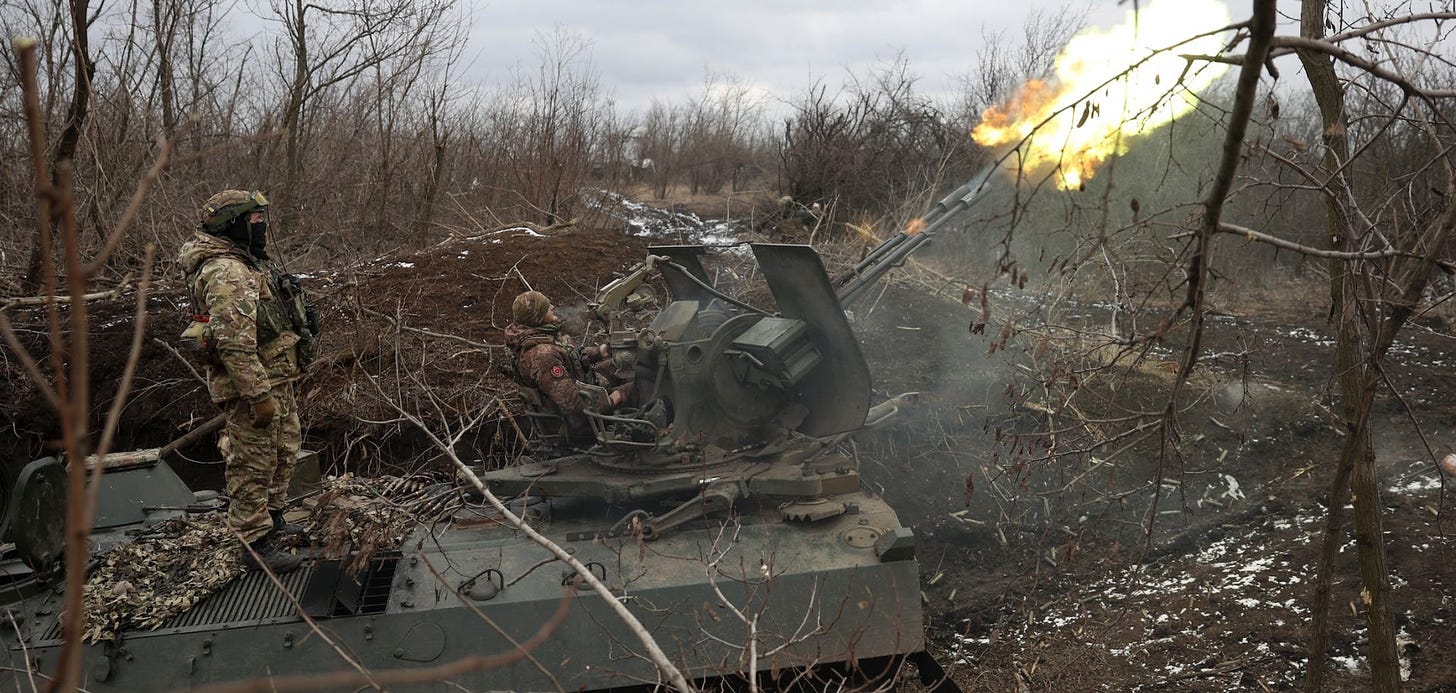
This story does not hold up to scrutiny, as I would like to demonstrate from a variety of angles. First, we can try to gauge casualties. This is always difficult to do with a high degree of accuracy, but it would be useful to look for abnormalities or spikes in Russian loss patterns. The most widely accepted source for this would be the Mediazona casualty tracker (an explicitly anti-Putinist media project operated out of the west).
When one goes to examine the Mediazona counts, an interesting discrepancy manifests itself. The summary text notes that a four-month battle for Avdiivka has recently concluded, and Mediazona states: "We are seeing significant growth of Russian casualties since mid-October." This is actually quite odd, because their data shows the literal opposite. Since October 10 (the day of the first major Russian mechanized assault on Avdiivka), Mediazona has counted an average of 48 Russian casualties per day, which is actually significantly less than the burn rate earlier in the year. In contrast, Mediazona counted 80 casualties per day on average from January 1 to October 9. This period, of course, includes heavy fighting in Bakhmut, so if one takes the period between the end of the Battle of Bakhmut and the beginning of the Battle of Avdiivka (May 20 to October 9) one finds an average of 60 Russian casualties per day. A time series of Mediazona's weekly confirmed casualties also shows a downward trend, making one wonder how they can feel comfortable claiming that the action in Avdiivka has raised the burn rate.
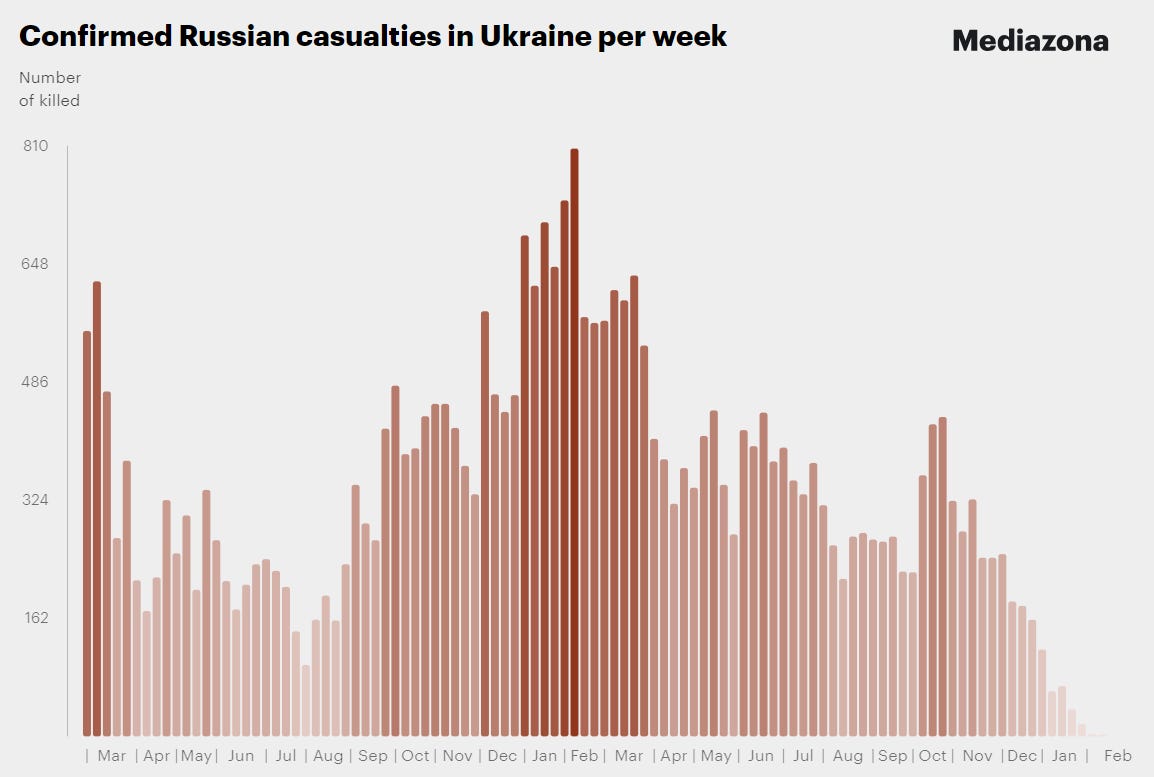
Furthermore, Ukrainian sources on the ground emphasized that the Russian assault in Avdiivka was quite certainly not a mere function of mass, and noted effective Russian small unit tactics with a powerful fire support. One Ukrainian officer told Politico: "That's how they work in Avdiivka — artillery levels everything to the ground, and then professional landing troops come in small groups." Another officer described Russian small unit assaults (5 to 7 men) occurring at night. All of this is inconsistent with the trope about Russian "human wave" assaults - which, we should note, have never been caught on camera. Given the Ukrainian fondness for sharing combat footage, oughtn't we expect to see some alleged evidence of these Russian waves being mowed down?
All this is to say, the claim that Russia (yet again) suffered catastrophic losses in Avdiivka is simply not supported. Like a previous analysis in which I showed that Russian armor losses were not rising or showing abnormal patterns, we yet again have a major Russian assault failing to cause a spike in the loss data. This is not to deny that Russia has suffered casualties. The operation at Avdiivka was a high intensity, four month battle. Men are killed and vehicles are destroyed in such affairs, but there is little evidence that this occurred at abnormal or alarming rates for the Russian Armed Forces.
Now, you're certainly free to make your own judgements, and I have no doubt that the belief in massive Russian casualties and human wave assaults will endure. However, to believe this, you must make an epistemological leap of faith - believing that the wasteful human waves exist despite Ukrainian fighters testifying to the opposite, and that Russian casualties have risen in a way that is somehow invisible to trackers like Warspotting and Mediazona.
In contrast, Avdiivka stands out as the first major engagement of the war where Ukraine's growing material shortages have been acutely felt. After burning through much of their accumulated stock (including the large batch of shells purchased from South Korea by the United States), the AFU felt a glaring and painful artillery shortage in Avdiivka. Complaints about "shell hunger" were a motif of the coverage of the battle. Of course, we've heard about the growing shell shortage for months (and it is known that Ukraine simply does not have enough tubes to cover the entire front), but Avdiivka stands out as a keystone position, important enough for Ukraine to scramble premier assets to reinforce it, where they simply could not provide an adequate base of fire.
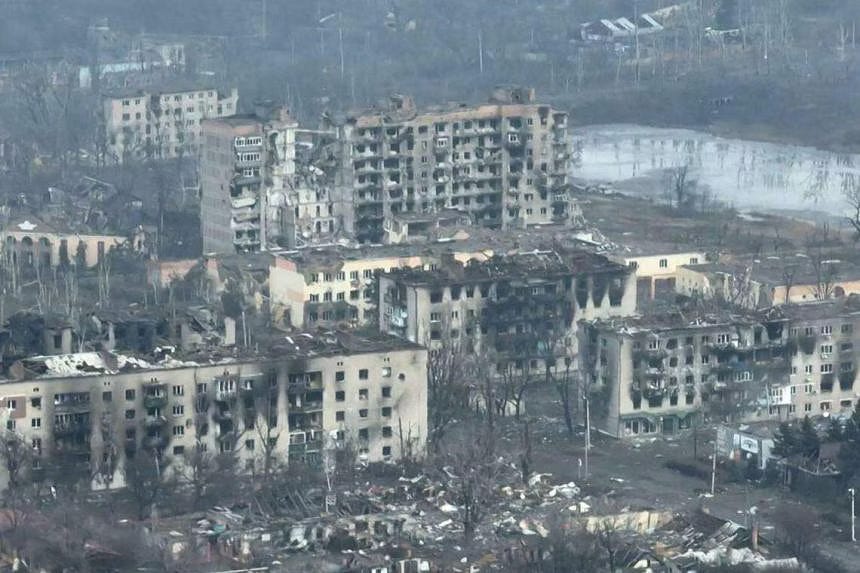
In the absence of adequate artillery, Ukraine has increasingly tried to lean on FPV drones as a substitute. There is a certain strategic logic to this, in that small drones can be manufactured in distributed facilities and do not require the capital intensive production centers (vulnerable to Russian strike systems) that artillery shells do.
However, drones are clearly not a panacea to Ukraine's problems. In the simple technical sense, the destructive power of an FPV drone (which usually carries the warhead of a rocket propelled grenade) pales in comparison to an artillery shell and is thus unsuitable for suppressive fire or the reduction of strongpoints. Drones are also subject to disruptions from weather and electronic warfare in ways that artillery is not. More importantly, however, Ukraine is simply losing the drone race. Ukraine's achievements ramping up drone production in wartime are genuinely impressive, but the country's industrial base is still far smaller and more vulnerable than Russia's, and Russia's drone production is starting to widely outstrip Ukraine's. Ukraine's weakness in other arms prompted them to be the first party to lean heavily on FPVs, but that early lead has been lost.
So, drones clearly offer a lethal and important battlefield expedient, but they are neither a genuine replacement for artillery nor an arm of clear advantage for Ukraine. The result was a Ukrainian defense in Avdiivka that was substantially outgunned. The problem was compounded by the rapid proliferation of Russian air dropped glide bombs, alongside the degradation of Ukraine's air defense. This allowed the Russian air force to operate around Avdiivka with something approaching impunity, dropping hundreds of glide bombs with the power to - unlike artillery shells, let alone tiny FPV warheads - level the fortified concrete blocks that normally make Soviet vintage cities so durable in urban fighting.
Thus, Avdiivka unfolded along a pattern that is now becoming very familiar, and indicates the emerging Russian preference for assaulting cities, at least of this mid-sized fortress variety. Once again the operation focused in its preliminary phase on flaring out Russian control over the flanks, beginning with the large mechanized assault in early November which secured positions on the railway line to the north of the city. Again (as in the case of Bakhmut and Lysychansk-Severodonetsk) there was an expectation among some that Russia would attempt to encircle the city, but this still does not look feasible in the current operating environment under the nexus of fires and ISR. Instead, positions on the flank allowed the Russians to launch concentric attacks into the city, entering on multiple axes that compressed the Ukrainian defenders into a tight interior position, where Russian fire could be heavily concentrated.
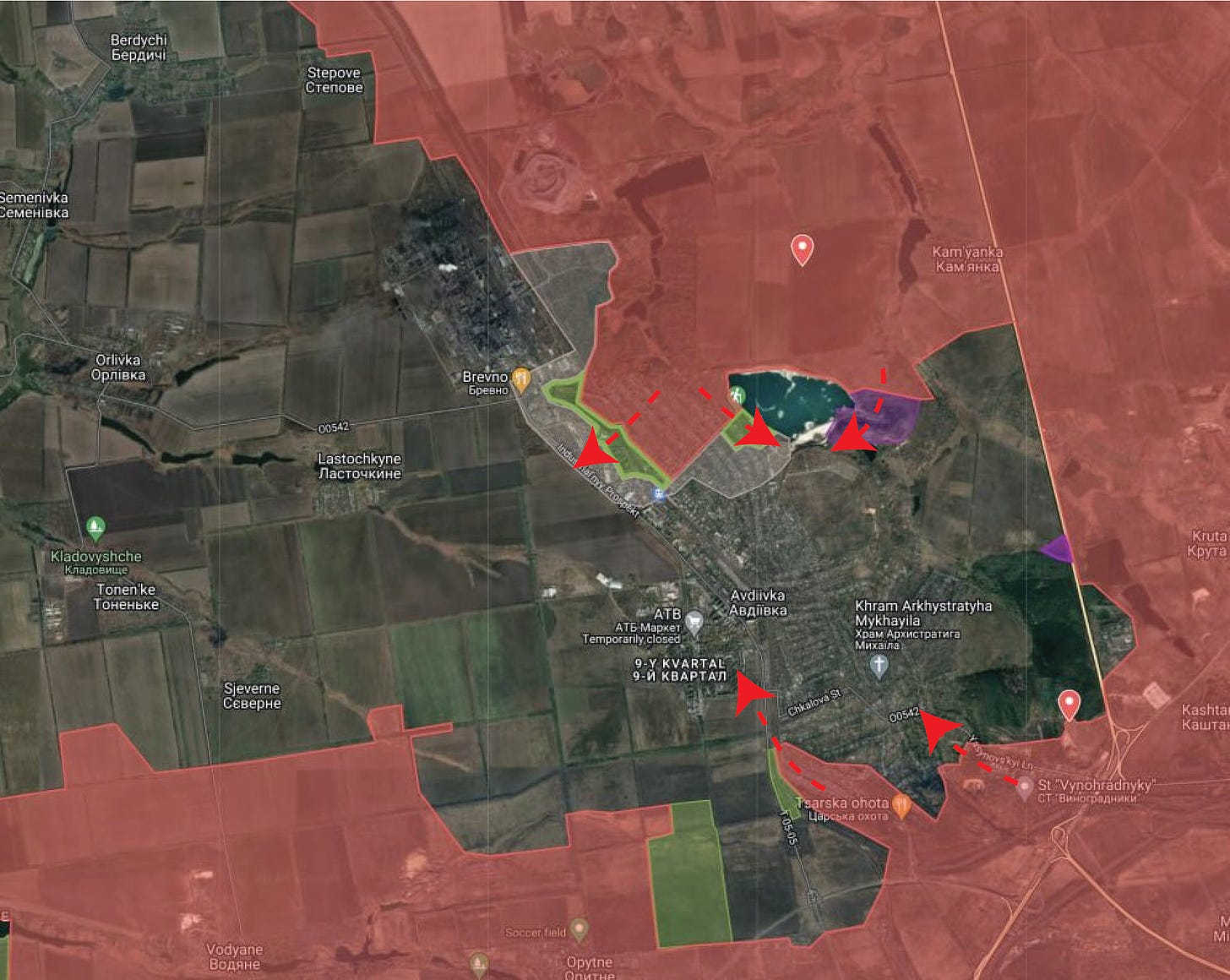
The particular combination of concentric attack and overwhelming Russian fires led to a very rapid end to the battle once the Russian push into the city proper began. While the creep around the flanks occurred in a sequence of on and off pushes through the winter, the concentric crush on the city lasted scarcely more than a week. On February 7-8 the Russians achieved breakthroughs in both the northern and southern suburbs, and by February 14 the Ukrainians were in retreat. A few pockets of resistance would linger for only a few days.
Despite statements alleging that they had conducted an "orderly withdrawal", there is abundant evidence that the Ukrainians were taken aback by the tempo of the Russian assault, and the evacuation was hastily organized and only partially completed. A large number of personnel were unable to escape and are now POWs, and it is clear that Ukraine did not have time or energies to evacuate the wounded, instead ordering that they simply be left behind. The general picture is of a chaotic and ad-hoc retreat from the city, not an orderly and pre-planned withdrawal.
The issue for Ukraine now goes beyond the loss of Avdiivka and the opportunities that this will create for Russia. Ukraine now has proof of failure on both the attack and the defense in operations where they concentrated significant forces. Their counteroffensive on Russia's Zaporhzia Line was a catastrophic failure, wasting much of the AFU's carefully husbanded mechanized package, and now they have a failed defense on their hands in Avdiivka, despite fighting out of a well prepared fortress and scrambling reserves into the sector to reinforce the defense.
The question now becomes fairly simple: if Ukraine failed to attack successfully over the summer, if they could not defend Bakhmut, and if they cannot defend in Avdiivka, is there anywhere that they can find a battlefield success? The dam is leaking. Can Ukraine plug it before it collapses?
Russia's Full Court PressUkraine's force structure is always notoriously difficult to parse out, due to their propensity for ad-hoc battlegroups and their practice of piecemeal allocation of forces to resident brigade commands (turning brigade headquarters into the cups in a shell game). Truth be told, Ukrainian ORBAT and force allocation is in a class all its own - to try and get a handle on it, you can do no better than Matt Davies' excellent work over on X dot com. This generally makes the AFU's organization and force generation more opaque and more difficult to parse out than Russia's, for example. While Russia employs conventional army level groupings, Ukraine does not, and indeed lacks any organic commands above the brigade level.
That being said, the basic picture is one of three Ukrainian "Operational Strategic Groupings", which are vaguely akin to army groups. These are, from north to south, Operation Strategic Groupings (OSGs) Khortytsia, Tavriya, and Odessa. Against these are arrayed four Russian Army Groups - from north to south, these are Army Groups West, Center, East, and Dnieper. Assessing the total line strength is always difficult, largely because we do not always have good insight into the actual combat rating of these units. However, we can make estimates of paper strength. Based on deployment information from the Project Owl Ukraine Control Map and the Militaryland Deployment Map, we can estimate that the nominal strength in the theater right now is some 33 Division Equivalents for Ukraine against perhaps 50 DEs for Russia - a significant, but not utterly overwhelming Russian advantage. We get a picture something like this (Ukrainian Army level formations are absent because they do not exist):
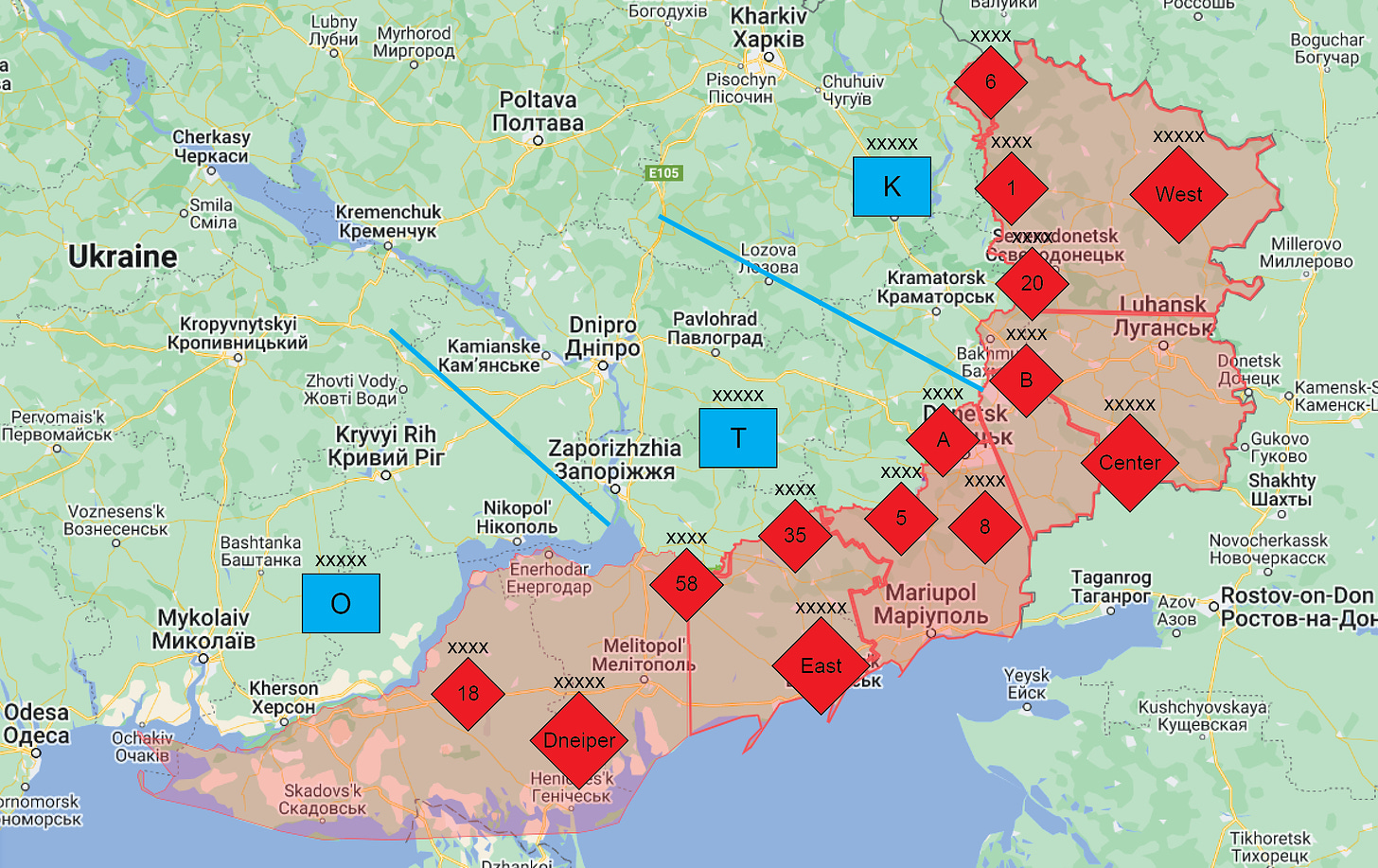
At the moment, Russia is grinding slowly forward on almost every axis in the theater. This has both strategic/attritional implications, in that the Ukrainians are forced to continually burn reserves while being denied the ability to rotate and reconstitute units, but there is also a clear operational formulation occurring.
The Russian maneuver scheme must be held in reference to their minimum end state objectives - namely, the capture of the remaining Donbas urban agglomerations around Slovyansk and Kramatorsk (though we should not assume that the war or Russian ambitions end there). At the moment, there are several major axes of advance, which I am labelling as follows:
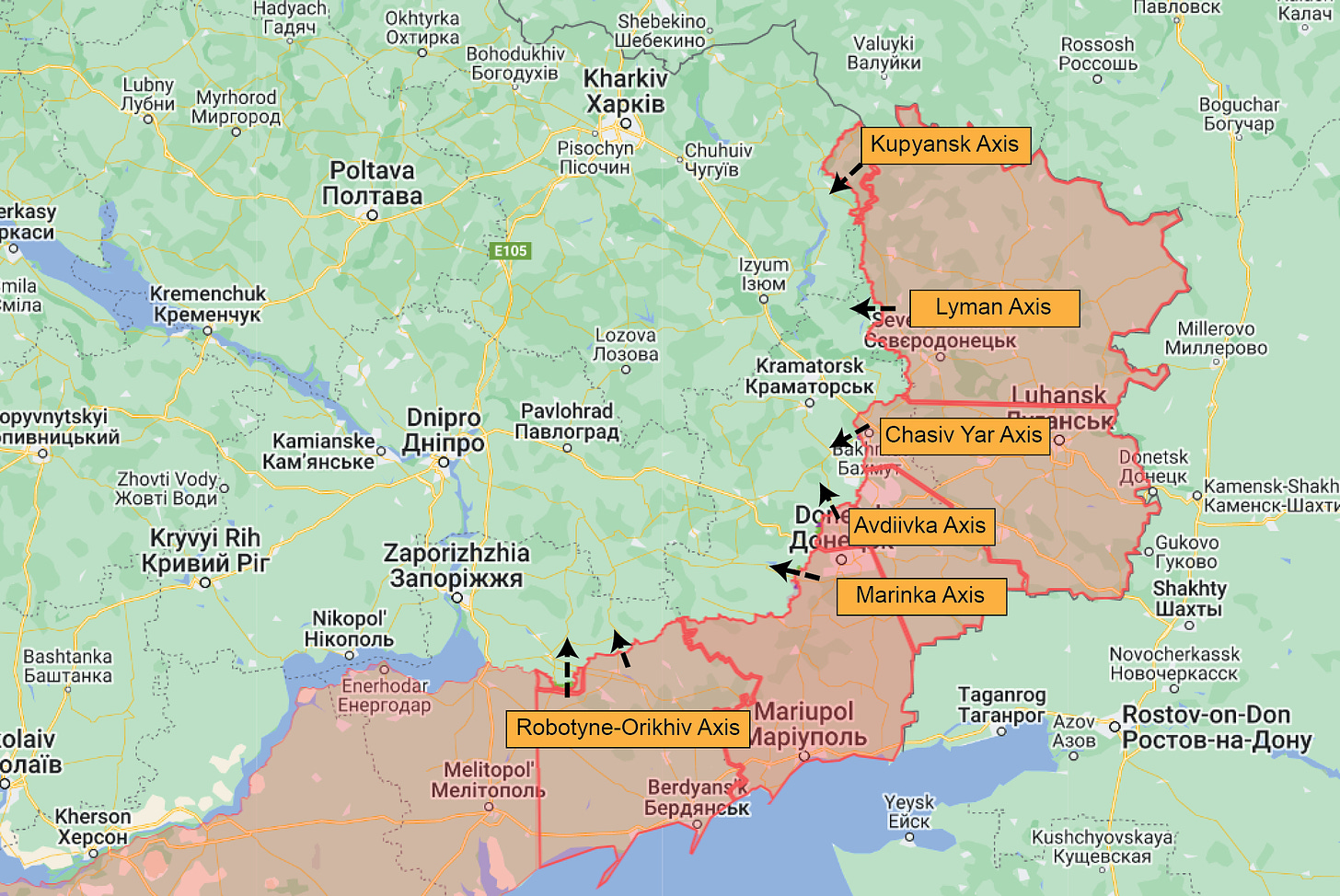
The intention of these thrusts is fairly obvious. In the center of the front, Russian advances on the Avdiivka and Chasiv Yar axes converge on the critical Ukrainian hub of Konstyantinivka, the capture of which is one of the absolute prerequisites for any serious attempt to move on the Kramatorsk agglomeration. Russian bases of control around Avdiivka and Bakhmut provide the necessary space to begin a two-pronged operation towards Konstyantinivka, bypassing and enveloping the strongly held Ukrainian fortress of Toretsk. (See the map below, which I made in December before the capture of Avdiivka).
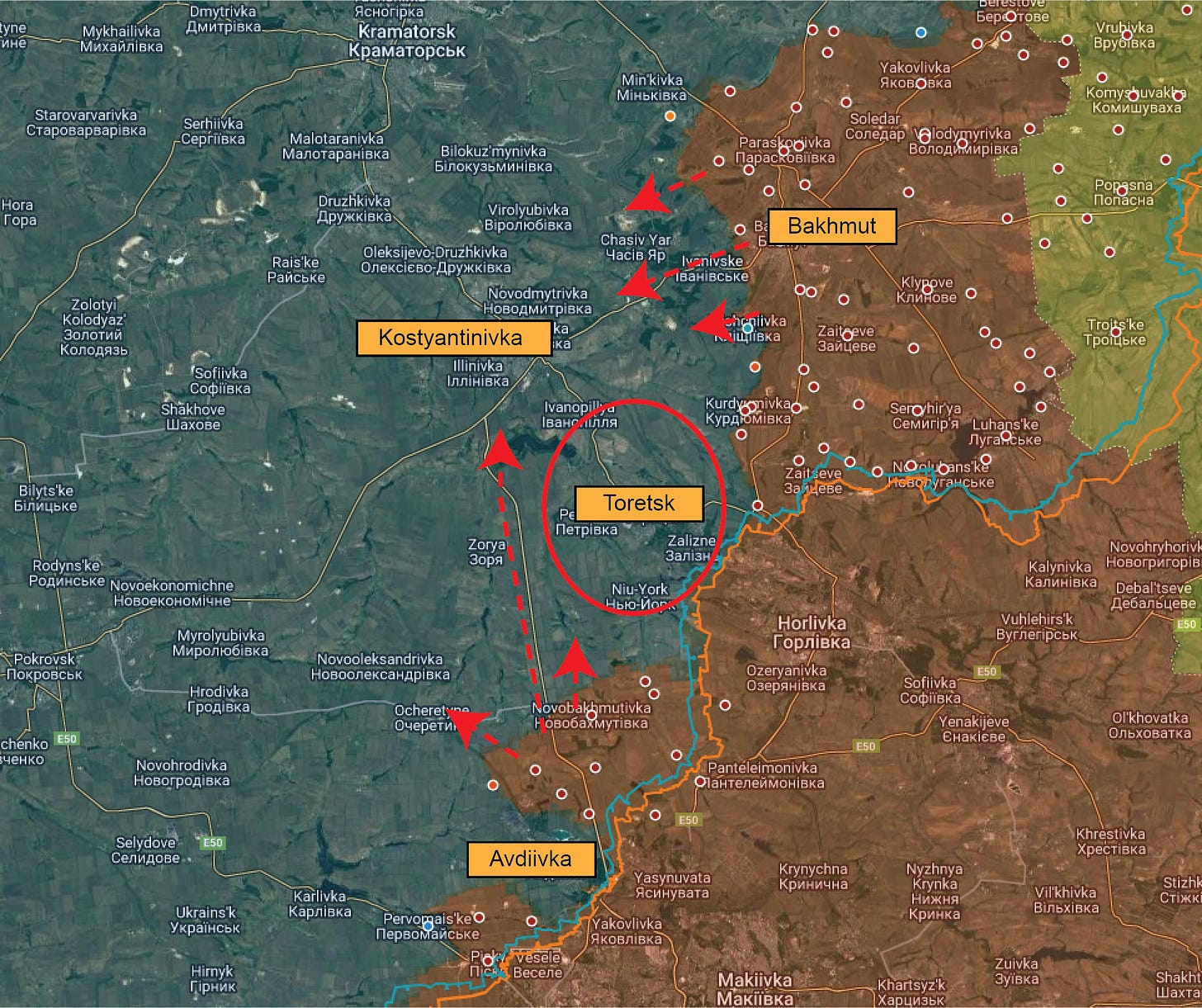
Meanwhile, continued Russian pressure on the northern front (via a slow squeeze on the city of Kupyansk, at the top of the Oskil line as well as operations towards Lyman on the Zherebets axis) provide a base of progress towards the other operational perquisite for Kramatorsk, which is the Russian recapture of the north bank of the Donets River, up to the confluence of the Oskil at Izyum.
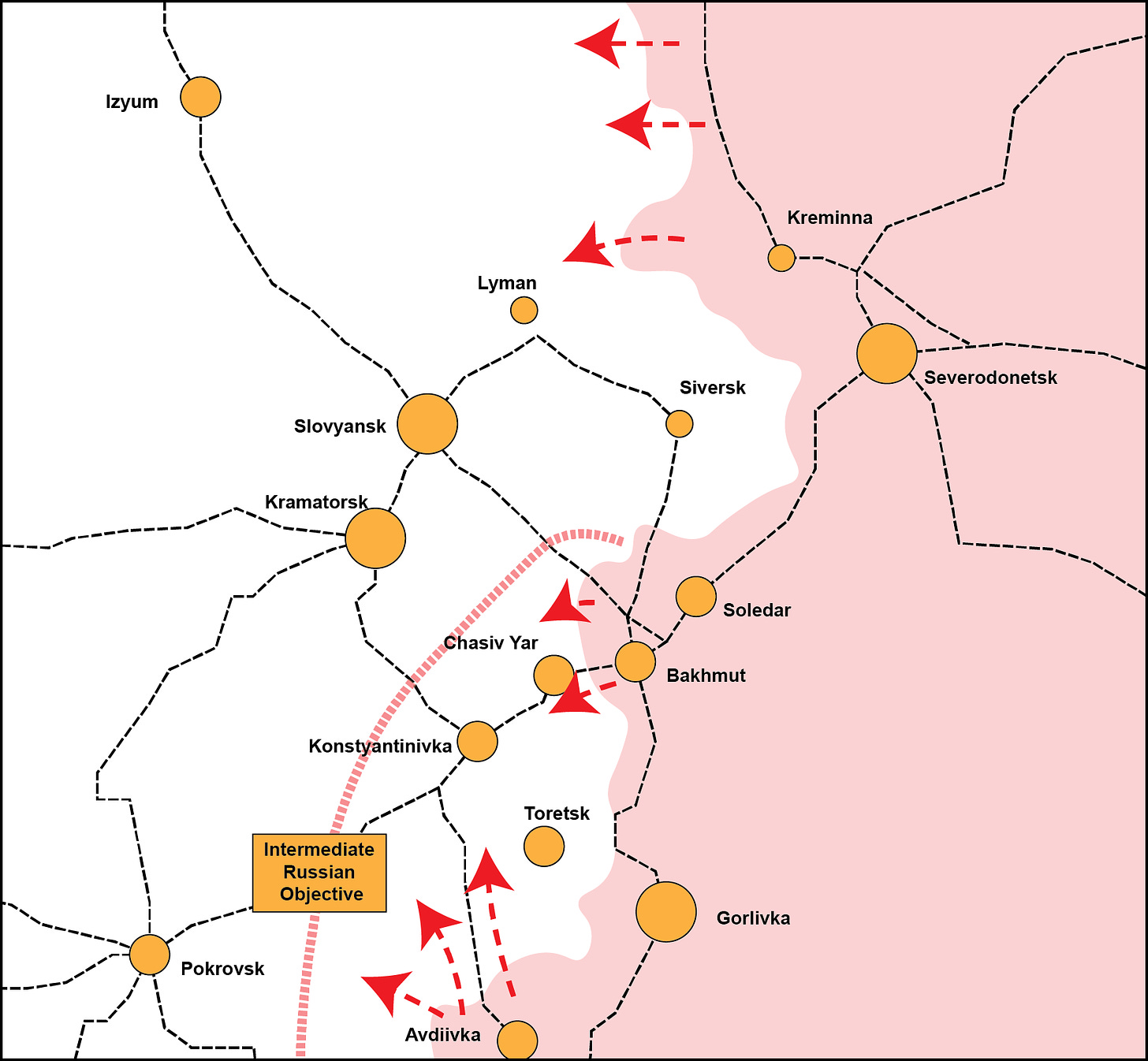
Meanwhile, on the more southerly axes, Russia continues to expand its zone of control after the capture of Marinka, likely with the aim of developing momentum towards Kurakhove, which would put the Ukrainian fortress of Ugledar in a more severe salient. Ugledar remains a thorn in Russia's side, in that it lies uncomfortable close to Russian rail lines into the land bridge. Russia is also attacking the Ukrainian held Robotyne salient (the sparse fruits of Ukraine's counteroffensive). While these attacks have, as we have mentioned, attritional benefits by way of pinning Ukrainian forces in the line, it seems likely that Russia would aim to recapture the Robotyne salient to preempt any Ukrainian designs of using it as a springboard for a future attempt to restart operations towards Tokmak. Thus, these southern operations have both attritive effects and offer the potential of preventatively neutralizing useful Ukrainian staging points.
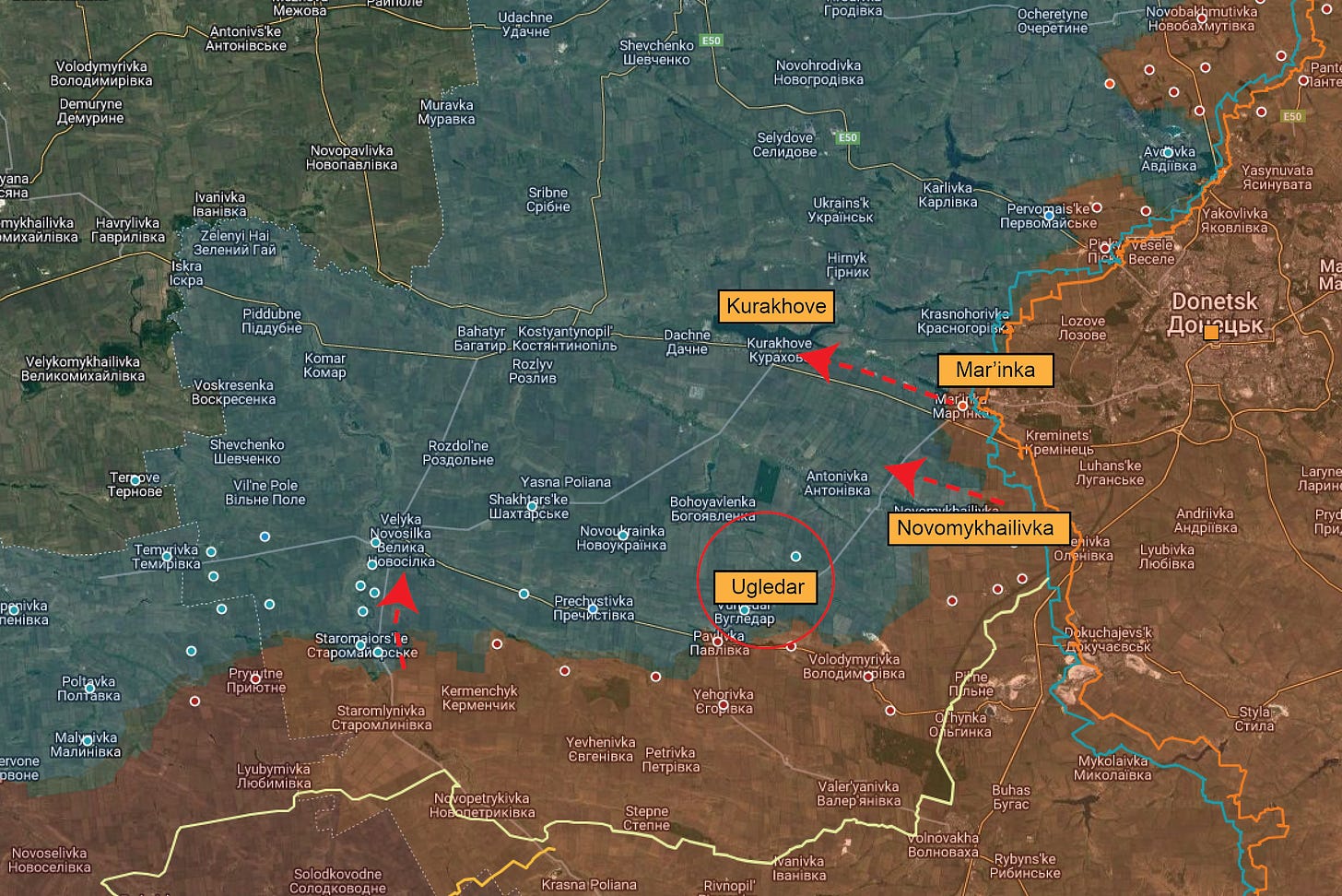
Overall, the broad operational situation suggests that Russia is developing offensive momentum across the entire theater. This will have deleterious effects on Ukrainian combat power by preventing rotation, reconstitution, and lateral troop redeployment, while sucking in the dwindling Ukrainian reserves. Shoigu recently made an uncharacteristically bold statement that the AFU was committing much of its remaining reserves:
""After the collapse of the counteroffensive, the Ukrainian army command has been trying to stabilize the situation at the expense of the remaining reserves and prevent the collapse of the frontline."
This is, if not totally verifiable, at least notable given his general reticence to make sweeping statements about the state of the war.
In the near term (meaning the spring and summer months) we should expect Russia to progress towards the following intermediate operational goals:
Developing a concentric offensive towards the Ukrainian agglomerations around Chasiv Yar, Toretsk, and Kontyantinivka
An offensive along the Zherebets-Oskil line towards Lyman, to capture or screen the Donetsk River line as a prerequisite for an operation against Kramatorsk
Continued assaults towards Kurakhove in preparation for the liqudiation of the Ugledar salient
Preventative attacks towards the Orakhiv axis to prevent future Ukrainian attempts to exploit the Robotyne salient
Against the backdrop of Ukraine's defeat at Avidiivka, President Zelensky began a long expected command overhaul when he fired Commander in Chief Valery Zaluzhny and replaced him the the commander of the ground forces, Oleksandr Syrski.
There a variety of amusing ethnic and political subplots to this, particularly the longstanding tensions between Zelensky and Zaluzhny, the many ridiculous rumors that Zaluzhny had become a political rival to Zelensky and might be the lead figure in a military takeover of the government, and the rather ironic fact that the new top man, Syrski, is a Russian born less than fifty miles outside of Moscow, who ended up in Ukrainian service simply because his unit was posted near Kharkov when the Soviet Union fell, and he opted not to resign his command.
This is all very interesting, of course, and perhaps might help demonstrate that the relationship between these countries is far more convoluted and nuanced that most westerners assume. What matters for our purposes, however, is the military implications.
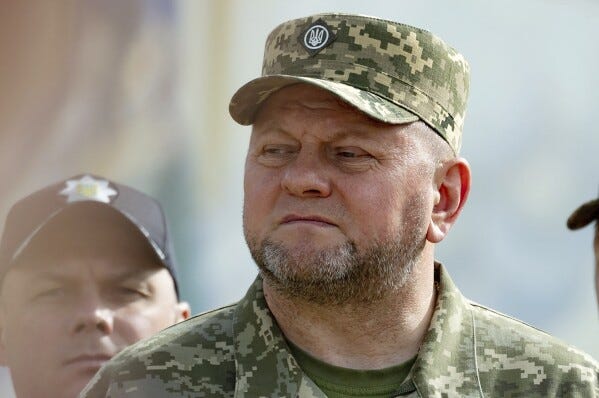
What we should say about Zaluzhny is that, while he was not really Ukraine's biggest problem, he did not have the answers. Zaluzhny displayed a bizarre timidity, particularly throughout the Battle of Bakhmut and the Ukrainian Counteroffensive. We constantly heard about Zaluzhny's reservations and opposition to Ukrainian plans - he was against the costly defense of Bakhmut, skeptical of the attack out of Orikhiv, and so forth. There was even a rumor that Zaluzhny told Zelensky that the counteroffensive had failed already in the opening weeks of the operation.
The problem with all of this is simple: Zaluzhny cannot have it both ways. He seemed to be positioning himself as a voice of caution and reason, distancing himself from operations on the ground, while allowing those operations to go forward anyway. Over the summer, supposedly at the same time that Zaluzhny had concluded that the counteroffensive was failing, he continued to push Ukrainian mechanized forces into the Russian defenses in small, company sized battlegroups.
Ultimately, Zaluzhny strikes one as a non-entity: skeptical of Ukrainian battle plans, but willing to implement them anyway without offering alternatives of his own. In particular, his hesitation led the Ukrainian counteroffensive to devolve into a sequence of wasteful probing attacks which lacked the mass to achieve a decisive result and inevitably spiraled into a slow motion trainwreck. A commander who complains about battleplans while implementing them anyway is begging an obvious question: what is it that you do around here, anyway?
In contrast, Syrski is a man who clearly exerts some will on the battlefield, for good or ill. His preference for commitment and combat has resulted in several of Ukraine's ugliest defeats - he is, after all, the architect of the Bakhmut defense and the firebag at Lysychansk. But he's also the showrunner for Ukraine's signature military success to this point, in the 2022 Kharkov Counteroffensive, where he successfully exploited a badly hollowed out section of Russian front and recaptured important positions over the Oskil.
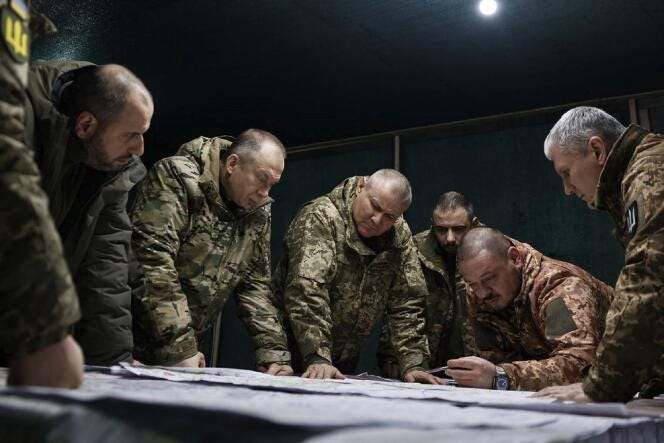
Syrski may very well lead Ukraine to disaster. He has shown a tolerance for casualties that could easily break the AFU's back, and a preference for generating horrible, grinding positional defense. But Syrski at least has a propensity to look for decision points, unlike Zaluzhny, who seemed content to slowly wither away in positional battle against a superior foe. Aggression could easily cause disaster for Ukraine, but time had clearly run out on Zaluzhny's way of war.
Outgunned: Ukraine and the Arms RaceThe Russo-Ukrainian War is one of industrial attrition. Despite a variety of theories about this or that game changing weapon, clever maneuver scheme, or superior western training, the reality of this war for the last 18 months has been one of grinding and laborious industrial war, battering through fixed defenses in a maelstrom of concrete, steel, and high explosives. The central problem for Ukraine is fairly simple: Russian force generation is reaching the liftoff point, which will interminably shift combat power in Russia's favor.
As artillery shells have become the totem item in this war, a commentary on the state of the artillery race is certainly warranted. Ukraine managed to build a large inventory of shells in preparation for its 2023 summer offensive, partially through careful husbanding of resources and partially through the United States tapping a few remaining reservoirs, like South Korea. After expending much of that stockpile in high intensity operations through the summer, the artillery advantage has once again swung heavily in favor of Russia, and "shell hunger" has become a ubiquitous complaint for Kiev.
In particular, Zelensky has recently begun to complain of what he calls an "artificial shortage", blaming the Republican opposition in the US Congress for Ukraine's supply difficulties. Zelensky is wrong. The shortage is real, and not easily fixed.
After burning through excess stocks, Ukraine's long-term supply has increasingly come to hinge on attempts to expand production in Europe and the United States. However, this plan is foundering on three separate rocks: 1) industry has been much slower to ramp up than expected; 2) even the expanded production targets are too low to win the war for Ukraine; and 3) even if adequate ammunition could be procured, Ukraine would quickly run into problems with barrel availability.
Thus far, the United States has been much more successful ramping up production than has Europe. While American targets have been revised several times, it now looks like the United States will produce something like 500,000 shells in 2024, which is a good number given the state of the American industrial plant and issues with labor shortages. The European Union initially hoped to deliver 1 million shells on an annualized basis, but they appear to be far short of this number. Europe faces a variety of problems, like labor shortages, exorbitant energy costs, and a consensus driven decision making culture that is slow to allocate significant resources. The European practice of small orders placed by individual member states also leaves manufacturers hesitant to make large investments in new production lines. Or, as one Belgian general put it: "We're in deep shit."
Let's say that the USA and Europe both fulfill their current targeted deliveries to Ukraine in their entirety. What would that amount to? A recent study from two German analysts at the European Council on Foreign Relations estimated that, in the optimist scenario, the USA and Europe can supply Ukraine with approximately 1.3 million rounds of ammunition on an annualized basis. That would give Ukraine a budget of about 3,600 shells per day - enough to sustain moderate intensity, but far below what they need.
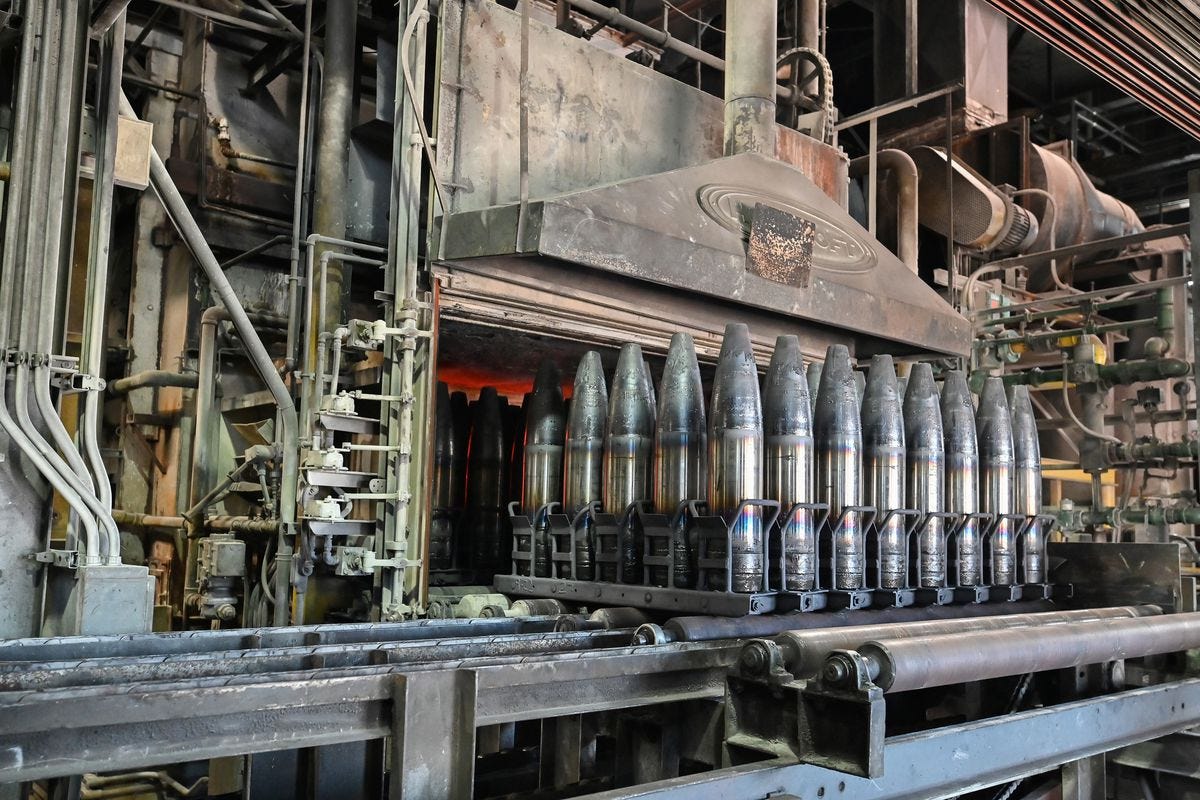
Last year, Ukrainian Minister of Defense Reznikov said that Ukraine would require nearly 12,000 shells per day to "successfully execute battlefield tasks", particularly offensive actions. That works out to more than 350,000 shells per month - more than three times what the NATO bloc is hoping to produce. Obviously that large number is unrealistic, but a recent study from the Estonian Ministry of Defense estimated that at minimum Ukraine will need 200,000 shells per month (Roughly 6,600 per day). At the estimated long-run availability of 3,600 per day, Ukraine can have some basic functionality, but they will find it difficult to accumulate a stockpile to allow higher intensity offensive operations.
This runs into an additional, follow on problem, which is that simply pumping shells into Ukraine is not enough. Solving the shell shortage will exacerbate the barrel shortage. Artillery barrels, needless to say, wear out from extended use. Using a rule of thumb number which says that a howitzer barrel has a lifespan of about 2,500 shots, this means that Ukraine would be wearing out somewhere between 125-150 guns per month, assuming they could actually shoot as much as Reznikov wants. This would create yet another sustainment bottleneck, complicated by the fact that Ukraine has at least 17 different platforms in use.
Meanwhile, what of the Russians? It's clear that Russia's pool of shells has been vastly underestimated. First we have the news that North Korean deliveries have been far larger than initially expected; instead of 1 million, it's something more like 3 million with deliveries ongoing. This number is dampened by the fact that some of the North Korean shells are defective (from long stays in depots and cannibalization), but the sheer size of the delivery can't be ignored. Meanwhile, indigenous Russian production has skyrocketed, with the Estonians estimating some 3.5 million shells produced in 2023 for the Russians, with a figure of 4.5 million expected in 2024. Including North Korean shells, it seems highly likely that Russian can easily sustain a firing rate of up to 12,000 shells per day, with surge capacity in reserve.
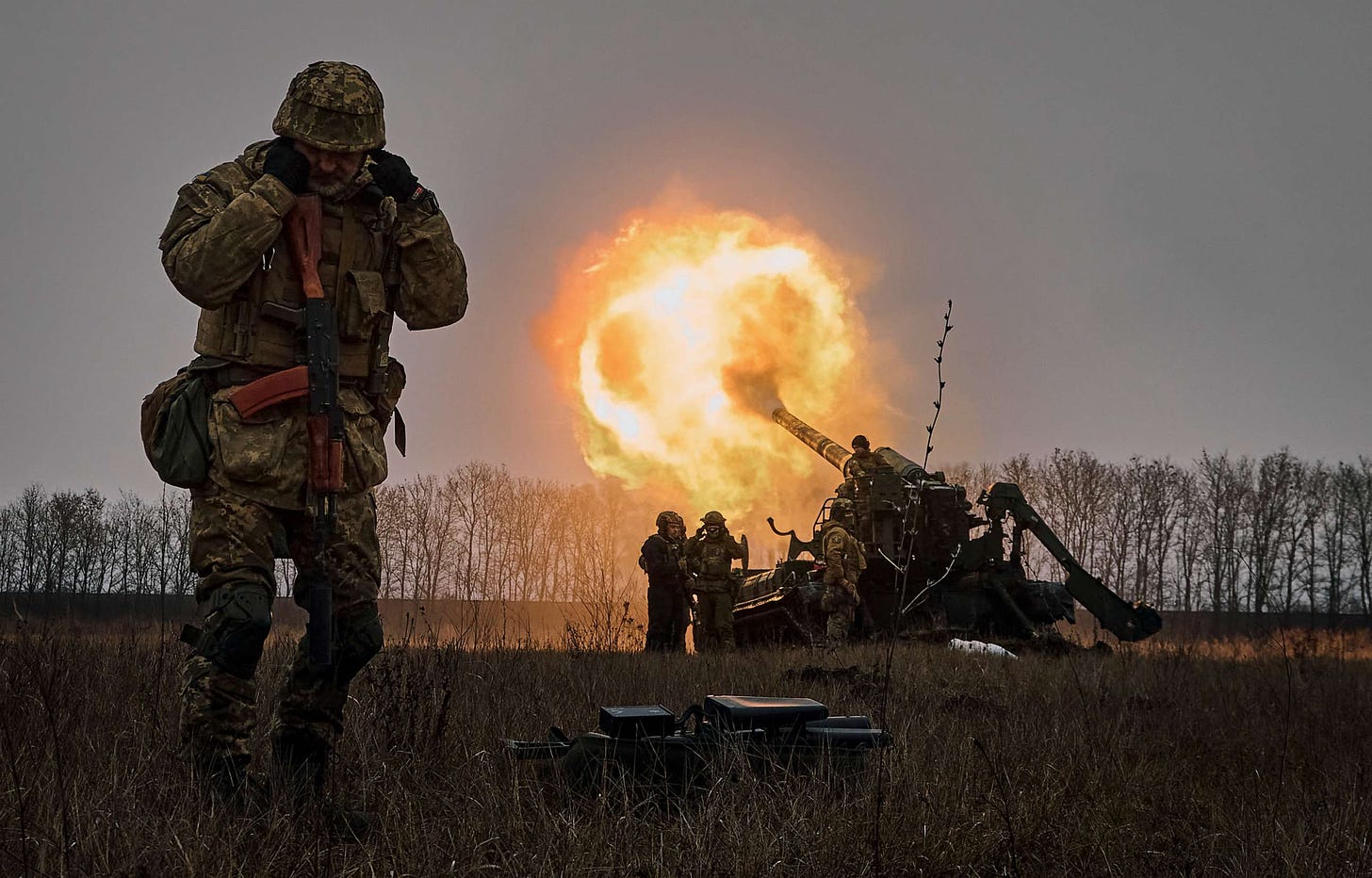
The upshot of all this is essentially that, even if the European production surge occurs on schedule, there's at least a 3-1 advantage (potentially 5-1) in Russian artillery fire that's baked into the calculus of this war, occurring alongside a substantial western acknowledged ramp up in Russian production of strike systems like cruise missiles, Geran drones, Lancets, and glide bombs of both greater power and greater range. A recent publication from the Royal United Services Institute noted that Russia can deliver 1,500 tanks (both new build and retrofitted depot stocks) and 3,000 armored vehicles per year - the report also notes that Russian stocks of Iskander and Kalibr missiles have grown significantly over the last year.
The standard argument - the sort of "Theory of Ukrainian Victory" - rests on the idea of disproportionate, catastrophic Russian casualties, and both sides love to throw around that cherished word "loss ratios." However, this rather tends to obfuscate the issue. The most important question is simple whether an army's relative combat power is growing or shrinking over time - that is, whether its ability to generate forces is greater than its rate of burn - can it reconstitute attrited units in a timely manner, generate replacements, recover, repair, and replace broken equipment, and so forth. The prototypical example of this is of course the Nazi-Soviet War. Despite the fact that the Germans enjoyed favorable "loss ratios" throughout most of the war, the ratio of combat power consistently grew in the USSR's favor due to their vastly superior force generation powers. Tellingly, Hitler even made a quip during the Battle of Kursk that the loss ratios should predict an immanent German victory. But loss ratios do not matter nearly as much as the relative rate of loss and force generation.
Given that Russian casualties are obviously far below the phantasmagorical hundreds of thousands suggested by western Media and Ukrainian propogandists, it has become clear that Russia is generating more force over time. Estonian intelligence estimated that Russia can properly train, equip, and deploy roughly 130,000 additional troops every six months, which is more than adequate to overcome current loss rates. As if to emphasize the point, RUSI notes that the Russian grouping of forces in Ukraine (that is, only those forces deployed in theater at the moment) rose from 360,000 to 470,000 over the last year.
So, Russian force generation is growing over time, and not simply regenerating losses. Meanwhile, Ukrainian forces are increasingly undermanned, with understrength brigades asked to perform increasingly heavy lift. We know that Ukrainian reserves are running low. This was clearly demonstrated in Avdiivka, when the AFU scrambled brigades from other fronts (like the 47th Mechanized) that had been fighting all summer, indicating that there was a lack of adequate strategic reserves, and then throwing in the elite 3rd Assault Brigade in the closing days of the battle to try and stem the bleeding. Meanwhile, formations like the 110th Mechanized, which had been fighting in Avdiivka for months, were essentially burned off entirely because they could not be rotated out. Russia conducts regular troop rotations, while Ukrainian forces remain on the line due to the lack of replacements.
So, here we are. The current Theory of Ukrainian Victory is exhausted, intending as it did to leverage western ISR, training, and surplus equipment to deliver disproportionate casualties on Russia. 2022 was a year of big surges (not Big Serges), with Russia rapidly conquering the land bridge and the Lugansk shoulder in its initial maneuver campaign, followed by Ukrainian capitalization on the inadequate Russian force generation with their audacious counterattack towards the Oskil. But 2023 was different - Ukraine had a significant window of opportunity, flush with western equipment, training, and planning assistance while Russia's mobilization ground into gear. That strategic window yielded nothing. Instead, Ukraine burned off valuable resources defending Bakhmut and then bashed uselessly against a well shaped and well defended Russian line in the south. Now the window is closed, and Russian force generation is inexorably rising, threatening Ukraine with the deluge of total strategic overmatch.
Ukraine is facing strategic defeat, and the only way out is to go all in - not only for Ukraine, in the form of a more radical and totalizing mobilization plan, but for its partners too, who will have to adopt a quasi-war economy and devote radically more resources to arming and training the AFU.
There are signs that Ukraine might be ready to take that plunge, from Zelensky's claim that the army is asking for 500,000 more men, to the ongoing deliberation over an expanded draft, to comments about the need for "total mobilization" and laws against capital flight (to prevent men from fleeing the country with their money). This is only natural; due to Russia's vastly superior resource base, Ukraine can only hope to match them with a totalizing and far more extractive mobilization policy.
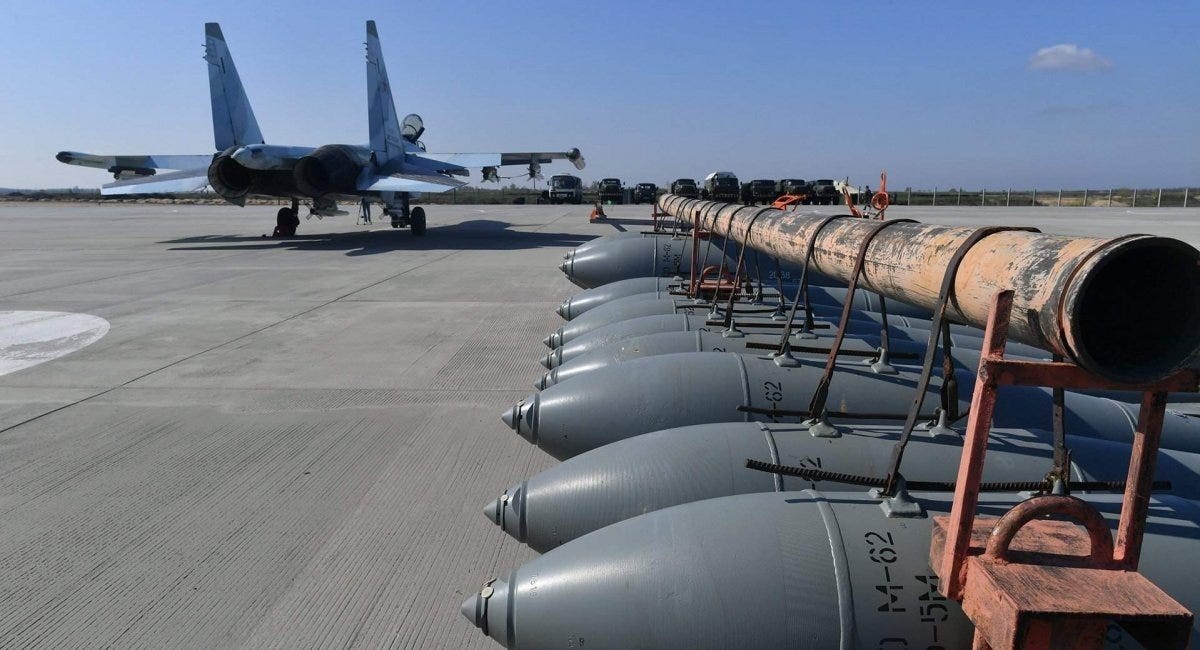
That leaves the NATO partners. Even if Ukraine adopts a radical mobilization policy, it lacks the indigenous capacity to train them, let alone arm them. Without the NATO training pipeline and robust material support, a Ukrainian total mobilization (even if it were possible with Ukraine's limited state capacity) would serve only to inflate casualties and burn off what is left of the nation's demographic base. With even a stable level of Ukraine aid struggling to get through an American congress that is suffering from Ukraine fatigue and a host of domestic crises, it seems unlikely that any by the Baltic States are in the mood to double down and begin sending daily trains full of material to Kiev.
And so, we once again return to the motif of strategic exhaustion. 2022 was the year of wild swings as the front stabilized into a conveniently shaped and easily supplied Russian position, and 2023 was the year of Ukraine's strategic window of opportunity, frittered away at Bakhmut and Robotyne. 2024 is the year that Russia's swelling force generation reaches a climax and the war turns in an obvious and irreversible way against Ukraine.
The great German soldier and author Ernst Jünger had the following comment on the prospect of war with Russia:
When Spengler warned against any invasion of Russia for reasons of space, he was, as we have since seen, right. Even more questionable become each of these invasions for metaphysical reasons, insofar as one approaches one of the great sufferers, a titan, a genius of suffering power. In its aura, in its sphere of influence, one will become acquainted with pain in a way that far exceeds any imagination.
Much is always made of Russia's propensity for "suffering", with interpretations ranging from a romantic Russian-patriotic notion of sacrifice for the motherland to an anti-Russian criticism of the Russian tolerance for casualties. Perhaps it means both: the individual Russian soldier is more willing to sit in a freezing trench and trade shells than his adversary, and the Russian state and people are able to lose more and last longer in the aggregate.
I rather think, however, that Jünger's metaphysical "titan of suffering" is not so metaphysical at all. It rather refers to a mundane power of the Russian state, namely its excellence and willingness across the centuries to mobilize huge numbers of men and material for war, at the expense of other social goals. War with Russia sucks. It means mass casualties, cold trenches, scarred earth, and long nights of shelling. The Ukrainians have coped with this as well as anyone (because they are themselves quasi-Russian, however much they deny it), but it is an awful thing to trade shells for years on end. The Russian power of suffering is to willingly fight wars that devolve into bat fights, knowing they have a bigger bat.
The window of strategic opportunity has closed for Ukraine, and now opens wide for Russia. The earth opens wide for the dead.
13 Feb 2024 | 11:28 pm
5. The Age of Zugzwang
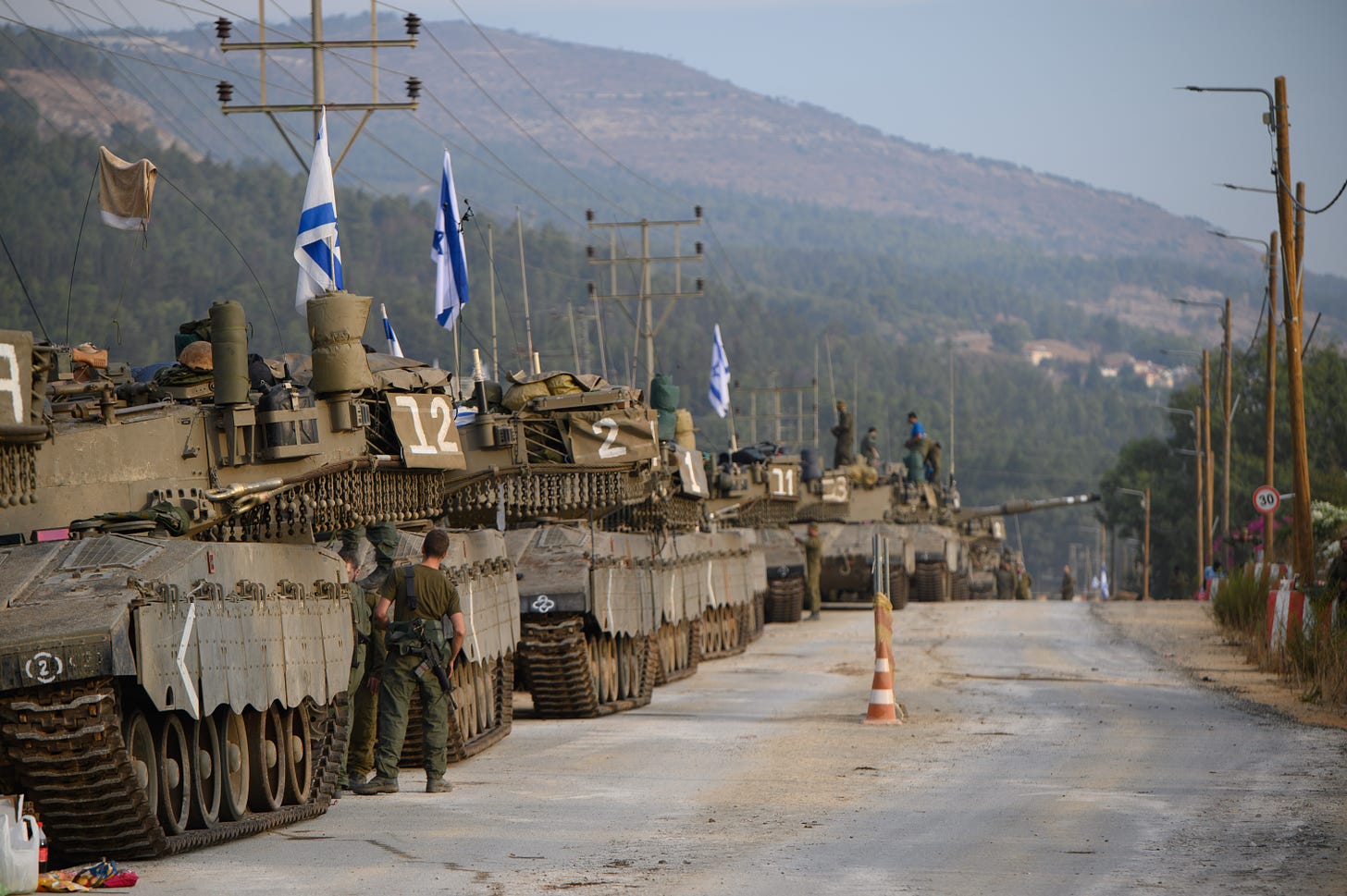
Note: I apologize in advance for the potentially rambling nature of this piece, which is something of a stream of consciousness geostrategic meditation. It's possible that this is too abstract to be interesting. If so, please berate me in the comments.
I am a great lover of chess. While no more than a middling player myself, I am endlessly entertained by the seemingly countless variations and strategic contrivances that the world's great players can create from that same, familiar beginning. Despite being an old game (the rules that we know today emerged in 15th Century Europe), it has resisted the enormous amount of computing power thrown at it in recent years. Even with powerful modern chess engines, it remains an "unsolved" game, open to experimentation and further study and contemplation.
One chess adage, which I learned early at my childhood chess club, is that one of the biggest advantages in chess is to have the next move - a sort of cautionary lesson to avoid being overly cocky before your opponent has a chance to respond. A little down the road, however, you learn about a concept that inverts and perverts this aphorism: something which we call Zugzwang.
Zugzwang (a German word that literally means "move compulsion") refers to any situation in chess where a player is forced to make a move that weakens his position, such as a king that is backed into a corner to escape from check - each time he moves out of check, he moves himself closer to checkmate. More simply put, Zugzwang refers to a situation where there are no good moves available, but it is your turn. If you find yourself staring at the board, thinking that you would prefer to simply skip your turn, you are in Zugzwang. But of course, you cannot skip your turn. You have to move. And no matter what move you choose, your position gets worse.
This idea of having no good options while being compelled to act has become a motif in the enfolding era of geopolitical flux. Actors around the globe find themselves in situations where they are compelled to act in the absence of good solutions. Zbigniew Brzezinski famously wrote of geopolitics as analogous to a chessboard. If that is indeed the case, there now comes a time for choosing which pieces to save.
JerusalemIt is almost impossible to find a dispassionate analysis of the Israeli-Arab conflict, simply because it sits directly upon a concatenation of ethno-religious fault lines. Palestinians are the object of concern for many of the world's nearly two billion Muslims, particularly in the Arab world, who tend to view Gaza's suffering and humiliation as their own. Israel, on the other hand, is a subject of rare agreement between American evangelicals (who believe that the nation state of Israel has relevance to Armageddon and the fate of Christianity) and the more secular American governing blob, which treats Israel as an American outpost in the Levant. To this, we can add the emerging religion of anti-colonialism, which views Palestine as something like the next great liberation project, akin to ending apartheid in South Africa or Ghandi's campaign for Indian independence.
My goal is not to convince any of the aforementioned people that their views are wrong, per se. Instead, I would like to argue that, despite these many powerful emotional-religious currents, much of the Israeli-Arab conflict can be understood in fairly mundane geopolitical terms. Despite the enormous psychological stakes that billions of people have in the subject matter, it still unfolds itself to a relatively dispassionate analysis.
The root of the problems lay in the peculiar nature of the Israeli state. Israel is not a normal country. By this, I mean neither that it is a special, providential country (as an American evangelical might say), nor that it is a uniquely wicked root of all evil. Rather, it is extraordinary in two important ways that relate to its function and geopolitical calculus, rather than its moral content.
First, Israel is an Eschatological Garrison State. This is a particular form of state which perceives itself as a sort of redoubt against the end of all things, and accordingly becomes highly militarized and highly willing to dispense military force. Israel is not the only such state to have existed in history, but it is the only obvious one extant today.
A historical comparison may help explain. In 1453, when the Ottoman Empire at last overran Constantinople and brought an end to the millennia-old Roman imperium, early medieval Russia found itself in a unique position. With the fall of the Byzantines (and the previous schism with western papal Christianity), Russia was now the only Orthodox Christian power remaining in the world. This fact created a sense of world-historic religious siege. Surrounded on all sides by Islam, Roman Catholicism, and Turko-Mongol Khanates, Russia became a prototypical Eschatological Garrison State, with a high degree of cooperation between Church and State and an extraordinary level of military mobilization. The character of the Russian state was indelibly formed by this sense of being besieged, of being the last redoubt of authentic Christianity, and the consequent need to extract a high volume of manpower and taxes to defend the garrison state.
Israel is much the same, though its sense of eschatological terror is of a more ethno-religious sort. Israel is the only Jewish state in the world, founded in the shadow of Auschwitz, besieged on all sides by states with which it has fought several wars. Whether this justifies the kinetic aspects of Israeli foreign policy is not the point. The simple fact is that this is Israel's innate self conception. It is an eschatological redoubt for a Jewish population that sees itself as having nowhere else to go. If one refuses to acknowledge the central Israeli geopolitical premise - that they would do anything to avoid a return to Auschwitz - one will never make sense of their actions.
However, the Eschatological-Garrison nature of the state is not the only way in which Israel is abnormal. It is also quite unusual in that it is a Settler-Colonial State in the 21st century. Israel maintains hundreds of settlements in soft-annexed territories like the West Bank, which are home to half a million Jews. These settlements constitute an effort to demographically strangulate and assimilate Palestinian lands, and cannot be described as anything other than settler-colonialism. Again, all sorts of religious arguments will fly as to whether this is justified or not, but the reality that all must acknowledge is that this is not normal. Denmark does not have colonies. There are no Danish villages being built in Northern Germany to extend Danish rule. Brazil does not have colonies. Neither does Vietnam, or Angola, or Japan. But Israel does.
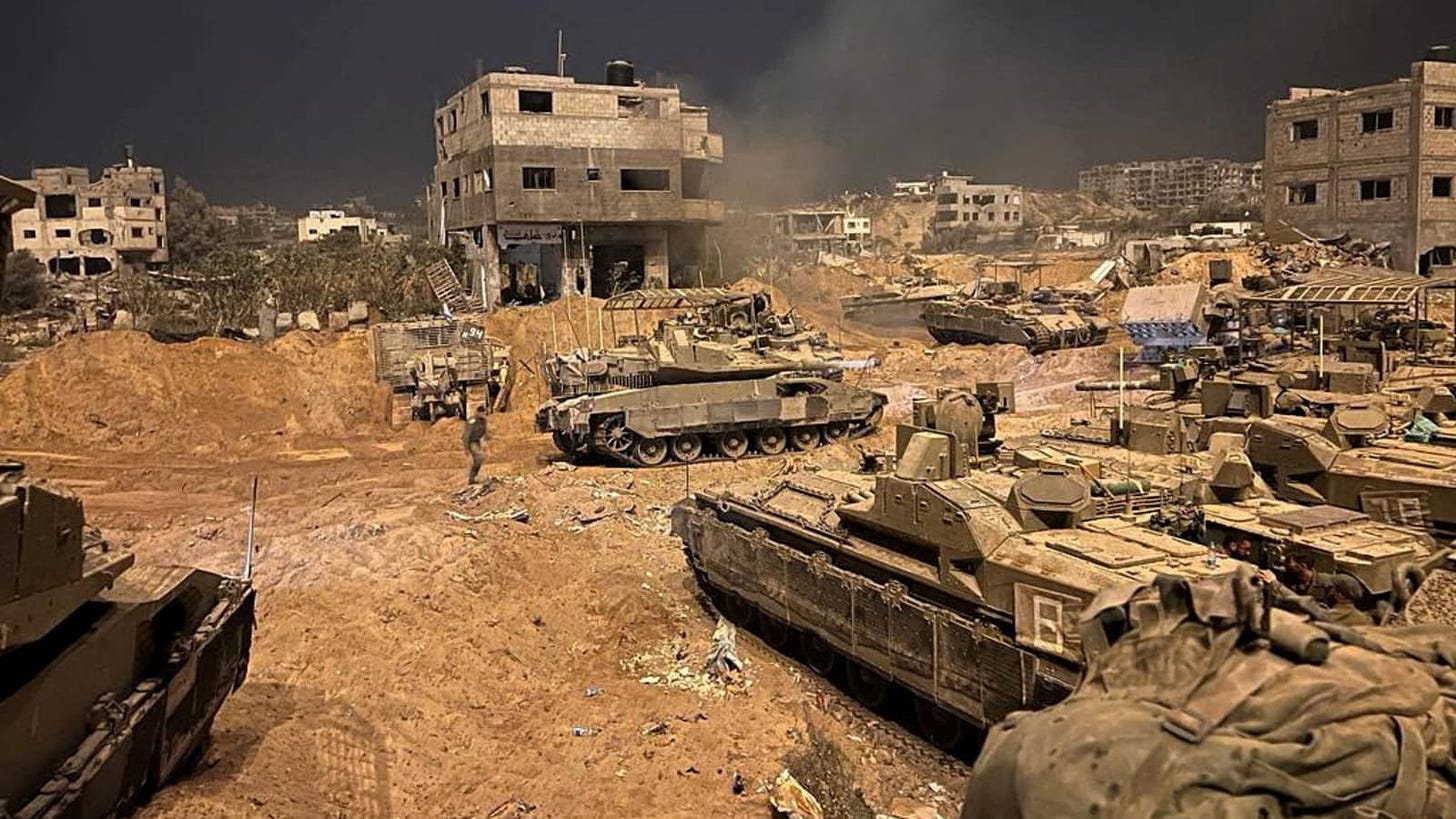
Thus, Israel unfolds according to unique geopolitical logic because it is a unique state, having both an Eschatological-Garrison and a Settler-Colonial nature. The viability of the Israeli project depends on the ability of the IDF to maintain powerful deterrence and protect Israeli settlements and settlers from attack. This fact creates a sense of asymmetric vulnerability for Israel.
"But Serge, you erudite rascal", I hear you say. "Aren't you using overly wrought geopolitical jargon to obfuscate the issue?" Yes, but let me explain. A security asymmetry exists in Israel because the IDF needs to maintain massive full-spectrum overmatch over its adversaries, both in conventional war against state actors *and* a preclusive defense that can effectively filter against low intensity non-state actors. Israel's security situation has been built on the back of overwhelming victories over surrounding Arab states - the Six Day War, the Yom Kippur War, and so forth, but it also needs to constantly filter and defend against low intensity attacks. The viability of Israel's settler project is guaranteed only by IDF overmatch and the threat of punitive attacks.
More importantly, the IDF must not only maintain overmatch in high-intensity warfare (wars with neighboring states), but it must also efficiently filter against low-intensity threats like episodic rocket attacks and cross-border incursions by Hamas. The viability of Israeli settlements depends particularly on the latter, made possible by Israeli intelligence, a dense surveillance system, and physical barriers.
An analogy may be useful.
Did you know that the Roman Empire did not defend its borders? It may sound strange, but it is true. Particularly in the high days of the Julio-Claudians (from Augustus to Nero), Rome had fewer than 30 legions, the deployment of which left vast gaps in the border which were bereft of Roman troops. So, how did the Empire stay safe?
In the first century, Rome was faced with a Jewish revolt in its province of Judea. At the height of its powers, Rome never faced a genuine threat from the Jewish rebels, and several years of counterinsurgency saw the movement largely stamped out. By late 72 AD, the Romans had a few hundred rebels trapped in a hilltop fortress at Masada. The rebels had limited supplies. It would have been a trivial thing for Rome to leave a detachment to besiege the fortress and wait for the defenders to surrender. But that was not the Roman style. Instead, an entire legion was committed to build an enormous ramp up the side of the hill, which was used to haul huge siege engines up the slope and smash the fortress open.
Why? For Rome, this seemingly oversized force commitment (an entire Legion to dig out a few hundred hungry Jewish rebels) was worth it, because it maintained the widespread fear that any attack, any disobedience against the Empire would bring an enormous hammer down. "Cross us, and we will hunt you down and kill you." In a sense, the excessive force commitment was the point, and served as a conspicuous display of military profligacy. Rome was able to secure the borders of an enormous empire for centuries with shockingly low force generation by maintaining the threat of overmatch, and reliably (we might say excessively) punishing those who either invaded or rebelled. In the case of the 1st Century Jews, their temple was destroyed, much of Jerusalem was wrecked, and their leadership was devastated and scattered.
Ironically, Israel now finds itself in a situation similar to their former Roman overlords, needing to maintain full spectrum overmatch and the political will to wield their power punitively in order to sustain deterrence and protect their settler project. Much like 1st Century Rome, Israel perceives that its capacity to interdict low intensity threats has been called into question by Hamas's strategic surprise in October, and like Rome the IDF is attempting a display of conspicuous military profligacy.
That is why, on October 7, Israel found itself in Zugzwang. It had to move, but the only move available was a massively destructive invasion of the Gaza Strip, because Israeli strategic logic dictates an asymmetric response. Hamas's attack necessarily triggered a ground invasion and concordant air campaign with the ostensible goals of eliminating the organization, despite the obvious certainty that would cause mass casualties in Gaza and abnormally high losses among the IDF. This is a highly populated, densely settled area full of civilians with nowhere to go. Any Israeli response was bound to kill and wound large numbers of civilians, but the necessity of a response is dictated by the nature of the Israeli state.
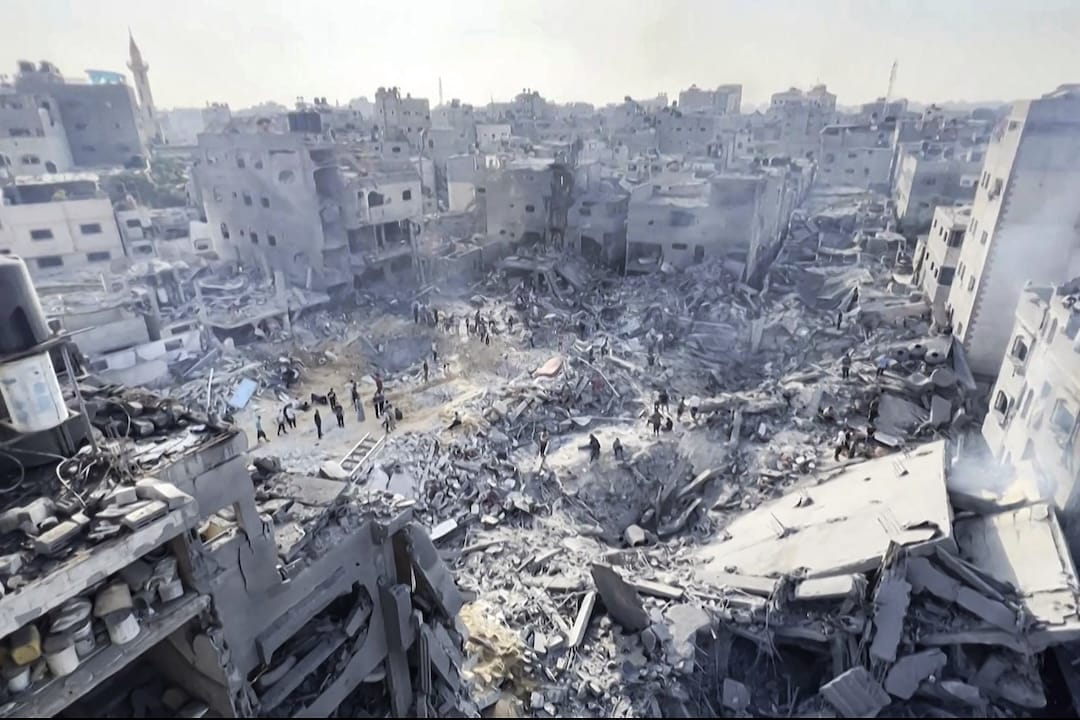
Ultimately, I have always believed that there is no durable solution to the Israeli-Arab conflict short of military victory for one side or the other. Neither a two-state nor a one-state solution is viable given the current construction of the Israeli state and its ideological content. A one-state solution (which gives citizenship to Palestinians within the Israeli polity) is unlikely to satisfy anyone, but would be particularly abhorrent to the Israelis who would correctly perceive it as the de-facto surrender of their state via demographic overwhelming. A two-state solution would require an Israeli strategic retreat from its settlements. In short, any of the potential diplomatic arrangements constitute Israeli strategic defeat, and can only come about once Israel has actually suffered such a strategic defeat on the battlefield.
So, Israel's blood is up. Within the peculiar parameters of Israeli strategic logic, it must smash Gaza by military force or else face the irretrievable discreditation of the IDF's deterrence, and in turn the collapse of the settler project. Either the capacity of the Palestinians to offer low-intensity threats will be shattered, or the population will flee into the Sinai. Probably, for Jerusalem, it does not matter much which.
Ultimately, foreign observers must understand that the Israeli-Arab conflict is practically predestined by the peculiar nature of the Israeli state. As both an Eschatological Garrison state and a Settler-Colonial enterprise, Israel is unable to relate normally with the Palestinians (who do not have a state at all), and the only way out of the jam is either an Israeli strategic defeat or the shattering of Gaza. This is not a puzzle with a clean solution.
Washington and TehranConcurrent with the collapse of the temporary stable state in Israel, the United States faces an unraveling of its position across the region, particularly in Iraq and Syria. This, perhaps even moreso than the Israeli predicament, represents an idealized example of geopolitical zugzwang.
To begin, one must understand the strategic logic of American strategic deployments. America has made generous use of a strategic deterrence tool colloquially known as the Tripwire Force. This represents an undersized, forward deployed force located in potential conflict zones with an eye to deterring war by signaling a commitment to respond. The classic example of the tripwire force was America's minuscule deployment in Berlin during the cold war. Far too small to derail or defeat a Soviet offensive (and indeed, conspicuously so), the purpose of the American Berlin garrison was, in a sense, to offer themselves up as potential casualties, denying America any political latitude to abandon Europe in a conflict. American forces in South Korea serve a similar purpose: since in North Korean incursion into the South would necessarily kill American troops, Pyongyang understands that it would be ipso facto declaring war on the United States along with the South.
On the whole, the tripwire force is a useful and well established tool in strategic deterrence, utilized by both the United States and the Soviet Union (as in its deployments in Cuba) throughout the cold war.
Today, the United States adopts a similar strategy in the middle east, in relation to Iran. America's strategic goals in the Middle East are actually not particularly complex, though they are often made to seem this way simply by the fact that the American foreign policy complex is both bad at and uninterested in explaining itself.
The American strategic goal, in a few words, is to conduct area denial and prevent Iranian hegemony in the middle east. This, in turn, is an extension of the broader American grand strategy, which is to prevent the preeminent or potential regional hegemons from consolidating positions of domination in their regions: Russia and Germany in Europe, China in East Asia, Iran in the Middle East. The geopolitical story of the modern world is one of triple containment by the United States, using an array of regional satellites, proxies, and forward deployments. Because Iran is the only state in the Middle East with the potential to become a regional hegemon, it is the object of American containment.
America's lingering deployments in places like Iraq and Syria therefore ought to be understood primarily as efforts to disrupt Iranian influence and offer forward deployment to combat Iranian militias (these deployments are themselves necessary because American adventurism throughout the last two decades created vacuous Trashcanistans in Iraq and Syria that are vulnerable to creeping Iranian influence). They can be understood as a form of tripwire force that also has limited operational value.
Unfortunately, the United States has discovered the limits of these skeletal forward deployments. The American presence across the region is too small to credibly deter attack, but large enough to invite it.
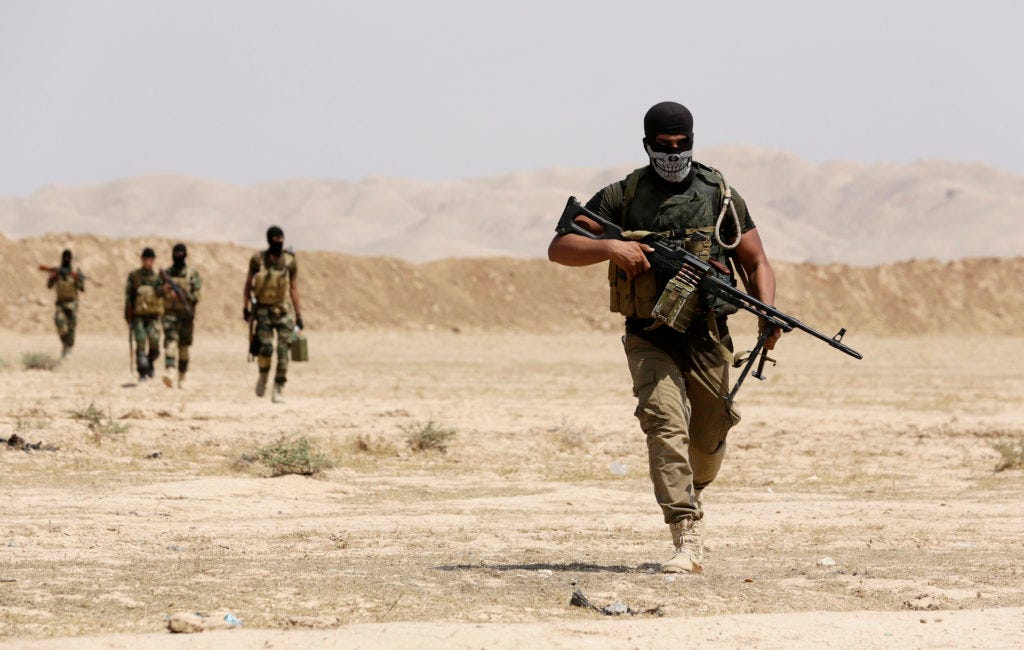
The problem, very simply, is that the standard American toolbox is relatively useless for deterring Iran and its proxies, for a variety of reasons. The standard American reprisal for attacks on its facilities and personnel - air strikes - have little deterrent value against irregular combatants who are both willing to take casualties and mentally acclimated to a long struggle of strategic attrition and survival. Iran and its proxies have long time horizons that are resistant to short, sharp rebukes.
Furthermore, Iran and its allies thrive in conditions of governmental disorder, inuring them to America's capacity to smash up states (creating what I call trashcanistans). Creating a trashcanistan can be strategically useful in many circumstances - by intentionally creating a failed state, a vacuum of disorder can be created on the enemy's doorstep. In the right circumstances, this is a potent lever for creating geostrategic area denial. In Iran's case however, failed (or at least, destabilized centers) create vacuums for which Iran is the most natural fill. This is why America's geopolitical shooting spree across the Middle East has coincided with decades of steady growth in Iranian influence.
All that is to say, America's levers in the Middle East do not pose a credible deterrent to either Iran or its proxies. This is being demonstrated in real time, with American displays of force flatly failing to curb Iranian activities. American bases have endured relentless rocketry attack by Iranian proxies (attacks that have killed American soldiers), and the Ansar Allah movement (the Houthis) continue to obstruct shipping in the Red Sea despite a limited air campaign. In a geostrategic environment where deterrence is no longer credible, tripwire forces (like the American bases at Al-Tanf and Tower 22) cease to become deterrents at all, and become mere targets. Furthermore, the death of American soldiers no longer inspires public outrage and war fever the way it once did. After decades of wars across the Middle East, Americans are simply habituated to hearing about casualties in places that they have never heard of and do not care about. Thus, as both a geostrategic and a domestic-political instrument, the tripwire is busted.
Once again, our good friends the Romans provide an instructive analogy.
In the first years of the 2nd Century (roughly 101-106 AD), the great Roman Emperor Trajan conducted a series of campaigns which conquered the independent polity of Dacia. Though Putin's interview with Tucker Carlson perhaps did much to normalize verbose historical digressions, we will steer clear of the particularities of the Dacians' Indo-European origins and simply say that Dacia should be thought of as Ancient Romania. In any case, the great Trajan conquered Dacia and added vast, populous new provinces to the Empire. Yet this conquest was understood as a sign of Roman weakness. How? Why?
For centuries, Rome had indirectly controlled Dacia as a sort of client-proxy kingdom on its borders, kept in line with punitive expeditions and the threat that they posed. On occasions where the Dacians behaved in a way problematic to Rome (such as raiding into Roman territory or becoming too independent or assertive), Rome would make punitive attacks, burning Dacian villages and often killing Dacian chieftains and kings. By the first century, however, Dacia had become increasingly powerful and politically consolidated, and Rome felt compelled to act more aggressively. In short, Trajan had to conquer Dacia - a militarily expensive and complicated campaign - because Rome's deterrence was vanishing, and the threat of limited punitive forays had become ever less frightening to the Dacians.
This is a classic example of strategic paradox. An evaporating strategic advantage undercut Rome's deterrence, forcing it to adopt a much more costly and expansive military program to compensate for its gnawing weakness. The paradox here is that the conquest of Dacia was an impressive military feat, but one which was made necessary by collapsing Roman deterrence and intimidation. If Rome had been stronger, it would have continued to control Dacia through indirect (and cheaper) methods, which did not require permanently stationing several legions there. It was a great victory (which did bring about many tangible benefits to the Empire), but in the long run it represented an undeniable contributor to Roman overstretch and exhaustion.
We see a similar dynamic at play in the Middle East, where America's falling deterrent powers may soon force it to take more aggressive measures. This is why those voices calling for war with Iran, as deranged and dangerous as they may be, are actually keyed in on a crucial aspect of America's strategic calculus. Limited measures no longer suffice to intimidate, which may leave nothing in the stable except the full measure.
And so, America faces Zugzwang. As yet it appears that the traditional American toolbox has little to no deterrent value, and American bases around the region appear to be more like targets that tripwires. Similarly, the limited air campaign against Yemen does not appear to have meaningfully degraded Houthi willingness or capability to attack shipping. A recent decapitation strike against the Kataib Hezbollah group - on paper an impressive demonstration of American intelligence and strike capability - led only to another violent outburst against the Green Zone in Baghdad. More broadly, a surge in American strategic deployments (both in the form of a reinforced ground presence and the arrival of naval assets) did not appear to meaningfully deter the Iranian axis.
America soon faces the prospect of a difficult choice, between strategic retreat or escalation. In either case, a skeletal tripwire deployment in the region becomes obsolete, and America must either get out or go in deeper. This is why there are now alarms flashing in the foreign policy blob, who fear an American withdrawal from Syria, alongside ever more deranged calls to "bomb Iran." That's Zugzwang: two bad choices.
KievFinally, we come to the European front, where the United States faces a difficult choice. America's strategic premise in Ukraine was put in serious doubt by two important developments over the past year. These were 1) the abject failure of Ukraine's counteroffensive, and 2) Russia's successful mobilization of both additional manpower and its military industrial complex, despite an attempted strangulation via western sanctions.
Suddenly, the idea of America conducting an asymmetric weakening of Russia seems increasingly shaky, since it is now both highly doubtful whether Ukraine can retake meaningful territories and apparent that the Russian military is on track to emerge from the conflict both larger and significantly battle hardened from its experiences. Indeed, it now appears that the most important results of Washington's Ukraine policy have been to reactivate Russian military production and radicalize the Russian populace.
Now, Washington faces a choice. Its initial preference was to backstop the Ukrainian military with lower cost material (old Soviet bloc inventories from Eastern European NATO members and available surpluses of western systems), but this has now clearly run its course. Efforts within the NATO bloc to expand production of key systems, like artillery shells, are largely stalled, with the Pentagon quietly downsizing its production targets as time goes on. Meanwhile, a consensus has emerged that Russia's efforts to ramp up weapons production have been remarkably successful, with the Russian industrial complex enjoying a significant advantage in both total output and unit cost of key systems.
So, what to do?
The west (by which we really mean America) has three options:
Taper off support for Ukraine, in effect conducting a strategic retreat and writing off Kiev as a doomed geostrategic asset.
Maintain support along the current lines, aiming to sustain a modicum of baseline AFU combat power, which keeps Ukraine on a life support drip as they suffer strategic exhaustion.
Massively ramp up support for Ukraine through a wholesale military industrial policy, in effect partially transitioning the west to a war footing on behalf of Ukraine.
The issue here is that Russia has a head start in transitioning to a war economy, and has little difficulty selling that choice to the populace because the country is, in fact, at war. Russia enjoys significant advantages, such as a lower cost structure and more compact supply chains. In an election year, with a growing portion of both the electorate and the congress appearing weary of hearing about Ukraine, it is difficult to imagine the United States committing to a de facto economic restructuring and disruptive war economy on Ukraine's behalf. In fact, there now appears to be growing alarm that military aid from the United States might be cut off altogether, with the latest aid package appearing unlikely to pass the house amid the latest border security imbroglio.
And so America faces Zugzwang in Ukraine. It can choose to go all-in, but this means both selling a disruptive breakneck rearmament to the American public in peacetime, *and* gambling on a faltering piece in Kiev (which is now facing a command shakeup and yet another shattered defensive stronghold in Avdiivka). Strategic retreat in the form of abandoning Kiev may make the most sense from a pure cost-benefit perspective, but there are undoubtedly prestige factors at play. Walking away from Ukraine entirely and simply leaving it to be steamrolled would be seen, and rightfully so, as a Russian strategic victory over the United States.
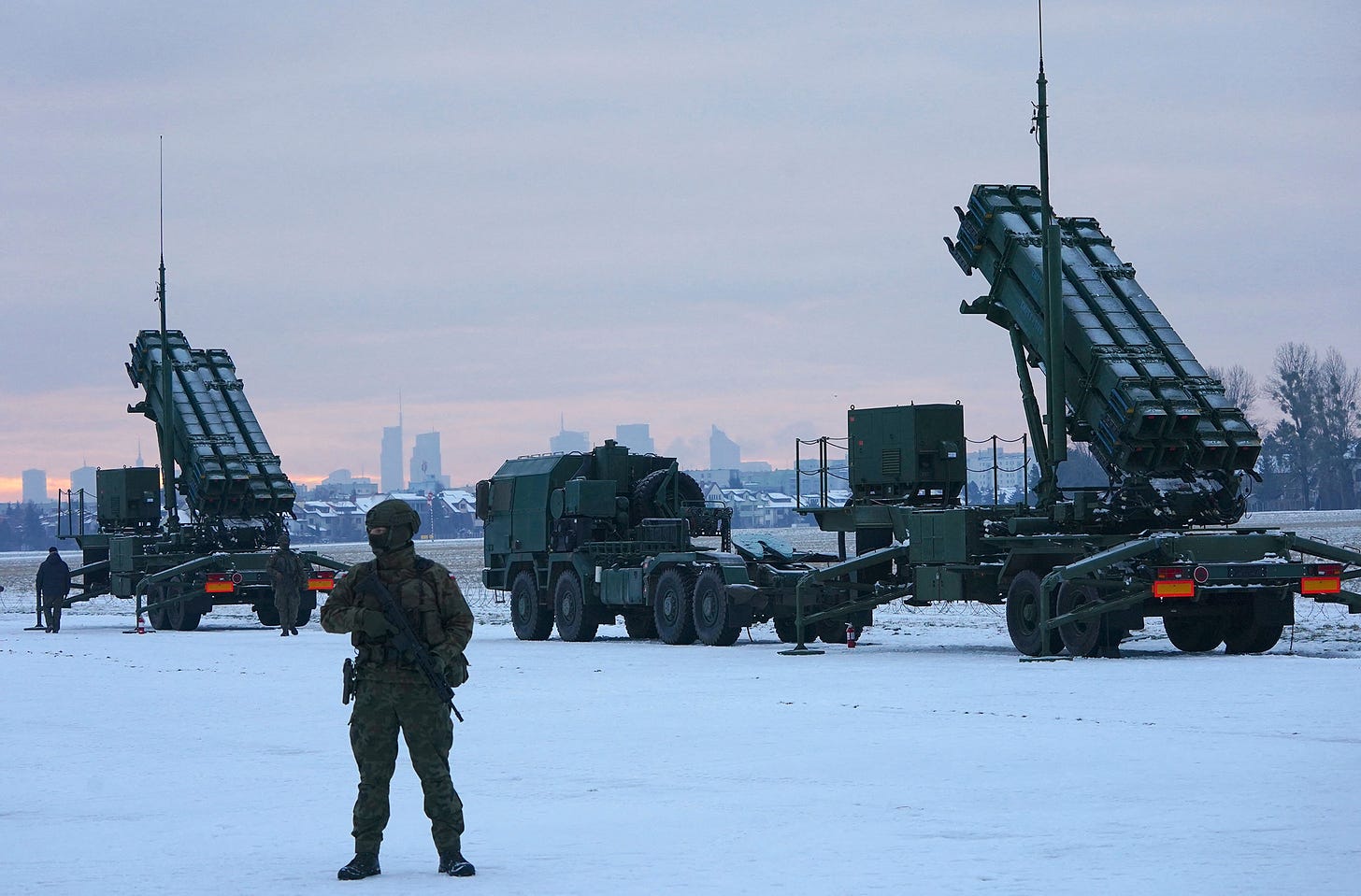
That leaves the third door, which is the sort of drip feed of aid that maintains the perception of American support for Ukraine, but offers no real prospect of Ukrainian victory. This is a cynical play, which props the Ukrainians upright for a slower death for which they themselves can be held accountable - "we never abandoned Ukraine, they lost."
No good options? That's zugzwang.
Conclusion: Go In or Get OutThe basic geostrategic problem facing the United States (and its ectopic paramour, Israel) is that the ability to conduct asymmetrically inexpensive countermeasures has become exhausted. The US can no longer prop up Ukraine with surplus shells and MRAPs, nor can it deter the Iranian axis with reprimands and air strikes. Israel can no longer maintain the image of its impenetrable preclusive defenses, upon which its peculiar identity depends.
That leaves the difficult choice between strategic retreat and strategic commitment. Half measures no longer suffice, but is there will for a full measure? For Israel, which has no strategic depth and a unique world-historic self conception, it was inevitable that commitment would be chosen over strategic withdrawal (which in their case is much more metaphysical than purely strategic, and amounts to the deconstruction of the Israeli self conception). Thus, the immensely violent Israeli operation in Gaza - an operation that could never have gone any other way, given the density of the population and its eschatological meaning.
America, however, has a great degree of strategic depth - the same strategic depth which allowed it to withdraw from Vietnam or Afghanistan with few meaningful ill effects on the American homeland. The possibility most certainly remains for a prosperous and secure America long after withdrawing from Syria and Ukraine. Indeed, the famously chaotic scenes of frantic evacuation from Saigon and Kabul represent remarkably clearsighted moments in American foreign policy, where realism prevailed and losing chess pieces were left to their fates. This is cynical, of course, but that is the way of the world.
This is a standard motif of world history. The most critical moments in geopolitics are generally those where a country faces the choice between strategic retreat or full commitment. In 1940, Britain faced the choice between accepting Germany hegemony on the continent or committing to a long war which would cost them their empire and lead to their final eclipse by the United States. Neither is a good choice, but they chose the latter. In 1914, Russia had to choose between abandoning its Serbian ally or fighting a war with the Germanic powers. Neither seemed good, and they chose the latter. Strategic retreat is hard, but strategic defeat is worse. Sometimes, there are no good choices. That's Zugzwang.
19 Jan 2024 | 9:49 pm
6. Downfall: The Conquest of Germany
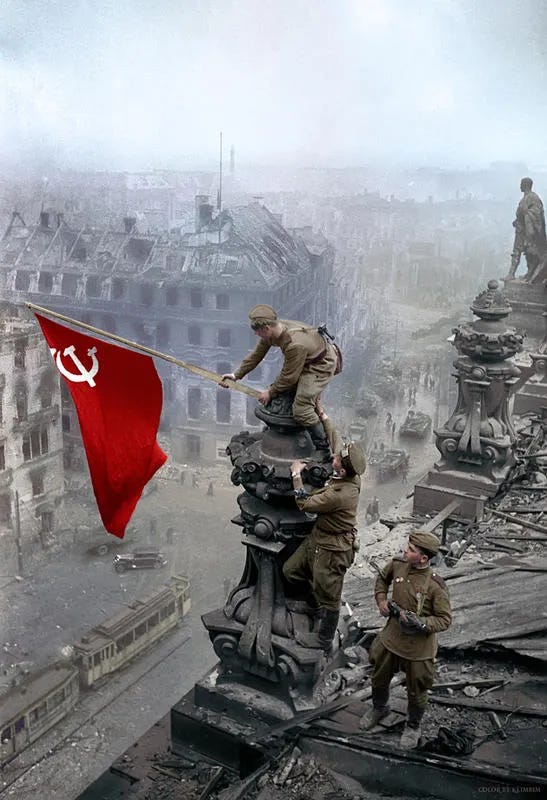
Among the photographic record of the Second World War, two images in particular became very famous as the iconic representations of the war's end. The first such photograph, taken on May 2, 1945, depicts a Soviet soldier raising the flag of the USSR over the Reichstag building, with the ruins of Berlin smoldering beneath him away towards a gray horizon. The second picture, taken a few months later on August 14, 1945, depicts an American sailor in Times Square embracing and kissing a young woman in white, against a backdrop of a bright, bustling and optimistic city.
The pictures have very little in common, apart from the rather trivial note that the identity of their subjects is a matter of dispute. The image of the Soviet victory in Berlin is unquestionably apocalyptic, with rubble, smoke, and ruination stretching to the horizon point. It is an image of death. In contrast, "VJ Day in Times Square", as the kissing picture is known, conveys jubilation and an airy, joyful vitality. It is an image of life.
The duality is, perhaps, fitting. While nominally the end of war is a preeminent cause for celebration, for much of the world 1945 brought little relief. Hundreds of millions were left teetering on the edge of both physical and psychological annihilation amid widespread ruination of their cities and villages, famine, disease, ethnic cleansing and vengeance killing, rape, political revolution, and the nearly unimaginable social trauma brought on by the death of many tens of millions.
Recasting the end of the war as a cause only for jubilation misses the reality of what occurred in 1945. The end of the war was not merely a cozy cessation of conflict, but the complete destruction of two extremely powerful empires - one German and one Japanese - by way of military action. Simultaneous with these two geopolitical executions, a new Empire was born: a Stalinist empire, ruled from Moscow, anti-Capitalist in orientation, built astride an astonishing military-security apparatus.
While it is obvious to us that by the first weeks of 1945 German defeat had long since become an inevitability, the actual task of finally eliminating German armed resistance was fantastically bloody. In the latter half of 1944, the German field armies in the east still fielded more than 2.5 million men, who continued to fight fanatically in many untenable circumstances. Red Armed KIA in the final year of the war numbered in excess of a million. This was a war that ended with a bang, not a whimper.
Hitler made many promises to the German people, and kept them with various levels of success. But there was one promise that he would fulfill in totality. He had always insisted that whatever happened, the "shame of 1918" - Germany's surrender in the first world war - would not be repeated. In that war, the German army had capitulated while it was still in the field - and not just in the field, but on occupied French territory. Germany lost the first war without its territorial integrity being breached or its army destroyed. That indignity would not occur again. Instead, the Wehrmacht would fight to the death and try to drag the enemy to hell with it in an orgy of phantasmagorical violence.
Roundup in the RuhrBy the time 1945 dawned on war ravaged Europe, the material state of the Wehrmacht had fallen to unthinkable lows. 1944 had seen the Germans adopt new methods to cover their soaring losses (particularly after the concurrent losses in Operation Bagration and the Falaise Pocket), with the formation of Volksgrenadier divisions. These were a new type of infantry formation designed for close-in positional defense, usually short on heavy weaponry but liberally equipped with submachine guns and man portable antitank weapons. At the time of their introduction, the Volksgrenadier divisions could be seen as a manpower economizing expedient and an ominous sign of collapsing German fighting power - but within a few short months, they would come to seem like a luxury.
After 1944's stopgap solution of the Volksgrenadier divisions, 1945 would be the time of the Volkssturm - the "people's storm". Unlike the Volksgrenadiers, who were at least regular army formations with standardized equipment, the Volkssturm units were barely trained militia units made up of old men, young boys, invalids, civil servants, and any otherwise warm bodies that the Germans could scrounge up. Utterly unsuited for any combat tasks beyond urban brawling, the militia units of 1945 represented the fraying logic of German strategic thinking. At this stage in the game, the premise of Germany's strategy had now drifted fully into the realm of nihilistic delusion: the idea of the Volkssturm was to make the final conquest of Germany so costly (via the fanatical resistance of the entire population) that allied morale would crack - win a war by making the enemy tire of killing you.
With the Wehrmacht struggling to hold a coherent line and Volkssturm trash units being hastily raised in the rear, Germany's situation could not have contrasted more sharply from that of its adversaries. While the Red Army had by now mastered its particular form of sweeping operations, on the western front the Germans faced an American Army that was, by all rights, the most liberally equipped and mobile fighting force in history. Fully loaded with armor, half tracks, and self propelled artillery, supplied by truck lift, and protected by an overawing umbrella of air power, the US Army could hit harder and move faster than anybody.
This growing asymmetry may have seemed to be a poor consolation to the nearly five million men in the great allied force bearing down on Germany. For all their material advantages, the going was slow and a series of tremendous obstacles seemed to remain in their way. Much of January, 1945, was spent correcting for the great German winter offensive (the Battle of Bulge), grinding away the German salient and preparing to renew the push eastward. But even after foiling Germany's last attempt to retake the initiative, the allies faced a series of features greatly favorable to the defense.
First, they would have to grind their way through the Rhineland - the densely populated region west of the Rhine, characterized by rolling, hilly topography - after which they would at last come up to the Rhine itself - one of the world's great river barriers. This promised a complex breaching task which would require intricate planning and preparation and a good deal of tricky combat engineering. Finally, having crossed the Rhine the allies would find themselves coming upon Germany's great Ruhr industrial region. This was (and is) one of the world's great urban agglomerations - home to millions of civilians, dozens of interlinked cities, and vast factory complexes. Even a dying German army could turn these obstacles into dangerous defensive positions, and the Ruhr region in particularly threatened to become (as one historian has put it) a "Super Stalingrad", obliging the allies to take tremendous casualties digging out the Germans in a sprawling urban battle.
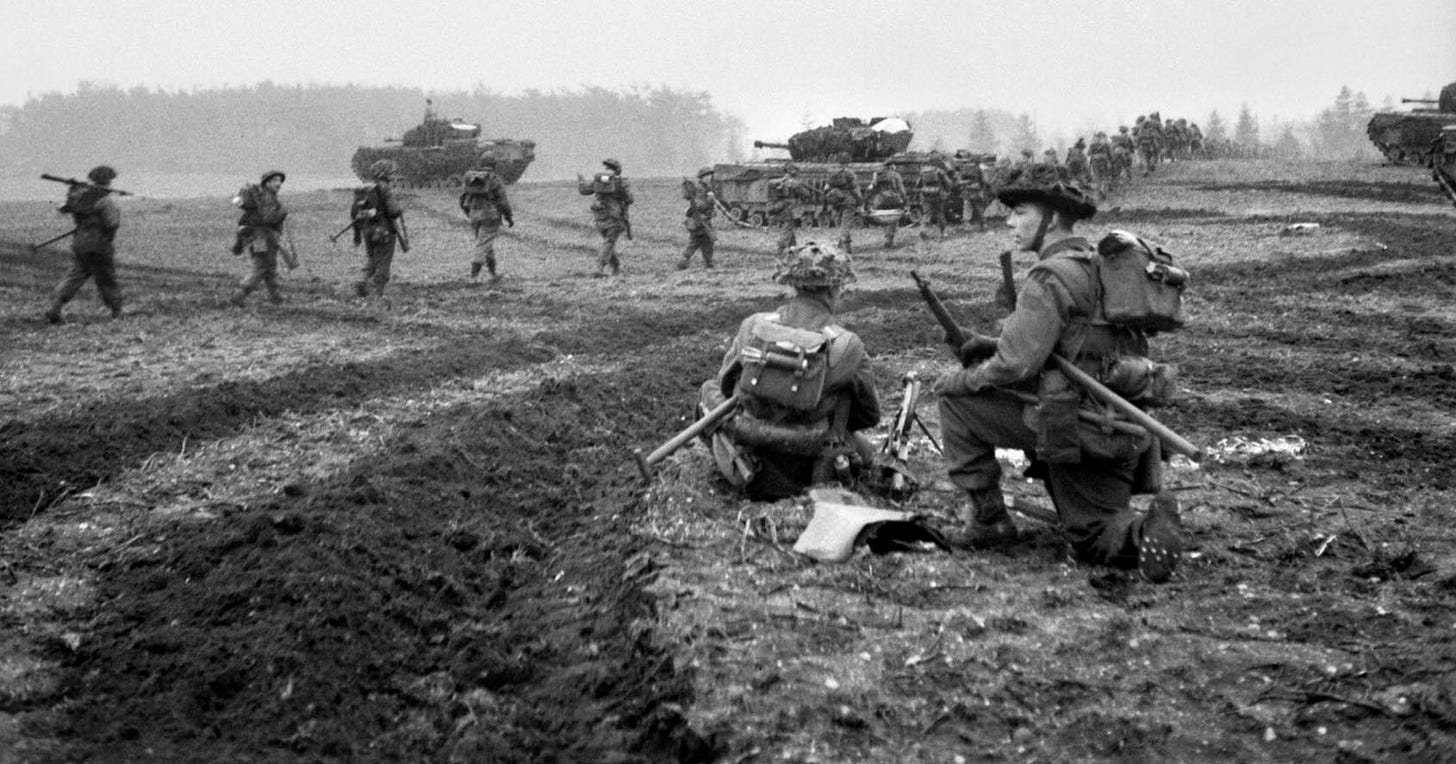
The Germans were on the run, bleeding, dying, but clearly dangerous, particularly fighting behind a major barrier like the Rhine or defending their own cities. The allies certainly understood this, as the Germans had on many occasions in 1944 showed that they were still more than capable of fighting a deadly positional defense - take, just for example, the some 40,000 allied casualties suffered in a multi-month attempt to clear the Germans out of the Hürtgen Forest, or the 50,000 losses suffered by Patton's 3rd Army in their assault on the Lorraine region. Still over 300 miles from Berlin, with major German formations in the field on accommodative defensive ground, there was every reason to believe that 1945 would bring long, hard fights with high casualties.

Then, in an instant, the clouds cleared and the allies could see daylight ahead.
The capture of the Ludendorff Bridge at Remagen by American forces in March 1945 is one of the more famous moments of America's war - a seemingly impossible stroke of good fortune. The town of Remagen - an otherwise idyllic little burgh on the west bank of the Rhine, home to perhaps 18,000 people - almost seems to exist purely for the purpose of river crossings by armed bodies. The town had its inception as Roman fort, built just upstream of the first bridge ever built over the Rhine - a timber structure erected by Julius Ceasar's forces in the long past. Millenia later, during the first world war, Remagen was selected for the wartime construction of a new bridge designed to improve rail connectivity between Germany and the western front. This bridge, built between 1916 and 1919 by POW laborers, was named after General Ludendorff, and featured a pair of rail lines and a pedestrian catwalk. It was this bridge that elements of the US 9th Armored Division (a constituent of General Courtney Hodges' 1st Army) were amazed to see as they rolled up on the approach at Remagen on March 7.

Finding an intact bridge over the Rhine was no doubt an amazing stroke of good fortune for the allies. When General Hodges relayed the good news to his superior, General Omar Bradley, the famous response from the latter was "Hot dog, Courtney! This will bust him wide open!" - the "him" in reference being Eisenhower.
The general interpretation of events is that the Germans were caught unable to make good their escape across the river in time, and the Americans by a stroke of good fortune managed to capture a bridge before it could be destroyed. But this misses the most important element of the story. The Bridge at Remagen was not a story about happy luck, but an operational progression stemming from German lethargy, strategic mistakes, and immobility, and the corresponding American powers of maneuver.
More to the point, when the 9th Armored Division found the Ludendorff bridge intact, the Germans were not defending from behind the Rhine, or even attempting to retreat over it. They were instead fighting hard on its western bank, attempting a positional defense of the Rhineland. The river was not being used as a defensive barrier, but was instead still a geographic feature in the German rear area. On March 7th, when the status of the bridge was discovered, the Wehrmacht had no immanent plans to retreat across the river - an operational decision that in itself would have been immensely complex and required the careful withdrawal of hundreds of thousands of men.
Thus, rather than catching a retreating enemy before it could scamper across the river, the 9th Armored Division had advanced up a seam and gotten into the rear area of an enemy that was still trying to defend a vast and densely populated region on the river's west bank. Understanding this difference changes the whole sheen of the story: it was not dumb luck that let the Americans reach the bridge, but the foolish German decision to fight a positional defense on the river's far side against an enemy with vastly superior mobility.
The sequence of events following the March 7 discovery of the Ludendorff bridge present a nearly idealized window into the end of the Reich. The approaching Americans found nothing like a prepared defense, no vast force prepared to defend Germany at the Rhine. Instead, they found a sleepy Remagen and a bridge defended by a rear area force (a mix of infantry, Luftwaffe anti-air crews, and engineers commanded by General Joachim von Kortzfleisch) with orders to guard the bridge or - if necessary - blow it.
The sudden approach of the Americans seems to have caught the Germans largely by surprise. In a scrambled attempt to establish a blocking position on the west bank of the river while wiring the bridge to blow, the Germans failed at both tasks. American tanks managed to rush the bridge in short order - Remagen, again, being considered a rear area had virtually no antitank barriers, mines, or established firing positions. A last minute attempt by the Germans to blow the bridge resulted in a moment of high drama, with the bridge rattling and momentarily vanishing from view in a cloud of smoke. Fortunately, the cloud dissipated to reveal the bridge intact, with only minor damage to one of its pedestrian catwalks, owing to problems with the untested wiring and insufficient explosives.
At this point, the savvy reader may wonder why the Germans had made no preparations to destroy the bridge - even as a contingency - until there were American tanks on approach. The answer lay in an incident from the previous October, when a bridge in Cologne was brought down after an explosive satchel was accidentally detonated. A furious Hitler had court marshalled the responsible officers and instituted new rules which stipulated that bridges could not be wired for demolition unless there were allied forces within five miles - furthermore, a bridge could not be blown without written orders from the chain of command on the scene. Thus, in anger over the premature demolition of one bridge, Hitler had made it nearly impossible for later bridges to be destroyed on time. As it turned out, strict adherence to the new policy would not save the command staff at Remagen - a week later, on March 14, four German officers would be summarily executed for "allowing" the Americans to capture the bridge.
In the following weeks, the Germans would throw a whole host of weaponry at the Ludendorff Bridge, trying to bring it down as the Americans relentlessly pushed forces across to the east bank of the Rhine, flooding their new bridgehead with fighting power. The Germans threw the proverbial kitchen sink at the bridge, firing at it with all manner of artillery including the 60 cm heavy siege mortar, attacking it from the air with trusty Stuka dive bombers, lobbing rocket propelled 380mm mortar rounds from Sturmtiger assault guns, and even shooting a V2 ballistic missile (which missed by many miles). The cumulative damage did finally succeed in forcing a collapse in the span, and on March 17 the Ludendorff Bridge finally tumbled into the Rhine, but by that point it was too late - US Army Engineers had already capitalized on the crossing and erected a host of pontoon bridges, providing a solid link to the bridgehead.
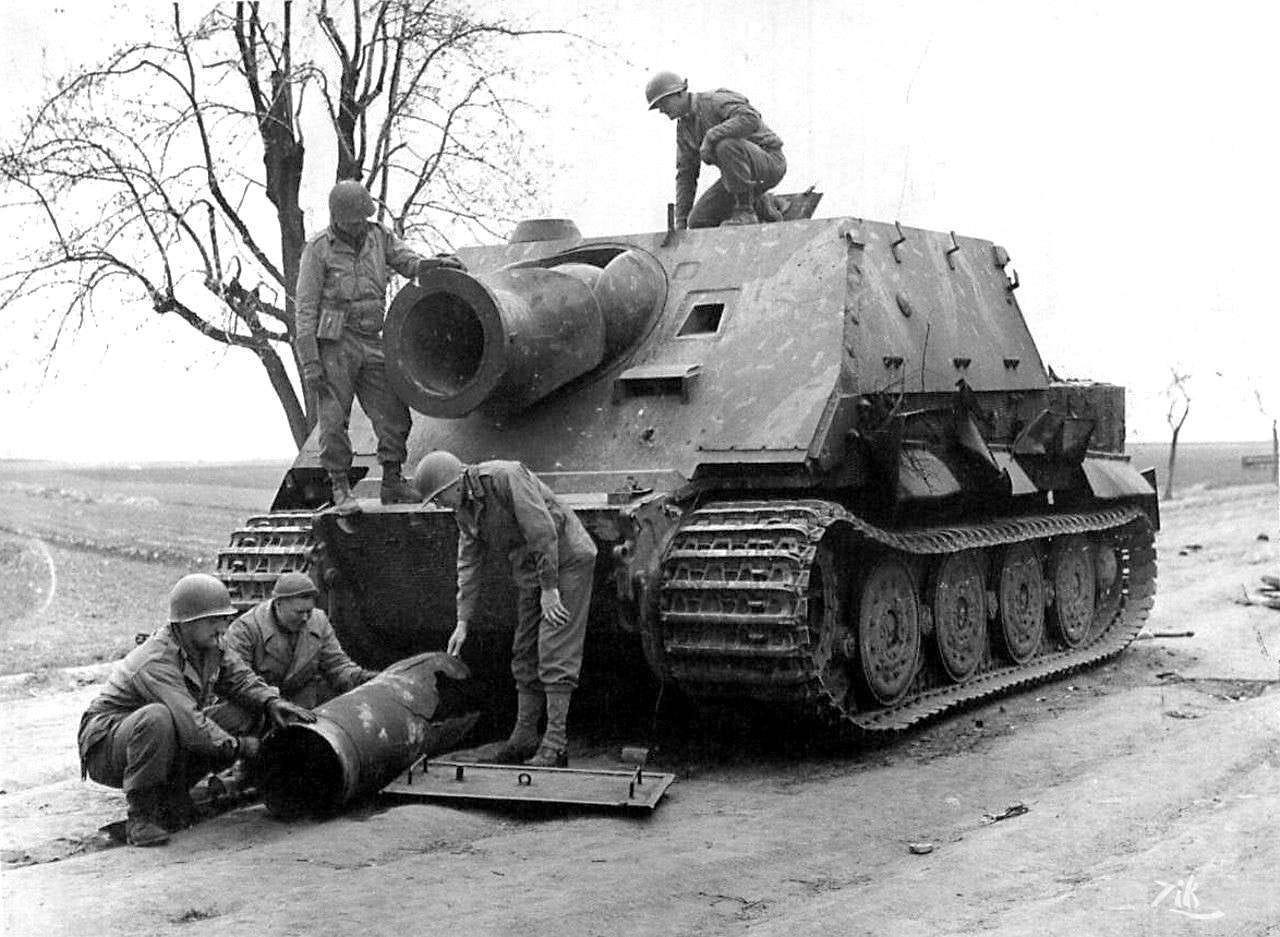
This was the late war Wehrmacht in a nutshell: a whole slew of powerful and advanced weaponry (available in small numbers), officers being executed for capricious reasons, critical infrastructure defended by untrained militia and old men. Most importantly, however, the Germans were now on the verge of an operational annihilation of their own making. The foolish decision to defend the Rhineland to the end, combined with the wastage of much of the remaining Panzer force in the Battle of the Bulge, had left the Germans flat footed, exhausted, strung out on the wrong side of the river, and unable to counter the unexpected American lunge over the Rhine.
For the Americans, however, the sudden crossing of the Rhine opened the door to one of the biggest operational coups of the war. With Hodges' First Army now building a powerful force in its bridgehead across from Remagen, the Germans began a hasty redeployment to defend east of the river, with Model putting his 5th Panzer Army in place to block the Ruhr industrial region, and 15th Army attempting to block up Hodges's bridgehead. Despite the generally parlous state of the Wehrmacht by this point, the prospect of bashing through these two armies in a dense urban region like the Ruhr was not a pleasant one, and it brought the distinct possibility of huge American casualties in the war's closing act.
Fortunately, Eisenhower was not aiming to fight through the Ruhr, but to encircle the entire thing. He already had the base of one pincer in place, with Hodges' 1st Army now preparing to break out of its bridgehead at Remagen. The other pincer was prepared with the accelerated launch of Operation Plunder, which got General William Simpson's 9th Army over the Rhine near Wesel, some 80 miles to the north, on March 23. Plunder took no chances with the crossing, and featured a massive parachute drop on the German side of the river to ensure the successful seizure of a bridgehead.
In short, Eisenhower now had two powerful American armies over the Rhine River, on both the northern and southern peripheries of the Ruhr region. It was time to roll.
While Simpson was getting his forces sorted after crossing the Rhine, it was time for Hodges to punch out of his bridgehead. The density of forces in the Remagen bridgehead was astonishing - Hodges had packed three overweight corps, a fully mechanized powerhouse brimming with armor, trucks, and self propelled artillery. An unexpected clearing of the skies, which allowed American tactical aviation to blanket the roof and drive the Germans off the roads, only put the cherry on top.
Hodge's breakout from Remagen began on March 25, and already by the 28th his lead elements were more than 80 miles to the east, ready to loop north behind the Ruhr. The lead American formation by this point, spearheading the great pincer, was an armored column under the command of Lieutenant Colonel Walter Richardson - a constituent force of General Maurice Rose's 3rd Armored Division.
Task Force Richardson's job was to roll up the highway to the cities of Paderborn and Lippstadt, where they would link up with elements of Simpson's 9th Army - completing the encirclement of the entire Ruhr region. Unfortunately, at this moment a scene of genuine drama unfolded.
The official US Army History (the famous Green Book series) describes events this way:
The longest delay for Richardson's column developed in Brilon, twenty-five miles short of Paderborn, where, as Richardson and an advance guard pushed on, someone among the tank crews discovered a warehouse filled with champagne. When the tanks finally caught up with their commander, the actions of many of of the crewmen provided disconcerting evidence of their find.
Task Force Richardson at last halted around midnight fifteen miles short of Paderborn… Although still short of the objective, Richardson and his men had covered forty-five miles at a cost of no casualty more severe than the headaches some men suffered from too much champagne.
Unfortunately, the following morning Richardson's armored column - with its crews still hungover - bumped directly into a battlegroup that had just deployed from a nearby SS training facility, armed with nearly sixty heavy panzers including tigers and panthers. In the confusion of the ensuing fight, General Rose (who had come up to supervise the assault) was killed when his staff car ran into a column of German tanks.
The tragic death of an esteemed and widely respected general notwithstanding, the Germans could not stop the avalanche. Task Force Richardson was only the spearhead - more and more American tentacles shot up the roads, bypassing the SS defenses and linking up with elements of the 9th Army at Lippstadt on April 1. It was Easter Sunday.
The Americans now had most of the remaining battle worthy formations of the German western front rounded up in a pocket overlaying the cities of the Ruhr - a trap some 30 miles wide. Trapped in the Ruhr Pocket were hundreds of thousands of German troops (most of Walter Model's Army Group B), thirty generals, and millions of German civilians.
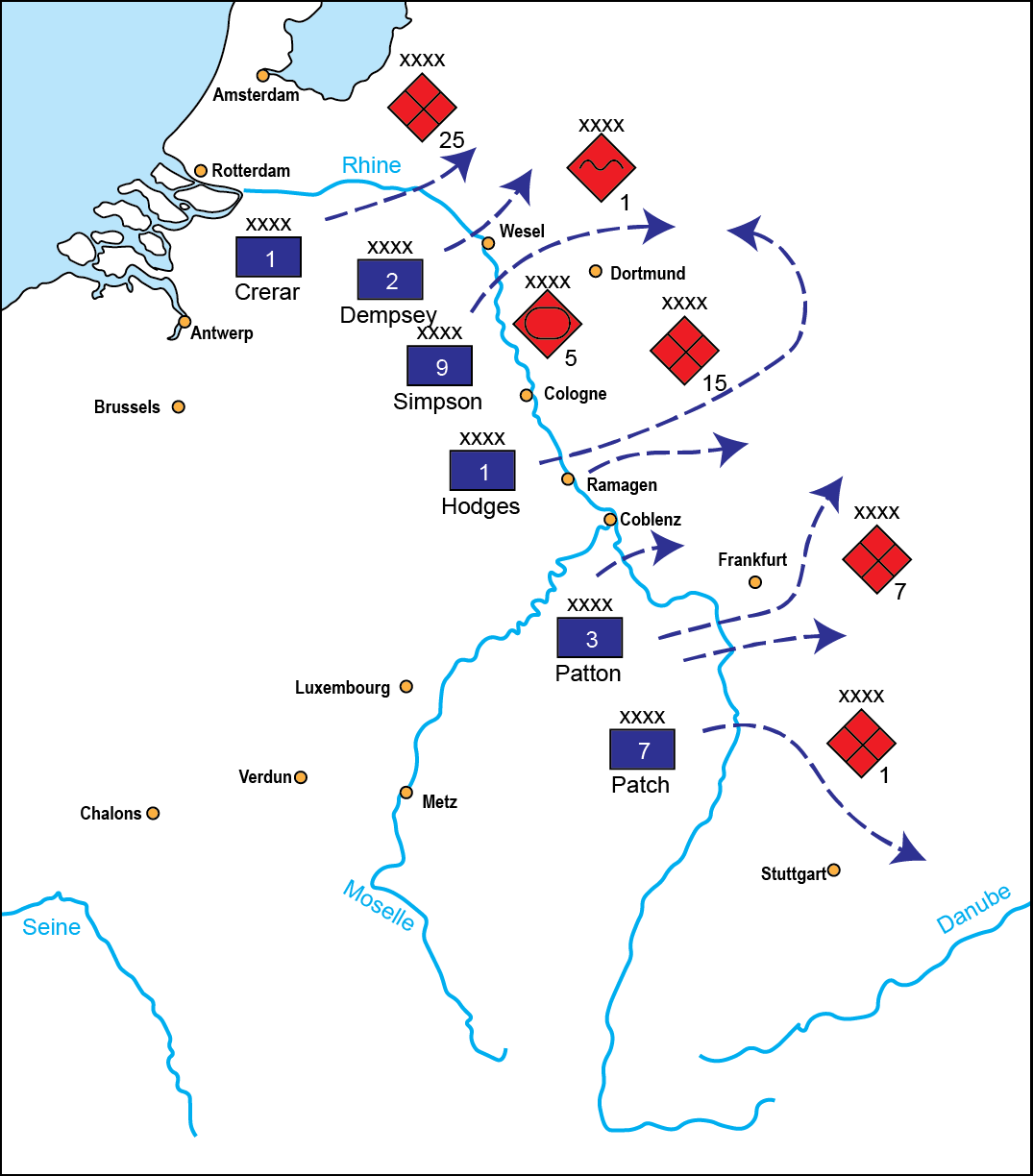
The reduction of the Ruhr Pocket (like its encirclement) was achieved with remarkable speed - two weeks, to be exact. Wary of the danger that the Germans could pose in a positional, urban defense, the American approach was simple, and they opted to simply flatten with artillery fire any position that fired back at them as they approached. The US Army history of the battle simply states that artillery shells were "unrationed", and notes that the XVI Corps, for example, fired exactly 259,061 shells during the fourteen day effort to liquidate the pocket - and there were three other corps involved in the struggle.
Amid this maelstrom, German civilians in the pocket reacted in a muddle of confusion and terror. While the regime urged them to fight to the death, few were enthused by the prospect, and there was a great deal of proactive effort by civilians to surrender their homes and towns before the Americans were provoked into shelling them. A difficult coordination game now came into play: when to surrender? Raise the white flag too early, and you might find yourself shot for cowardice and defeatism by a German officer. Surrender too late, and you might hear the whistle of inbound shells. Even surrendering is not always easy.
23 Dec 2023 | 10:14 pm
7. Mechanized Stalinism
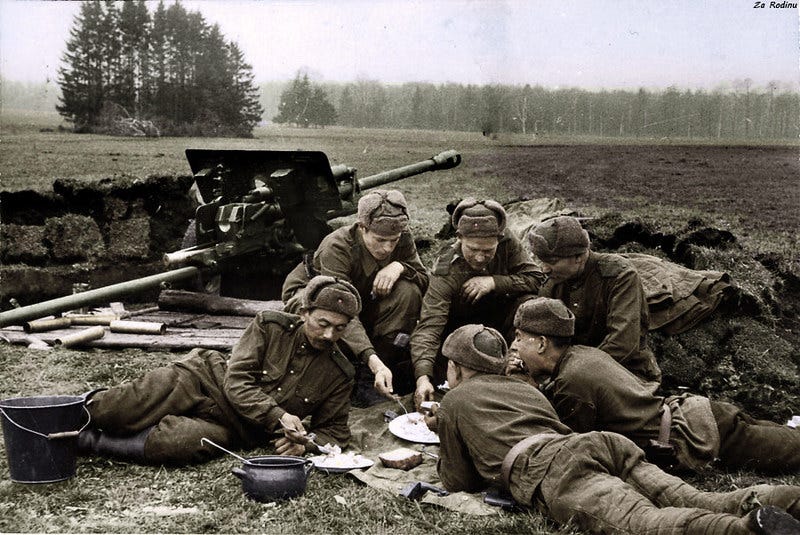
Keeping score in a war is not an easy task. All manner of important data relevant to warmaking is obscured from open view. Much is hidden by the conscious effort of the warring parties for obvious reasons related to secrecy, but even behind the curtain of state security, armies do not always have a particularly accurate sense of how many casualties they have taken, what the strength of their constituent units are, and what the disposition of their forces may be. War is analyzed through a veil, and behind the veil is fog and confusion.
For the sake of convenience, therefore, position is often the most useful and popular marker of a war's progress, but here one runs into another confounding factor: despite the great efforts that go into tracking and mapping fronts and movements and points of contact, territorial control is often a very bad proxy for who is winning or losing a war.
The best example of this, of course, is Germany. The Germans lost the two largest and most destructive wars of the 20th century despite fighting almost the entirety of both conflicts on foreign soil. In the first world war, the Germans were brought to surrender before any enemy forces ever made a penetration into German home territory, and in the second war they fought more than 90% of the war (from September 1939 to March 1945) on enemy territory, as it were, outside the borders of prewar Germany. The converse is, by extension, also true - specifically that the Soviet Union won the largest war in history despite doing most of the fighting in its own territory, with the destruction touching its own cities and people. Then, like a river that inexorably builds pressure until the dam can no longer hold it back, the Red Army burst forward in a colossal wave of conquest.
One of the core geopolitical results of the war - the enormous expansion of Soviet power and the creation of a communist quasi-empire - occurred in a very short and particular period of the war: roughly from July 1944 to March 1945. In the scope of a six year long conflict that engulfed much of the globe, this was an extremely rapid and totalizing act of empire building. While the powers of the world were all focused on their war efforts, Stalin conquered Eastern Europe in a "blink and you'll miss it" campaign. In that brief and extremely violent period of Soviet initiative, virtually all the lands of the future Warsaw Pact fell under the control of the Red Army: Romania, Czechoslovakia, Hungary, Poland, the Baltic States, and the western regions of Soviet Ukraine.
Thus, a new empire was built on the ashes of a dying one. In the states of Eastern Europe, the Soviet Union found easily workable political clay, in the form of states and polities that were either exhausted and weakened by war or else destroyed outright by German occupation. In some cases - as, for example, Hungary - the Germans even helped the Soviets by intentionally wrecking the governments of their former allies. In rolling back Hitler's Eastern Empire, the Red Army uncovered a sort of political blank slate, where state power had already ceased to exist, allowing the Soviet Union to rebuild it in its own image.
Stay of Execution: Model at WarsawWhen we last left the Wehrmacht's colossal Ostheer, or Eastern Army, it was in a state of operational free fall as its central position in Belarus (defended by Army Group Center) caved in under the pressure of the Red Army's signature Operation Bagration. The Germans were reeling from one of the most colossal defeats in the history of warfare, and it was not immediately obvious that they would be able to find their footing. Indeed, a quick glance at the map suggested that Bagration - which had already swallowed up a whole slew of German corps and overrun Soviet Belarus - might only be an appetizer to even larger defeats to come.
The Soviet operational form - theoretically birthed in the interwar period, temporarily cast aside in the emergency of 1941, reborn in the campaigns of 1943, and now achieving its crescendo - emphasized the importance of "sequential operations". This idea emphasized that modern armies had become so large, and their recuperative powers were so enormous, that the enemy could never be defeated in a single operation - even a victory as enormous as Stalingrad or Bagration ultimately was insufficient to sweep the Germans from the field. Therefore, it was necessary to prepare a sequence of offensive operations that could be launched one after the other, to keep the enemy off balance, deny him time and space to reconstitute forces, and maintain forward momentum.
The Wehrmacht got a particularly painful look at this methodology in 1944. Bagration had been bad enough - essentially evaporating most of Army Group Center and sending the remnants reeling back into Poland and East Prussia. For most armies, an operation of Bagration's scale would have been a full slate for the summer, but the Soviets were just getting warmed up. They followed up the Belarusian maelstrom with an assault on Army Group Center's neighboring formation, Army Group North Ukraine.

On paper, AG North Ukraine was the best equipped of Germany's eastern formation. German planning throughout the spring and summer had anticipated the main Soviet blow to fall in this operational sector, which on the eve of Bagration had stretched roughly from Galicia and southern Poland down to the Hungary-Romania border. AG North Ukraine's commander, Walther Model, had loudly insisted that his army group was the primary Soviet target, and used this to leverage German high command into allocating him much of the eastern army's panzer force. Indeed, Model's move to hoard armored forces throughout the spring had much to do with the parlous state of Army Group Center, and the corresponding ease with which Bagration eviscerated it.
But now, as Bagration began to run out of momentum, the Soviets really did put Model's army group in the crosshairs with an enormous follow up offensive - the second phase of their summer blockbuster. Model's army group consisted of two Panzer Armies (the 4th and 1st), and an allied Hungarian force guarding the southern flank. On paper, a pair of Panzer Armies was a formidable force, but like all German units at this stage in the war they were understrength, and by this point they were already bleeding strength as panzer divisions were scrambled north to try and slow down Operation Bagration.
Arrayed against Model's force were two Soviet Fronts (the equivalent of an Army Group) under a pair of the Red Army's best operators. The lead off assault came on July 13, with Marshal Ivan Konev's 1st Ukrainian Front forcing positions in the interstitial zone between Model's two Panzer Armies. Konev's intention was to split the two armies apart, force a penetration between them, and then curl into the rear to encircle one, or if possible both of them. Therefore, Konev's initial assault was highly concentrated, with as much as 70 percent of his artillery and 90 percent of his armor assembled in a few narrow sectors selected for breaching.
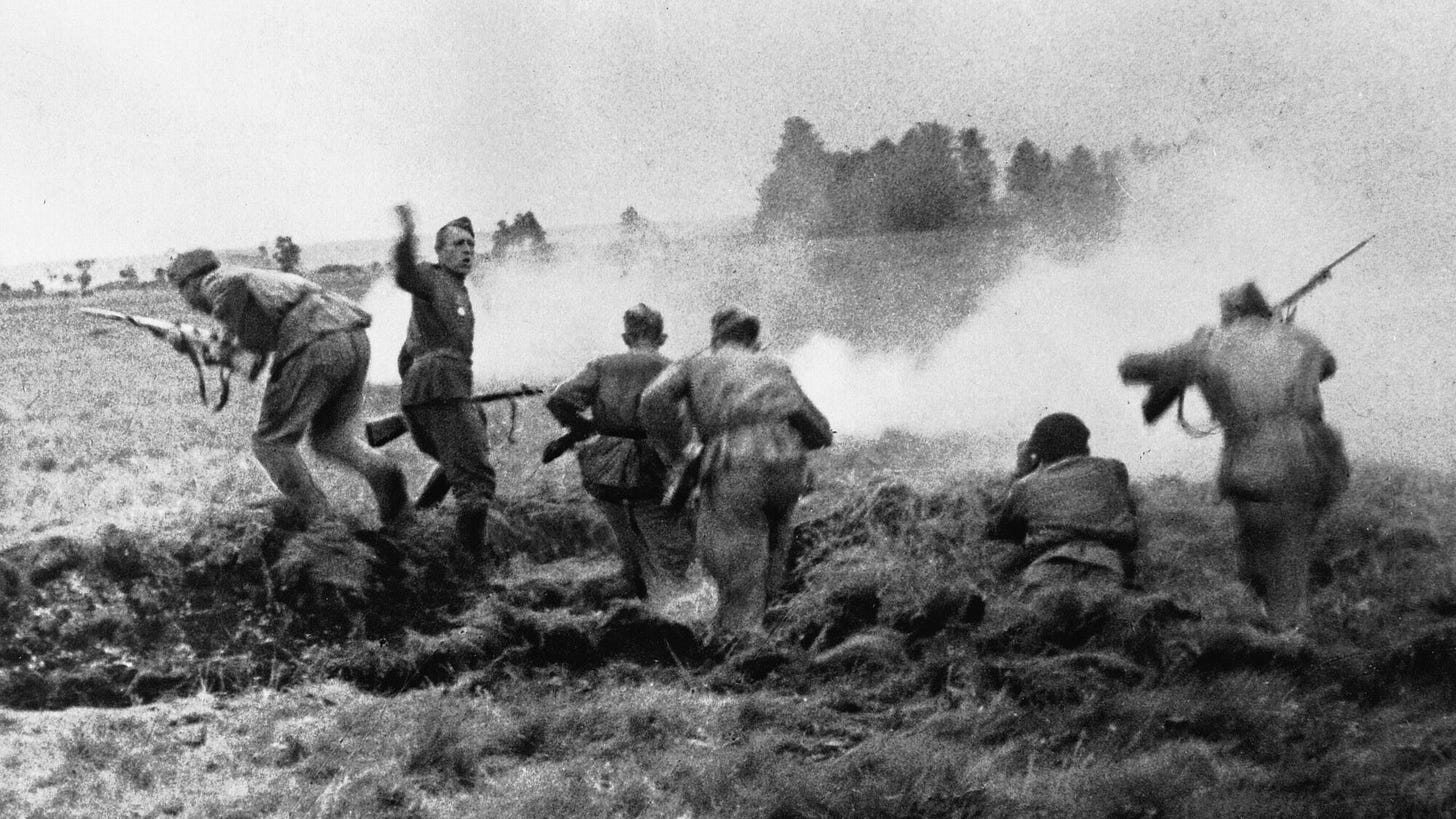
With this level of force concentration by the attackers, there was really little that the Germans could do. Nevertheless, a somewhat lethargic and stiff German response helped make the disaster even worse. 4th Panzer Army headquarters initially believed Konev's opening assault to be only a local attack - later defensively arguing that "there were as yet no signs of the attack being extended to other sections of the front" - and so attempted to respond with local counterattacks by its own reserves. As a result, by the second day of the Soviet offensive the Panzer Army had already committed all of its organic reserves while failing to withdraw from defensive positions that were already compromised. By the time they realized that Konev was launching a serious offensive operation, it was too late. Konev had already bashed into critical seams in the German front, turning his forces into a giant splitting wedge, in place to pry the whole front open.
As always, the price for lethargy among command staff is paid by the ordinary enlisted men. In this case, the unlucky grouping was German XIII corps, which was swallowed up with almost trivial ease near the city of Brody by great Soviet pincers as they barreled forward towards Lvov. The Corps did not receive orders to withdrawal until it was too late, and remained hung out to dry in an exposed forward position. By July 18, the 65,000 men of the Corps - including the 14th SS Volunteer Division Galicia, made up of Ukrainian volunteers - were firmly wrapped up in a tight pocket. A mere 5,000 of them, at most, would escape the pocket, and the remainder were killed or captured. The commander of the corps, General Hauffe, was captured, but stepped on a mine somewhere along the road as his Soviet captors marched him off to a POW camp. A horrible, but fitting end: with his entire corps either dead or captured, he somehow managed both.
The extermination of an entire corps put a grim cherry on top of the emerging disaster sundae. The Panzer Armies could no longer prevent the emerging penetration by Konev's forces, and the only thing to do was withdraw. In this case, 1st Panzer Army conducted a tricky but skillfully conducted withdrawal to the south, breaking contact and swinging down into Hungary to escape the grasping tentacles of Konev's front.
The problem, as always, was that by extricating itself from danger 1st Panzer had opened up an enormous gap between itself and its neighbor. 4th Panzer Army was still in place, but now with dangling flanks and all alone. Thus, when Marshal Konstantin Rokossovsky's 1st Belarusian Front launched its attack on July 18, 4th Panzer was in no position to resist. Already overmatched by superior Soviet fighting power, it faced annihilation now that its flanks were wide open. Like 1st Panzer, it was forced to withdraw, this time to the west.
What the Soviets had achieved with their enormous assaults on Army Group North Ukraine was remarkable. By precisely targeting the seams in the German formations, the initial attacks had pried open the German position like a clam, forcing the two panzer armies to retreat in opposite directions - the 1st pulling back to the south towards Hungary, and the 4th withdrawing westward towards Krakow. These diverging withdrawals opened enormous voids in the German line - the official German history of the war simply refers to this sequence of events as "the loss of a continuous front." In a war where the enemy wielded vast mechanized forces, such gaps were fatal.
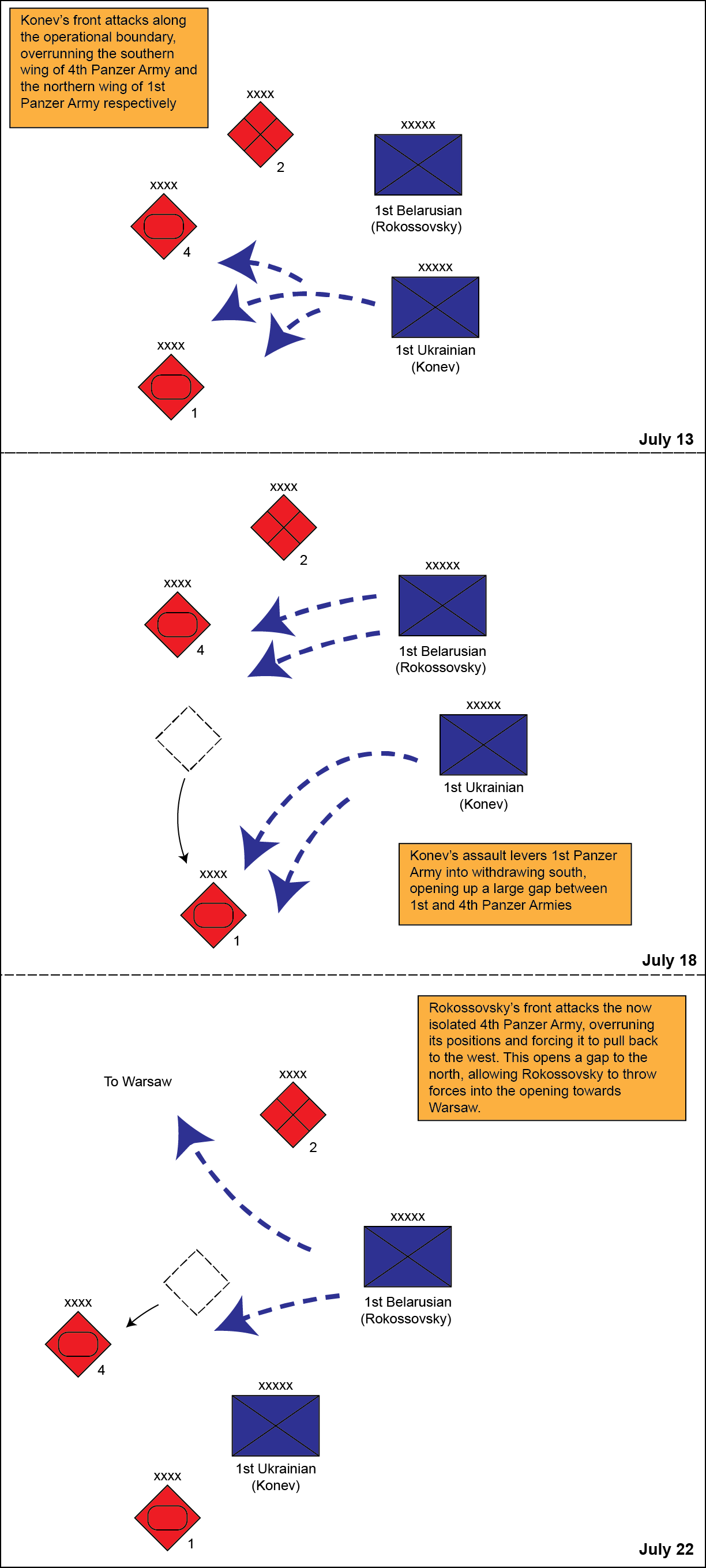
Rokossovsky and Konev had essentially overrun an entire German army group - and the best equipped group in the east, at that - in the space of about ten days, wedging the German line open and creating vast voids to drive into. Most importantly, Rokossovsky now faced one of the more tantalizing opportunities of the entire war. A great space now beckoned him to drive north towards Warsaw, and in his path was only the tired remnant of German second army - a force with no armor whatsoever, caught completely out of position.
Any wargamer could look at the map as Rokossovsky saw it and see that the opportunity to win a seminal, world-historical victory was now within reach. A sharp drive on Warsaw would put him in position to not only capture the city (a major transportation, administrative, and supply base), but also smash through the threadbare German 2nd Army and drive to the Baltic Coast. If he could achieve this, fully half of the German eastern forces would be encircled - the entirety of Army Group North (still fighting on the Baltic Coast) and everything that remained of Army Group Center. Rokossovksy now saw little standing between his powerful Front and one of the greatest encirclements - perhaps the greatest - of all time. No less than six German armies were sitting, naked and vulnerable, on the proverbial silver platter.

The Eastern Front was on the verge of total collapse. If Rokossovsky could bash through Warsaw (a seemingly simple proposition, given the enormous overmatch that he enjoyed over German 2nd Army), he would wipe out half the German eastern army and face no meaningful German forces between him and Berlin.
Enter Walter Model.
Model, as we have written before, was an unsavory and difficult character, even by the standards of late war German generals. However, his prowess as a defensive firefighter was undeniable, and here at the gates of Warsaw that was more evident than ever. Model could read the map just as well as Rokossovsky could, and instantly knew that if 2nd Army was overrun the entire front was liable to begin collapsing.
Fortunately for Model, he had something that no other German general had enjoyed to this point in the war: autonomous theater level command. He'd begun the summer in command of Army Group North Ukraine, but as the situation got worse and worse Hitler made the decision to give Model Army Group Center as well, making him the first commander to enjoy the command of multiple army groups at once. Model also had a unique relationship with Hitler, enjoying something that can even be called "trust", which meant that Model uniquely did not feel the need to constantly ask Hitler for permission to make operational decisions, and was not reprimanded for this temerity.
Thus, as Rokossovsky was driving on Warsaw in full fury, Model was able to exercise a genuinely unique level of theater-wide command authority. He used these powers to immediately begin scrambling Panzer divisions to Warsaw for a counterattack. There were four available - the 4th, 19th, and 5th SS Panzer Divisions were hastily pulled out of their spots on the line and railed towards Warsaw at warp speed, while the Hermann Göring Panzer Division was rushed in from Italy. Taken together, these four divisions possessed just under 300 armored vehicles, but under Model's auspices they were sufficient to save the Germans at Warsaw.
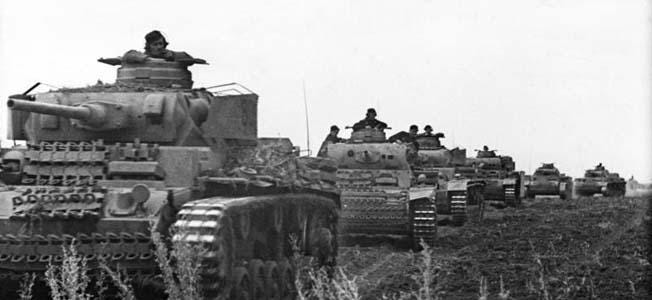
The Warsaw Counterattack had a sort of breathless perfection to it. The platonic ideal of German warfare, as perfected by the halcyon commander Helmuth von Moltke, was "concentric attack" - independent formations attacking the enemy from multiple directions. For nearly a century the Prusso-German command had been attempting to replicate this scheme with varying levels of success. At Warsaw, on August 1, 1944, Model put on one of the last great demonstrations, with a sequence of Panzer divisions scrambling in - seemingly from nowhere - and taking the onrushing column of Rokossovsky's 2nd Tank Army from multiple angles. In the case of the Hermann Göring Division, the Panzers more or less went directly into battle after disembarking their trains. It was a close run thing - a seeming miracle that Model managed to get enough forces deployed in time - but it was enough. Taken by surprise from multiple directions, Rokossovsky's army would lose some 550 of its 800 armored vehicles in the ensuing firestorm, forcing him to withdraw to refit.

In the grand scale of this war, the counterattack at Warsaw can seem very small, even though, with over 1,000 armored vehicles mixing it up in a small area, it was in fact a substantial tank battle. Certainly, the Soviets were shocked to come under tank attack. Rokossovsky was driving his tankers like mad for the twenty mile stretch where the Bug, Narew, and Vistula rivers intersect. Once he secured the crossing of these rivers, he anticipated a drive to the Baltic with little resistance, and the entire German position would fall into his lap. The failure of this maneuver is owed singularly to Model's lightning quick reaction and determination to pull Panzers to Warsaw as fast as possible, no matter what.
It is not an exaggeration to say that Model's actions both saved the Eastern Front from a premature collapse and doomed Warsaw to destruction. With Soviet momentum at last dissipated and Rokossovsky's front working to consolidate its positions, Model was free to turn his attention to Warsaw itself, where the Polish Home Army had launched an uprising in anticipation of immanent German defeat. They, like Rokossovsky, did not know that Model had multiple armored divisions slated for immanent arrival, and were thus bitterly disappointed when their efforts to liberate the city internally collapsed alongside the Soviet offensive. The German response was genuinely horrifying, with the Warsaw garrison destroying fully 85% of the city's buildings in the following two months.

The fact that the Germans were able to almost completely destroy one of Europe's major cities while Red Army forces were stationed only a few miles away has led to one of the enduring tropes of the war: that the Soviets deliberately sat by idly, allowing the Germans to wipe out independent Polish resistance (thus saving the NKVD the trouble of having to do the job). While there is some element of truth here - the Red Army did not attempt to intervene as the Germans brutally put down the Polish resistance - their crime seems to have been simply a matter of choosing military prudence over humanitarian sympathies. The Red Army had, in the space of about six weeks, advanced some 450 miles, and then suffered a defeat in which their spearhead tank army lost nearly 75% of its vehicles. After Model's victory - and the phenomenal dimensions of the Soviet advance - it is not particularly clear what the Red Army might have done to intervene, sitting as they were at the far end of their logistics after weeks of hard fighting.
In either case, Warsaw today remains a veiled and gruesome memorial to Model's victory, and his miraculous rescuing of the eastern front in 1944. The Warsaw that exists today is not real. It exists, of course, with real people occupying physical structures, but the city itself is a replica - a cold war era reconstruction designed to look like the old city. The facsimile is a monument to Model's "greatness."
Model's scramble at Warsaw saved the Eastern Front - for a time. At the moment of maximum danger, he recreated a classic German tactical schema - the blueprint of Konnigratz and Tannenberg - with a swarming, concentric attack by hard hitting battlegroups. Even with the colossal strategic overmatch that now prevailed, Soviet tankers at Warsaw were unable to cope with this basic formula (or the German "Big Cat" tanks at close range). Model's performance at Warsaw - and in stabilizing the western front in the coming months - generally earn him very high marks as a defensive specialist and praise for his operational acumen.
And yet, Model's art of war held no prospect of victory. It was a defensive exigency, designed to cope with major emergencies. The elements of Model's approach - well timed counterattacks, jealously hoarding a mobile reserve, scrounging up rear area personnel to fill out the front - these were all firefighting measures which lacked an offensive component, and were always ultimately self-defeating. They could yield impressive results in that they staunched heavy bleeding, but an army that is rounding up mechanics, administrative and logistics personnel, technicians, and drivers to fill out its infantry formations is an army that is cannibalizing itself, and in the long run this cannot lead to victory. The Soviets had still pushed the frontline forward by hundreds of miles, mauled or encircled half a dozen German armies, and bent the eastern army beyond repair. Model's victory thus served only as a delaying action of sorts, and a bitter one at that for the residents of Warsaw.
The Great ShatteringIf German high command thought that Model's counterattack at Warsaw might have bought them some respite, they were sorely mistaken. Soviet offensives to that point had focused heavily on the central sectors of the front, in Soviet Belarus, Western Soviet Ukraine, and Poland. This had pushed the center of the front far to the west, while the Germans continued to hold eastern positions on the wings of the front. So while in the center the Soviets had advanced all the way to the gates of Warsaw, the Germans still had major field formations nearly 300 miles to the east, including in the Narva Isthmus in Northern Estonia, and on the shore of the Black Sea in Romania.
Soviet activity throughout the autumn of 1944 would focus on caving in these positions, and would achieve extraordinary results. No fewer than four German field armies would be encircled, and Germany's remaining Axis partners would be run out of the war. The Red Army would capture many of Eastern Europe's great cities: Bucharest on August 31 and Belgrade on October 14, with Budapest besieged in December. What remained of Hitler's eastern empire was dismantled by force of arms, and replaced with a more powerful Soviet Empire.
1 Dec 2023 | 12:18 am
8. The End of Cabinet War

The century intervening from the fall of Napoleon in 1815 to the beginning of the First World War in 1914 is usually regarded as a sort of golden age for Prusso-German militarism. In this period, the Prussian military establishment won a series of spectacular victories over Austria and France, establishing an aura of German military supremacy and realizing the dream of a unified Germany through force of arms. Prussia in this era also produced three of history's iconic military personalities - Carl von Clausewitz (a theoretician), Helmuth von Moltke (a practitioner), and Hans Delburk (a historian).
As the story usually goes, this century of victory and excellence created a sense of hubris and militarism in the Prusso-German establishment which led the country to march impetuously to war in the August of 1914, only to founder in a terrible war in which new technologies frustrated its idealized approach to warmaking. Pride, as they say, goes before the fall.
This is an interesting and satisfying story, which posits a rather traditional hubris-downfall cycle. To be sure, there is an element of truth to it, as there were many elements of German leadership which possessed an unseemly degree of overconfidence. However, this was far from the only emotion. There were also many prominent pre-war German thinkers who professed fear, anxiety, and unmitigated dread. They had valuable ideas to teach their colleagues - and perhaps us.
Let's go back, all the way to 1870, to the Franco-Prussian War.
This conflict is generally considered the magnum opus of the titanic Prussian commander, Field Marshal Helmuth von Moltke. Exercising deft operational control and an uncanny sense of intuition, Moltke orchestrated an aggressive opening campaign which sent Prusso-German armies streaming like a mass of tentacles into France, trapping the primary French field army in the fortress of Metz in the opening weeks of the war and besieging it. When the French Emperor, Napoleon III, marched out with a relief army (comprising the rest of France's battle-worthy formations), Moltke hunted that army down as well, encircling it at Sedan and taking the entire force (and the emperor) into captivity.
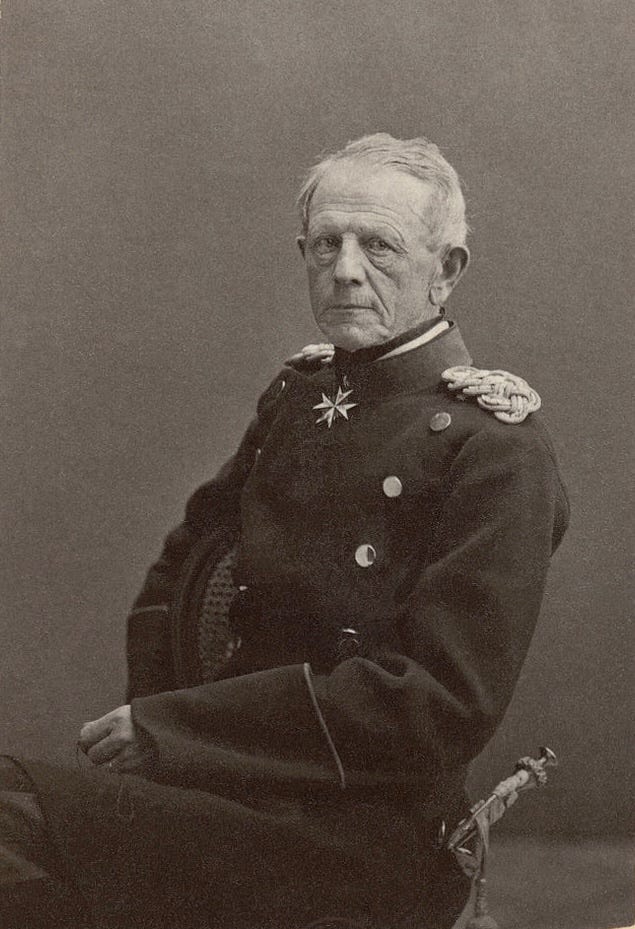
From an operational perspective, this sequence of events was (and is) considered a masterclass, and a major reason why Moltke has become revered as one of history's truly great talents (he is on this writer's Mount Rushmore alongside Hannibal, Napoleon, and Manstein). The Prussians had executed their platonic ideal of warfare - the encirclement of the main enemy body - not once, but twice in a matter of weeks. In the conventional narrative, these great encirclements became the archetype of the German kesselschlacht, or encirclement battle, which became the ultimate goal of all operations. In a certain sense, the German military establishment spent the next half-century dreaming of ways to replicate its victory at Sedan.
This story is true, to a certain extent. My objective here is not to "bust myths" about blitzkrieg or any such trite thing. However, not everyone in the German military establishment looked at the Franco-Prussian War as an ideal. Many were terrified by what happened after Sedan.
By all rights, Moltke's masterpiece at Sedan should have ended the war. The French had lost both of their trained field armies and their head of state, and ought to have given in to Prussia's demand (namely, the annexation of the Alsace-Lorraine region).
Instead, Napoleon III's government was overthrown and a National Government was declared in Paris, which promptly declared what amounted to a total war. The new government abandoned Paris, declared a Levee en Masse - a callback to the wars of the French Revolution in which all men aged 21 to 40 were to be called to arms. Regional governments ordered the destruction of bridges, roads, railways, and telegraphs to deny their use to the Prussians.
Instead of bringing France to its knees, the Prussians found a rapidly mobilizing nation which was determined to fight to the death. The mobilization prowess of the emergency French government was astonishing: by February, 1871, they had raised and armed more than 900,000 men.
Fortunately for the Prussians, this never became a genuine military emergency. The newly raised French units suffered from poor equipment and poor training (particularly because most of France's trained officers had been captured in the opening campaign). The new mass French armies had poor combat effectiveness, and Moltke managed to coordinate the capture of Paris alongside a campaign which saw Prussian forces marching all over France to run down and destroy the elements of the new French Army.
Crisis averted, war won. All was cozy in Berlin, it would seem?
Far from it. While many were content to shake hands and congratulate each other on a job well done, others saw something horrifying in the second half of the war, and the French mobilization program. Surprisingly, Moltke himself was among this party.
Moltke viewed the ideal form of war as something which the Germans call a Kabinettskriege. Literally a Cabinet War, this referred to the limited wars which dominated affairs for much of the 16th through 19th centuries. The particular form of these wars was a conflict between the professional militaries of states and their aristocratic leadership - no mass levies, no horrible scorched earth, no nationalism or mass patriotism. For Moltke, his earlier war against Austria was an ideal example of a Cabinet War: the Prussian and Austrian professional armies fought a battle, the Prussians won, and the Austrians agreed to Prussia's demands. There was no declaration of a blood feud or a guerilla war, but instead a vaguely chivalrous acknowledgment of defeat and limited concessions.
What happened in France, in contrast, was a war which began as a Kabinettskriege and devolved into a Volkskriege - a people's war, and thus had brought into question the entire concept of the limited Cabinet War altogether. As Moltke put it:
The days are gone by when, for dynastic ends, small armies of professional soldiers went to war to conquer a city, or a province, and then sought winter quarters or made peace. The wars of the present day call whole nations to arms…
As Moltke saw it, the only solution to a Volkskriege was to respond with a "War of Extermination." Now at this, many will no doubt bristle, but Moltke was unequivocally not suggesting genocide. He meant something closer to the destruction of the French resource base - dismantling the state, destroying its material wealth, and arranging its affairs. In essence, he called for something like what Germany imposed on France in 1940 - Hitler did not try to annihilate the French population, but neither did he simply take a few territories and walk away. Instead, France as an independent state was steamrolled.
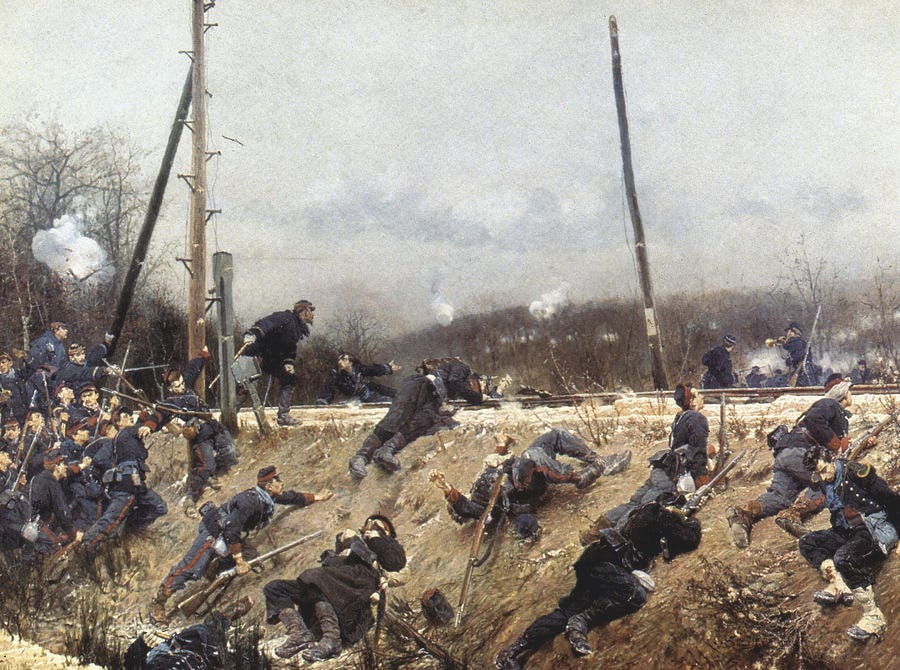
Moltke argued in 1870-71 that pursuing limited war aims against France no longer made sense, since the entire French nation was now aroused in anger at Prussia-Germany. The French, he argued, would never forgive Prussia for taking the Alsace region, and would become intractable enemies. Therefore, France had to be leveled as a military-political entity or else it would simply rise again and become a dangerous enemy very soon. Unfortunately for Moltke, the Prussian Chancellor, Otto von Bismarck, wanted a fast resolution to the war and was not interested in trying to occupy and humiliate France. He told Moltke to hunt down the new French army and get it over with, so Moltke did.
However, Moltke's basic fear - that a limited war would do no lasting damage to France as a threat - proved true. It took only a few years for the French to completely rebuild their military - by 1875, Moltke and his staff estimated that the window of opportunity was closed and France was fully prepared to fight another war.
Meanwhile, from a military perspective, there were many in the Prussian establishment who were terrified by France's success mobilizing an emergency army. Prussia's victory, they argued, was possible only because the French mobilization had been improvised - lacking weapons and training. A nation that was prepared to mobilize and arm millions of men in repetitive conscriptions, with the requisite logistics and training infrastructure, might be nearly impossible to defeat, they argued, and put the entire framework of Prussian war-making in question.
The idea was so important that Moltke dedicated much of his final pre-retirement speech to the Reichstag to the topic. As he put it on that oft-quoted occasion:
The age of Kabinettskriege is behind us - all we have now is Volkskrieg, and any prudent government will hesitate to bring about a war of this nature with all its incaluclable consequences… If war should break out… no one can estimate its duration or see when it will end. The greatest powers of Europe, which are armed as never before, will fight each other. None can be annihilated so completely in one or two campaigns that it would declare itself vanquished and be compelled to accept hard conditions for peace.
Such a statement seems to, and indeed does run contrary to the perception of Germany as overconfident and belligerent, and to the idea that all were taken aback by the length and savagery of the world war. In fact, Germany's most revered prewar practitioner explicitly predicted a gruesome, totalizing, and lengthy war.
Other members of Moltke's staff pontificated more explicitly on the threat of people's war, or total war. Field Marshal Colmar von der Goltz was the most prolific of these, and wrote extensively on the French mobilization project, arguing that the French could have easily swamped the Germans if they had possessed the capacity to properly train and supply their new armies. His general thesis was that future wars would necessarily involve the whole resources of the state, and Germany ought to lay the groundwork to train and sustain mass armies for years of conflict.
In the years leading up to World War One, a minority wing of the German establishment arose which was remarkably clearsighted about the coming conflict, and argued that it would be won via total strategic attrition, with the full resources of the battling nations mobilized over many years. Functionally, the German military apparatus became split between a preeminent majority which looked to the first half of the Franco-Prussian War (with Moltke's massive victories) as the model, and a less prominent but vocal minority which dreaded the portents of France's national mobilization and feared a future of "people's war."
All of that is endlessly interesting to the aficionados of military history and the disciples of mankind's bloody record of war-making. What is interesting for our purposes, however, is the argument between Moltke and Bismarck in the waning months of 1870. Moltke saw clearly that France's patriotic animosity had been aroused and believed that a limited war would be counterproductive, in that it would fail to substantively weaken France in the long run, leaving an intact and vengeful enemy. This calculation proved essentially correct, and France was able to provision a powerful war effort in the world war. In contrast, Bismarck favored a limited war with limited aims, commensurate with the political situation at home. It is not an exaggeration to say that the decision to favor domestic political conditions over long-term strategic calculations cost Germany its chance at world power and led to defeat in the world wars.
Obviously what I have woven for you here is thinly veiled historical analogy.
Russia began a Kabinettskriege in 2022 when it invaded Ukraine, and found itself mired in something closer to a Volkskriege. Russia's mode of operation and war aims would have been instantly recognizable to a 17th Century statesman - the Russian professional army attempted to defeat the Ukrainian professional army and achieve limited territorial gains (the Donbas and recognition of Crimea's legal status). They called this a "special military operation."
Instead, the Ukrainian state has decided - like the French National Government - to fight to the death. To Bismarck's demands for Alace-Lorraine, the French simply said "there can be no reply but Guerre a Outrance" - war to the utmost. Putin's cabinet war - limited war for limited aims - exploded into a national war.
Unlike Bismarck, however, Putin has opted to see Ukraine's raise. My suggestion - and it is only that - is that Putin's dual decisions in the autumn of last year to announce a mobilization and to annex the disputed Ukrainian territories amounted to a tacit agreement to Ukraine's Volkskrieg.

In the debate between Moltke and Bismarck, Putin has chosen to follow Moltke's lead, and wage the war of extermination. Not - and again we stress this - a war of genocide, but a war which will destroy Ukraine as a strategically potent entity. Already the seeds are sown and the fruit begins to bud - a Ukrainian democide, achieved through battlefield attrition and the mass exodus of prime age civilians, an economy in shambles and a state that is cannibalizing itself as it reaches the limits of its resources.
There is a model for this - ironically, Germany itself. After the Second World War, it was decided that Germany - now held to account for two terrible conflagrations - could simply not be allowed to persist as a geopolitical entity. In 1945, after Hitler shot himself, the allies did not demand the spoils of a Cabinet War. There was no minor annexation here, no redrawn border there. Instead, Germany was annihilated. Her lands were divided, her self-governance was abolished. Her people lingered on in a stygian exhaustion, their political form and life now a plaything of the victor - precisely what Moltke wanted to do to France.
Putin is not going to leave a geostrategically intact Ukraine which will seek to retake the Donbas and exact revenge, or become a potent forward base for NATO. Instead, he will transform Ukraine into a Trashcanistan that can never wage a war of revanchism.
Clausewitz warned us. He too wrote of the danger of a people's war. He spoke of the French revolution thus:
Now war stepped forth in all its raw violence.
War was returned to the people who to some extant had been separated from it by professional armies; war cast off its shackles and crossed the bounds of what had once seemed possible.
15 Nov 2023 | 10:41 pm
9. Russo-Ukrainian War: The Reckoning
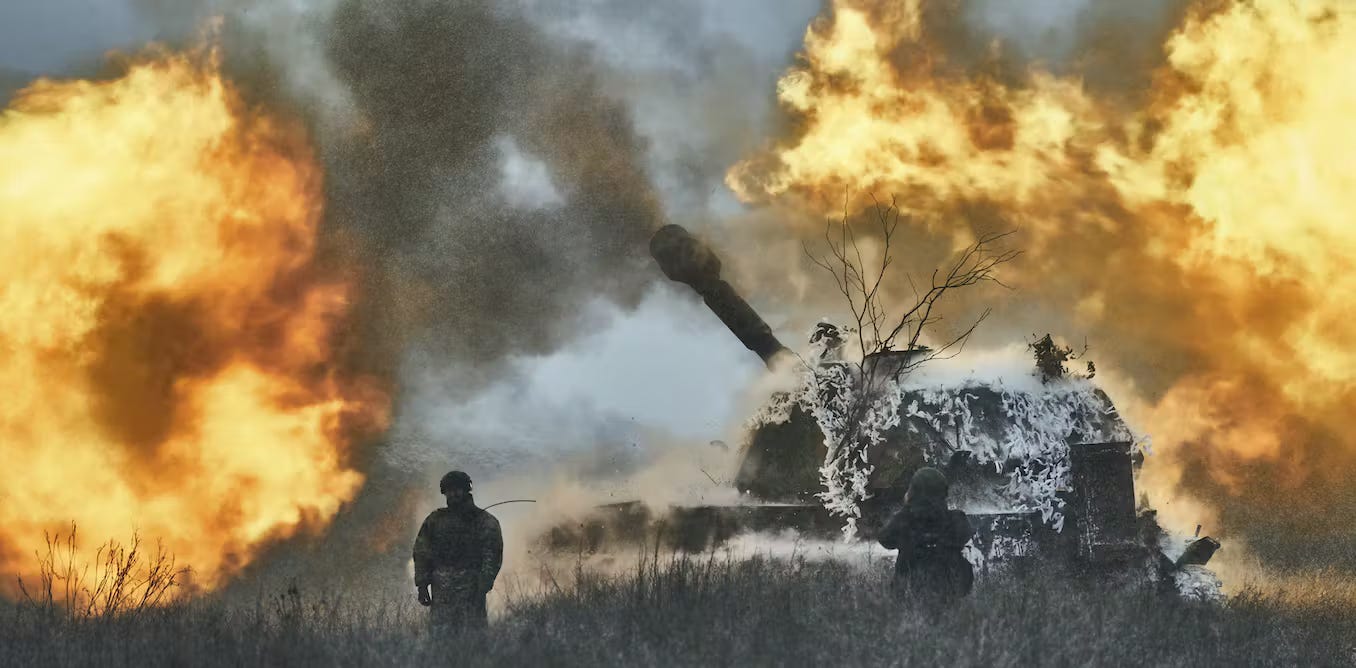
The Russo-Ukrainian War has been a novel historical experience for a variety of reasons, and not only for the intricacies and technicalities of the military enterprise itself. This became the first conventional military conflict to occur in the age of social media and planetary cinematography (that is, the ubiquitous presence of cameras). This brought a veneer (though only a veneer) of immanence to war, which for millennia had unveiled itself only through the mediating forces of cable news, print newspapers, and victory steles.
For the eternal optimist, there were upsides to the idea that a high intensity war was slated to be documented in thousands of first-person view videos. Purely from the standpoint of intellectual curiosity (and martial prudence), the flood of footage from Ukraine offers insight into emerging weapons systems and methods and allows for a remarkable level of tactical-level data. Rather than waiting for years of agonizing dissection of after action reports to reconstruct engagements, we are aware in near real time of tactical movements.
Unfortunately, all the obvious downsides of airing a war live on social media were also in effect. The war instantly became sensationalized and saturated with fake, fabricated, or incorrectly captioned videos, cluttered with information that most people are simply not equipped to parse through (for obvious reasons, the average citizen does not have extensive experience differentiating between two post-Soviet armies using similar equipment and speaking similar, or even the same language), and pseudo-expertise.
More abstractly, the war in Ukraine was transformed into an American entertainment product, complete with celebrity wonder weapons (like Saint Javelin and the HIMARS), groan-inducing references to American pop culture, visits from American celebrities, and voiceovers from Luke Skywalker. All of this fit very naturally with American sensibilities, because Americans ostensibly love underdogs, and in particularly spunky underdogs who overcome extreme odds through perseverance and grit.
The problem with this favored narrative structure is that underdogs rarely win wars. Most major peer conflicts do not have the conventional Hollywood plot structure with a dramatic turning point and reversal of fortune. Most of the time, wars are won by the more powerful state, which is to say the state with the ability to mobilize and effectively apply more fighting power over a longer period of time. This has certainly been the case in American history - no matter how much Americans may long to recast themselves as a historical underdog, America has historically won its wars because it has been an exceptionally powerful state with irresistible and innate advantages over its enemies. This is nothing to be ashamed of. As General George Patton famously said: Americans love a winner.
Thus we arrived at a convolution situation where, despite Russia's many obvious advantages (which in the end come down to a superior indigenous capacity to mobilize men, industrial output, and technology), it became "propaganda" to argue that Russia was going to achieve some sort of victory in Ukraine - that Ukraine would end the war having failed to re-attain its 1991 borders (Zelensky's stated victory condition) and with the country in a wrecked state of demographic hollowing and material destruction.
At last, we seem to have reached a denouement phase, where this view - allegedly an artifact of Kremlin influence, but in reality the most straightforward and obvious conclusion - is becoming inescapable. Russia is a bigger fighter with a much bigger bat.
The case for Ukraine's victory rested almost entirely on dramatic success in a summer counteroffensive, which was supposedly expected to smash its way through the Russian positions in Zaporizhia Oblast, knife to the Sea of Azov, sever Russia's land bridge to Crimea, and place the entire underbelly of Russia's strategic position in jeopardy. A whole host of assumptions about the war were to be tested: the supremacy of western equipment, Russia's paucity of reserves, the superiority of Western-Ukrainian tactical methods, the inflexibility and incompetence of Russian commanders in the defense.
More generally - and more importantly - this was intended to prove that Ukraine could successfully attack and advance against strongly held Russian positions. This is obviously a prerequisite for a Ukraine strategic victory. If the Ukrainian armed forces cannot advance, then Ukraine cannot restore its 1991 boundaries and the war has transformed from a struggle for victory into a struggle for a managed or mitigated defeat. The issue ceases to be whether Ukraine will lose, and becomes a question only of how much.
Ukraine's Summer CalamityWestern observers are at long last beginning to engage with the fact that Ukraine's summer counteroffensive devolved into an abject failure and a military defeat of historical significance. It's important to remember that, prior to the start of the operation, there were real expectations both among Ukrainian officials and western backers that the offensive could achieve the isolation or blockading of Crimea, if not its outright recapture. Underpinning this optimistic outlook were key assumptions about the superiority of western-gifted armored vehicles and a Russian army that was supposedly beginning to run dry. A purportedly leaked Ukrainian Order of Operations memorandum intimated that the AFU intended to reach and mask major cities like Berdyansk and Melitopol.
Remembering that the Ukrainians and their benefactors genuinely believed that they could reach the Azov coast and create an operational crisis for Russia is very important, because only in the context of these objectives can the letdown of the attack be fully comprehended. We are now (as of my typing of this sentence) at D+150 from the initial massed Ukrainian assault on the night of June 7-8, and the gains are paltry to say the least. The AFU is stuck in a concave forward position, wedged between the small Russian held villages of Verbove, Novoprokopivka, and Kopani, unable to advance any further, taking a steady trickle of losses as it attempts half-hearted small unit attacks to cross the Russian anti-tank ditches that ring the edges of the fields.
At the moment, the maximum advance achieved by the counteroffensive lies just ten miles from the town of Orikhiv (in the Ukrainian staging area). Ukraine failed not only to reach its terminal objectives, but it never even threatened its intermediate waypoints (like Tokmak). In fact, they never created even a temporary breach in Russia's defenses. Instead, the AFU threw the bulk of the newly formed and western-equipped 9th and 10th Corps against fixed positions of the Russian 58th, 35th, and 36th Combined Arms Armies, became embedded in the outer screening line, and the attack collapsed after heavy casualties.

As the autumn began to drag on without battlefield results materializing for Ukraine, the process of finger pointing began with remarkable predictability. Three distinct lines of thought emerged, with observers in the west blaming a supposed Ukrainian inability to implement western tactics, some Ukrainian parties countering that western armor was too slow to arrive, which gave the Russian army time to fortify its positions, and others arguing that the problem was that the west failed to provide the necessary aircraft and strike systems.
I think that all of this rather misses the point - or rather, all of these factors are merely tangential to the point. The various Ukrainian and western figures pointing fingers at each other are rather like the proverbial blind men describing an elephant. All of these complaints - insufficient training, slow delivery timetables, shortages of air and strike assets - merely reflect the larger problem of attempting to assemble on an improvised basis an entirely new army with a hodgepodge of mismatched foreign systems, in a country with dwindling demographic and industrial assets.
All that aside, the internecine quarreling in the Ukrainian camp obscures the importance of tactical factors and ignores the highly active role that the Russian armed forces played in spoiling Ukraine's great attack. While the dissection of the battle is likely to continue for many years, a litany of tactical reasons for Ukrainian defeat can already be enumerated as follows:
The failure of the AFU to achieve strategic surprise. Notwithstanding an ostentatious OPSEC effort and attempted feint operations on the Belgorod border, around Bakhmut, Staromaiorske, and elsewhere, it was readily apparent to all involved that the point of the main Ukrainian effort would be towards the Azov littoral, and specifically the Orikhiv-Tokmak axis. Ukraine attacked precisely where they were expected to.
The danger of staging and approach in the 21st century. The AFU had to congregate assets under exposure to Russian ISR and strike assets, which repeatedly subjected Ukrainian rear areas (like Orikhiv, where ammunition dumps and reserves were repeatedly struck) to Russian fire, and allowed the Russians to routinely take deploying Ukrainian battlegroups under fire while they were still in their marching columns.
Inability (or unwillingness) to commit sufficient mass to force a decision. The density of the Russian ISR-Fires nexus incentivized the AFU to disperse its forces. While this can reduce losses, it also meant that Ukrainian combat power was introduced in a piecemeal trickle which simply lacked the mass to ever seriously threaten the Russian position. The operation largely devolved into company-level attacks which were clearly inadequate for the task.
Inadequacy of Ukrainian fires and suppression. A fairly self-evident and all-encompassing capabilities gap, with the AFU facing a shortage of tubes and artillery shells (forcing HIMARS into a tactical role as an artillery substitute), and lacking sufficient air defense and electronic warfare assets to mitigate the variety of Russian airborne systems, including drones of all types, attack helicopters, and UMPK bombs. The result was a series of under-supported Ukrainian maneuver columns being raked in a firestorm.
Inadequate combat engineering, which left the AFU vulnerable to a web of Russian minefields that were evidently far more robust than expected.
Taken together, we actually have a fairly straightforward tactical conundrum. The Ukrainians attempted a frontal assault on a fixed defense without either the element of surprise or parity in ranged fires. With the Russian defense fully on alert and Ukrainian staging areas and approach lanes subject to intense Russian fires, the AFU dispersed its forces in an effort to reduce losses, and this all but ensured that the Ukrainians would never have the necessary mass to create a breach. Add it all up, and you get the summer of 2023 - a series of frustrating and fruitless attacks on the exact same sector of the defense, slowly frittering away both the year and Ukraine's best, last hope.
The failure of Ukraine's offensive has seismic ramifications for the future conduct of the war. Combat operations always occur in reference to Ukraine's political objectives, which are - to put it bluntly - ambitious. It's important to remember that the Kiev regime has maintained from the very beginning that it would not settle for anything less than the 1991 territorial maximum of Ukraine - implying not only the recovery of the territory occupied by Russia after February 2022, but also the subjugation of the separatist polities in Donetsk and Lugansk and the conquest of Russian Crimea.
Ukraine's war aims have always been defended as reasonable in the west for reasons related to the supposed legal niceties of war, the western illusion that borders are immutable, and the apparent transcendent divinity of Soviet-era administrative boundaries (which after all were the source of the 1991 borders). Regardless of all these matters, what Ukraine's war aims implied as a practical matter was that Ukraine needed to capture de-facto prewar Russian territory, including four major cities (Donetsk, Lugansk, Sevastopol, and Simferopol). It meant dislodging the Russian Black Sea Fleet from its port somehow. This was an extraordinarily difficult task - far more complicated and more vast than anyone wanted to admit.

The obvious problem, of course, is that given Russia's superior industrial resources and demographic reservoir, Ukraine's only viable pathways to victory were either a Russian political collapse, Russian unwillingness to fully commit to the conflict, or the inflicting of some astonishing asymmetric battlefield defeat on the Russian army. The first now clearly seems like a fantasy, with the Russian economy shrugging off western sanctions and the political cohesion of the state completely unperturbed (even by the Wagner coup), and the second hope was dashed the moment Putin announced mobilization in the autumn of 2022. That leaves only the battlefield.
Therefore, the situation becomes very simple. If Ukraine cannot successfully advance on strongly held Russian positions, it cannot win the war according to its own terms. Thus, given the collapse of Ukraine's summer offensive (and myriad other examples, like the way an ancillary Ukrainian attack banged its head meaninglessly on Bakhmut for months) there is a very simple question to be asked.
Will Ukraine ever get a better opportunity to attempt a strategic offensive? If the answer is no, then it necessarily follows that the war will end with Ukrainian territorial loss.
It seems to be a point of near triviality that 2023 was Ukraine's best opportunity to attack. NATO had to move heaven and earth to scrape together the attack package. Ukraine will not get a better one. Not only is there simply nothing left in the stable for many NATO members, but assembling a larger mechanized force would require the west to double down on failure. Meanwhile, Ukraine is hemorrhaging viable manpower, due to a combination of high casualties, a flood of emigration as people flee a crumbling state, and endemic corruption which cripples the efficiency of the mobilization apparatus. Add it all up and you get a growing manpower squeeze and looming shortages of munitions and equipment. This is what it looks like when an army is attrited.
At the same time that Ukrainian combat power is declining, Russia's is climbing. The Russian industrial sector has dramatically increased output despite western sanctions, leading to belated recognition that Russia is not going to conveniently run out of weapons, and indeed is comfortably out-producing the entire western bloc. The Russian state is in the process of radically raising defense expenditures, which will pay further dividends in combat power as time goes on. Meanwhile, on the manpower front, Russian force generation is stable (IE, does not require an expanded mobilization), and the sudden realization that the Russian army does in fact have plenty of reserves left prominent members of the Commentariat arguing with each other on Twitter. The Russian army is now poised to reap the benefits of its investments over the coming year.

The picture is not overly complicated. Ukrainian combat power is in a decline which has little chance of arrest, particularly now that events in the Middle East mean that it no longer has an uncontested claim to western stocks. There are a few things the west can still do to try and prop up Ukrainian capabilities (more on that later), but Meanwhile, Russian combat power is stable and even rising in many arms (note, for example, the steady increase in Russian UMPK drops and FPV drone strikes, and the growing availability of the T90 tank).
Ukraine will not recover its 1991 borders, and is unlikely to recapture any meaningful territories going forward. Thus, language has shifted sharply from references to retaking lost territories to merely freezing the front. None other than Commander in Chief Zaluzhny has admitted that the war is stalemated (an optimistic construction), while some western officials have begun to float the idea that a negotiated settlement (which would necessarily entail acknowledging the loss of Russian-held territories) may be Ukraine's best path out.
This does not imply that the war is nearing an end. Zelensky continues to be adamantly against negotiations, and there are certainly plenty in the west who support continuing Ukrainian intransigence, but I think rather they are all missing the point.
There is only one way to end a war unilaterally, and that is by winning. It may very well be that the window to negotiate is over, and that Russia is ramping up its spending and expanding its ground and aerospace forces because it intends to use them to attempt a decisive victory on the battlefield.
We will likely see an increasingly vigorous debate in the coming months as to whether or not Kiev ought to negotiate. But the premise of this debate may well be wrong in toto. Maybe neither Kiev nor Washington gets to decide.
Avdiivka: Canary in the Coal MineThe subsidence of Ukraine's summer offensive corresponds to a phase shift in the war, wherein Ukraine will shift to a full-spectrum strategic defense. Almost perfectly on cue, the Russian army kicked off the next sequence by beginning an operation against the crucial and strongly held Ukrainian stronghold of Avdiivka, in the suburbs of Donetsk.
Avdiivka was already in something of a salient, owing to previous Russian operations which had captured the town of Krasnogorivka, to the north of the city. Over the month of October, Russian forces launched a large assault out of these positions and successfully captured one of the key terrain features in the area - a tall mound of discarded mining byproduct (a spoil heap) which directly overlooks the main railway into Avdiivka, and lies adjacent to the Avdiivka coke plant. As of this writing, the situation looks like so:
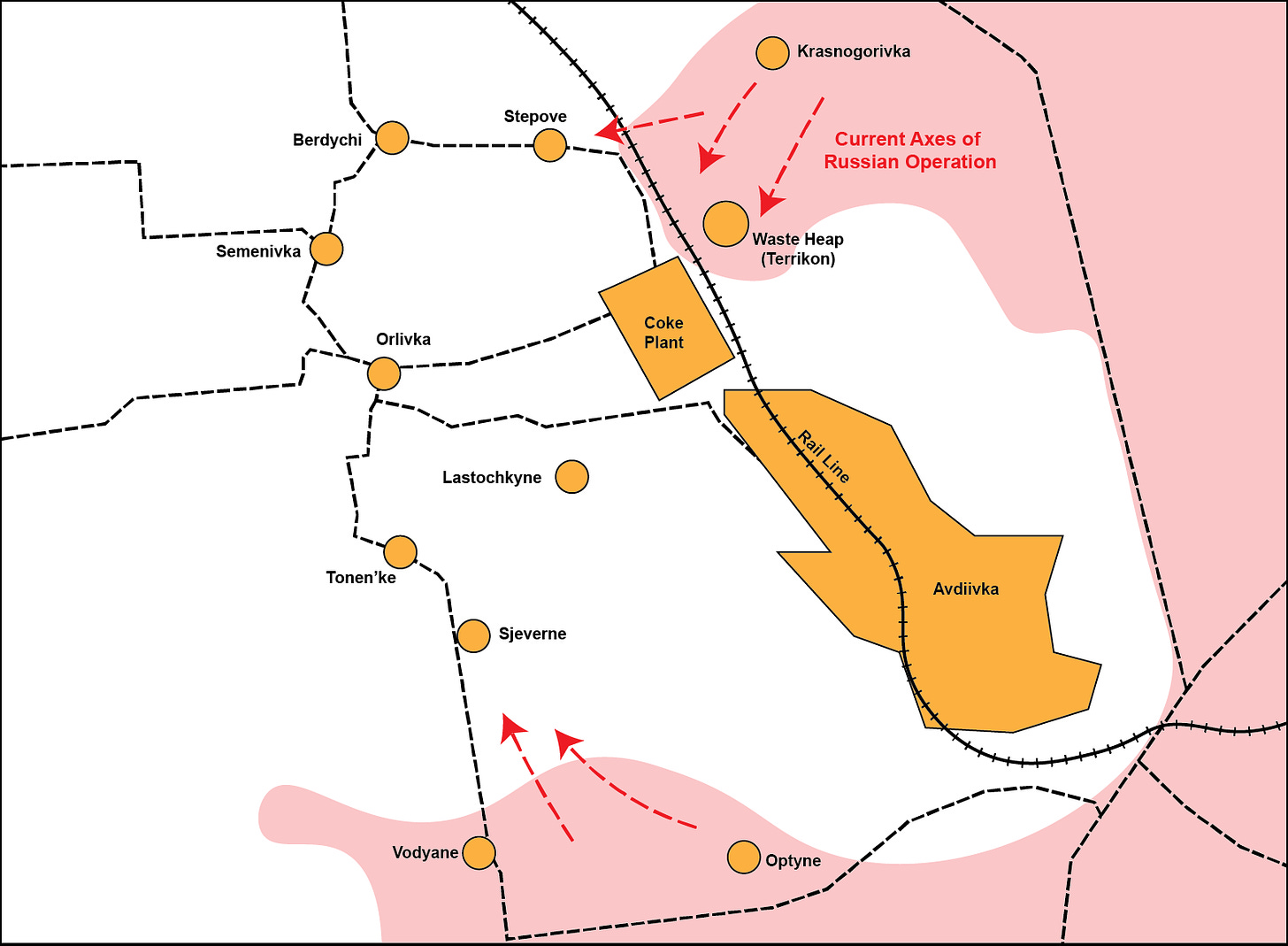
The Avdiivka operation almost immediately spawned a familiar cycle of dooming and histrionics, with many getting ready to compare the attack to Russia's failed assault on Ugledar last winter. Despite successful Russian capture of the waste heap (along with positions along the railway), the Ukrainian sphere was pleased, claming that the Russians are suffering catastrophic losses in their assault on Avdiivka. However, I think that this fails to hold water for a few reasons.
First and foremost, the premise itself does not obviously appear to be true. This war is being eagerly documented in real time, which means we can actually check for a sharp increase in Russian losses in the tabulated data. For this, I prefer to check in with War Spotting UA and their Russian equipment loss tracking project. While they have an overtly pro-Ukrainian orientation (they track only Russian and not Ukrainian losses), I think they are more reliable and reasonable than Oryx, and their tracking methodology is certainly more transparent.
A quick note about their data is important. First, it's incorrect to be overly focused on the precise dates that they ascribe to losses - this is because their logged dates correspond to the date that losses are first photographed, which may or may not be the same day the vehicle is destroyed. When they log a date for a destroyed vehicle, they are logging only the date the picture was taken. It's thus reasonable to pencil in a few days worth of potential error on the dating of losses. This simply can't be helped. Furthermore, they - like anyone else - have the capacity to misidentify or accidentally double count vehicles filmed from different angles.
All that is to say, it's not useful to get too bogged down looking at specific loss clusters and photos, but looking at the trends in their loss tracking is very useful. If Russia was really losing an inordinate amount of equipment in a month-long assault, we would expect to see a spike, or at least a modest level increase in losses.
In fact, that's not apparent in the loss data. Russia's overall burn rate from the summer of 2022 until now comes out to approximately 8.4 maneuver assets per day. Yet the losses for the autumn of 2023 (which includes the Avdiivka assault) are actually slightly lower, at 7.3 per day. There are a few batches of losses, which correspond to the aftermath of assaults, but these are not abnormally large - a fact that can be easily checked by referencing the time series of losses. The data shows a modest increase from the summer of this year (6.8 per day) to the autumn (7.3), which corresponds to a shift from a defensive to an attacking posture, but there is simply nothing in the data here that suggests an abnormal elevation in Russian loss rates. Overall, the loss data suggests a high intensity attack, but the losses overall are lower than in other periods where Russia has been on the offensive.
We can apply the same basic analytic framework to personnel losses as well. Mediazona - an anti-Putinist Russian dissident media outlet - has been dutifully tracking Russian casualties via obituaries, funerary announcements, and social media posts. Lo and behold, they - like Warspotting UA - fail to record an inordinate spike in Russian losses through the Autumn thus far.
Now, it would be silly to deny that Russia lost armored vehicles or that attacking does not incur costs. There is a battle being fought, and vehicles are destroyed in battles. That is not the question here. The question is whether the Avdiivka assault has caused an unsustainable or abnormal spike in Russian losses, and quite simply there is nothing in the tracked loss data that would suggest this. Therefore, the argument that Russian forces are being eviscerated at Avdiivka simply does not seem supported by the available information, and so far the tracked daily losses for Autumn are simply lower than the average over the previous year.
Furthermore, fixation on Russian losses can lead one to forget that the Ukrainian forces get badly chewed up as well, and we actually have videos from the Ukrainian 110th Brigade (the main formation anchoring the Avdiivka defense) complaining that they have taken unsustainable losses. All to be expected with a high intensity battle underway. The Russians attacked in force in force and took proportional losses - but was it worth it?
We need to think about that initial Russian assault in the context of the Avdiivka battlespace. Avdiivka is rather unique in that the entire city and the railway running towards it sit upon an elevated ridge. With the city now enveloped on three sides, remaining Ukrainian logistical lines run along the floor of a wetland basin to the west of the city - the only corridor that remains open. Russia now has a position on the dominating heights that directly overlook the basin, and are in the process of expanding their position along the ridge. In fact, contrary to the claim that the Russian assault collapsed with heavy casualties, the Russians continue to expand their zone of control to the west of the railway, have already breached the outskirts of Stepove, and are pushing into the fortified trench network in southeastern Avdiivka proper.
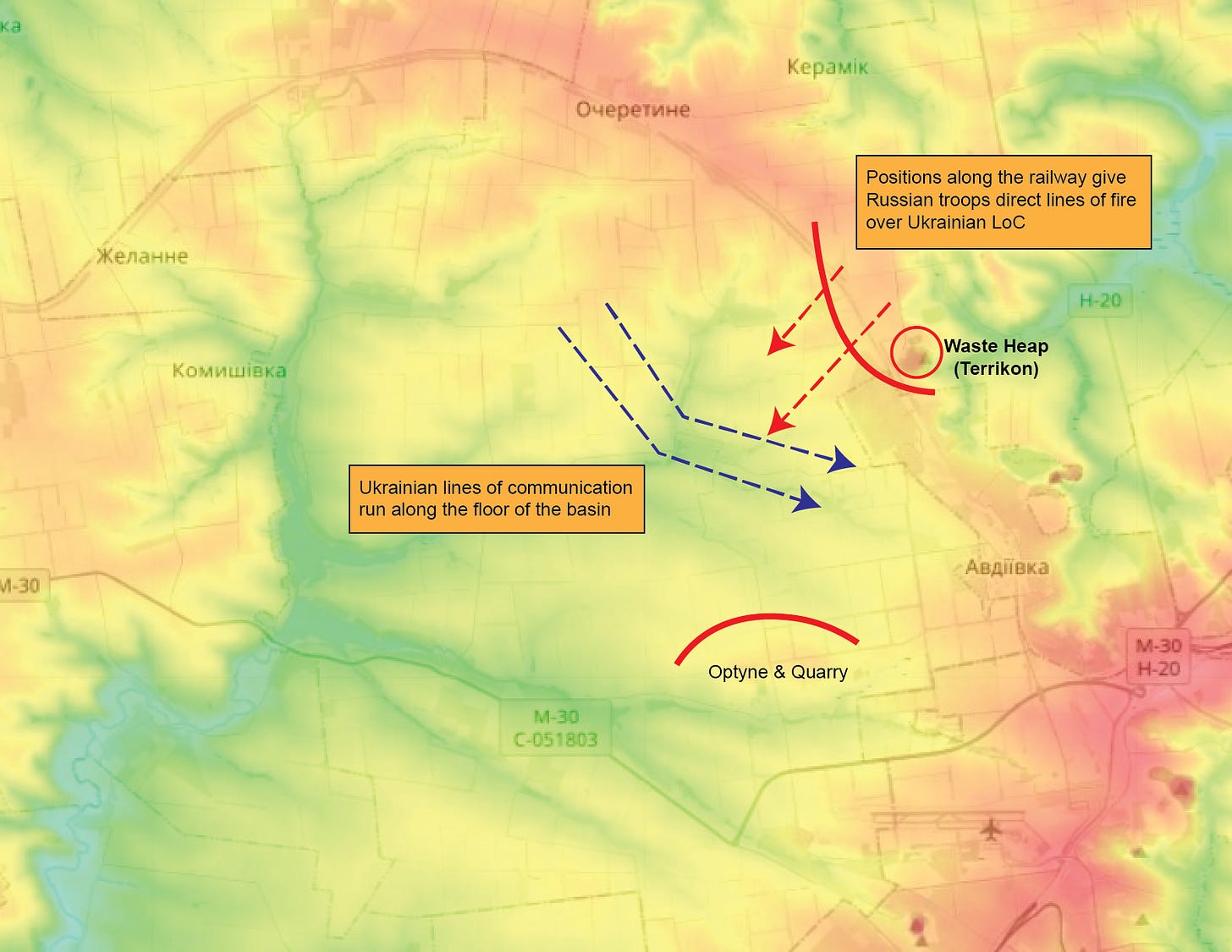
Now, at this point it's probably rational to want to compare the situation to Bakhmut, but the AFU forces in Avdiivka are actually in a much more dangerous position. Much was made of so-called "fire control" during the battle for Bakhmut, with some insinuating that Russia could isolate the city simply by firing artillery at the supply arteries. Needless to say, this didn't quite pan out. Ukraine lost plenty of vehicles on the road in and out of Bakhmut, but the corridor remained open - if dangerous - until the very end. In Avdiivka, however, Russia will have direct ATGM line of sight (rather than spotty artillery overwatch) over the supply corridor on the floor of the basin. This is a much more dangerous situation for the AFU, both because Avdiivka has the unusual feature of a single dominating ridge on the spine of the battlespace, and because the dimensions are smaller - the entire Ukrainian supply corridor here runs along a handful of roads in a 4 kilometer gap.
Clearly, control of the waste heap and the rail line are of paramount importance, so the Russian Army committed a significant assault force to ensure the capture of their key objectives. Attacking the waste heap furthermore required exposing Russian attack columns to perpendicular Ukrainian fire, attacking across well surveilled ground. In short, this entailed many of the tactical problems that plagued the Ukrainians over the summer. Modern ISR-fire linkages make it very difficult to successfully stage and deploy forces without incurring losses.
Unlike the Ukrainians, however, the Russians committed sufficient mass to create an irreversible snowball in the attack on the commanding heights, and Ukrainian fires were inadequate to stymie the assault. Now that they have them, the Russians will recoup losses as the Ukrainians attempt to counterattack - indeed, this has already begun, with UA Warspotting recording a sharp drop in Russian equipment losses over the last three weeks. This establishes the pattern of the operation - a massed assault early to capture keystone positions that put the Russians in control of the battlespace. The Russians successfully forced a decision from the get-go by committing to their attack with a level of violence and force generation that was lacking all summer for the AFU. The juice is worth the squeeze.
More to the point, the Ukrainians clearly know that they are in trouble. They have already begun scrambling premier assets to the area to begin counterattacking against the Russian position on the ridge, and there are already Bradleys and Leopards burning around Avdiivka and in the Ukrainian staging areas in the rear. The same basic problem now exists which proved so insurmountable in the summer: counterattacking Ukrainian forces (staging over ten kilometers in the rear, past Ocheretyne) face long and well-surveilled lines of approach which expose them to Russian standoff fires - the Ukrainian 47th Mechanized Brigade has now already lost armored vehicles both in its staging areas and in failed counterattacks on Russian positions around Stepove.
In the coming weeks, Russian forces will carry their momentum forward into attacks on the axes through Stepove and Sjeverne to the west of the city, leaving the AFU tied to a long and precarious logistical chain on the floor of the basin. One of Ukraine's longest and most strongly held fortresses now threatens to become an operational trap. I don't expect Avdiivka to fall in a matter of weeks (barring an unforeseen and unlikely collapse in the Ukrainian defense), but it is now a matter of time and the winter months will likely bring the steady whittling away of the Ukrainian position here.
Sustaining AFU combat power in the city will be particularly difficult, with Ukrainian "mosquito logistics" (referring to their habit of running supply lift with pickup trucks, vans, and other small civilian vehicles) struggling across the floor of a muddy basin under the watchful eye of Russian FPV drones and direct fire. The AFU will be forced to attempt to sustain a brigade-level defense by running small vehicles through a beaten zone. If the Russians successfully capture the coke plant, the game will end much sooner, but the Ukrainians know this and will make the defense of the plant a preeminent priority - but even so, it is only a matter of time, and once Avdiivka falls, the Ukrainians do not have a solid place to anchor their defense until they fall all the way back to the Vovcha River (Volchya on Russian maps). This is a process that should play itself out through the winter.
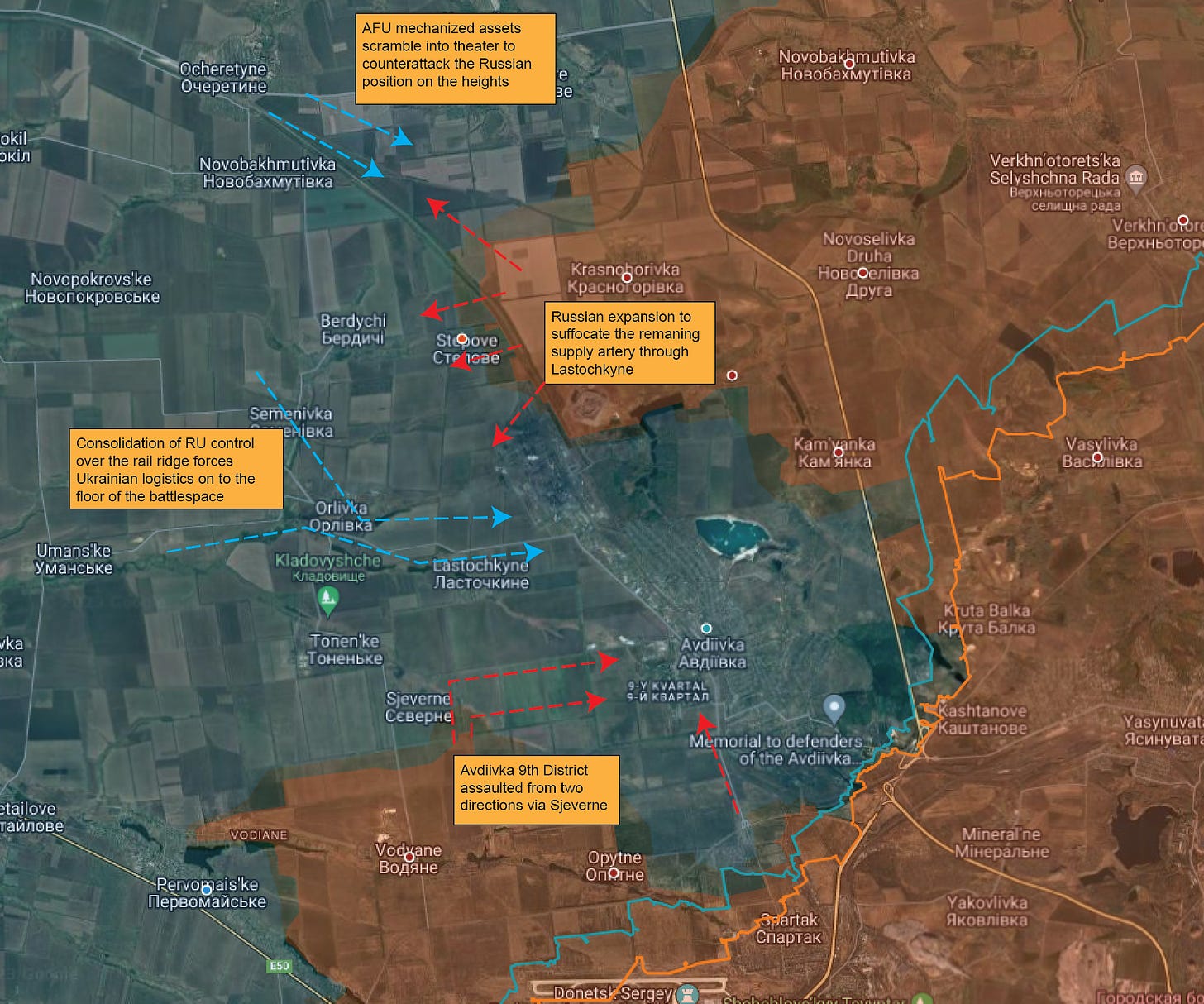
And that begs the question: if Ukraine could not hold Bakhmut, and time proves that they cannot hold Avdiivka, where can they hold? And if Ukraine cannot successfully attack, what are they fighting for?
A failed defense only counts as a delaying action if you have something to look forward to.
Strategic ExhaustionThe war in Ukraine is now transitioning to enter its third phase. The first phase, from the onset of hostilities in February 2022 until the autumn of that year, was characterized by a trajectory of exhaustion of indigenous Ukrainian capacity by the operations of the limited initial Russian force. While Russian forces successfully degraded or exhausted many aspects of the prewar Ukrainian war machine - elements like communications, air defense interceptor stocks, and the artillery park - the initial Russian strategy floundered on critical miscalculations concerning both Ukraine's willingness to fight a long war and NATO readiness to backstop Ukrainian material and provide critical ISR and command & control capabilities.
With the Russians facing with a much larger war than anticipated, and with utterly inadequate force generation for the task, the war took on the character of industrial attrition as it moved into the second phase. This phase was characterized by Russian attempts to shorten and correct the frontline, creating dense fortifications and locking up forces in grinding positional battles. This phase, more generally, was about the Ukrainians attempting to exploit - and the Russians enduring - a period of Ukrainian strategic initiative as Russia moved to a more expansive war footing, expanding armaments production and raisings force generation through mobilization.
In essence, Ukraine faced a dire strategic dilemma from the moment President Putin announced the mobilization of reserves in September, 2022. The Russian decision to mobilize was a de-facto signal that it accepted the new strategic logic of a longer war of industrial attrition - a war in which Russia would enjoy numerous advantages, including a much larger pool of manpower, vastly superior industrial capacity, indigenous production of standoff weaponry, armored vehicles, and shells, an industrial plant beyond the reach of systematic Ukrainian attacks, and strategic autonomy. These, however, are all systemic and long-term advantages. In the shorter term, however, Ukraine enjoyed a brief window of initiative on the ground. This window, however, was squandered with the botched summer assault on Russia's defenses in the south, and the second phase of the war ends alongside the AFU's drive on the Azov shore.
And so we come to the third phase, characterized by three important conditions:
Steadily rising Russian combat power as a result of investments made over the previous year.
Exhaustion of Ukrainian initiative on the ground and increasing self-cannibalization of AFU assets.
Strategic exhaustion in NATO.
The first point is relatively trivial to comprehend and has been freely confessed by western and Ukrainian authorities. It is now well understood that sanctions failed to make a meaningful dent in Russian armaments production, and in fact the availability of critical systems is growing rapidly as a result of strategic investments in new and expanded production lines. However, we can enumerate a few examples of this.
One of the key elements of expanding Russian capabilities has been both the qualitative and quantitative improvement in new standoff systems. Russia has successfully launched mass production of the Iranian-derived Shahed/Geran drone, and has an additional factory under construction. Production of the Lancet loitering munition has risen exponentially, and a variety of improved variants are now entering use, with superior guidance, effective range, and swarming capabilities. Russian production of FPV drones has risen significantly, with Ukrainian operators now fearing a snowballing Russian advantage. UMPK guided glider adaptations have been modified to accommodate much of the Russian arsenal of gravity bombs.

All of this speaks to a Russian military with an expanding capacity to fling high explosives in greater numbers and accuracy at AFU personnel, equipment, and installations. Meanwhile, on the ground, tank production continues to rise, with sanctions having little apparent impact on Russian armor availability. In contrast to previous predictions that Russia would begin scraping the bottom of the barrel, pulling ever older tanks out of storage, Russian forces in Ukraine are fielding *newer* tanks, with the T-90 appearing on the battlefield in greater numbers. And, despite repetitive western predictions that a new mobilization wave would be required in the face of supposedly horrific casualties, the Russian defense ministry has confidently said that its manpower reserves are stable, and a Ukrainian military intelligence spokesman recently said that they believe there are over 400,000 Russian troops in the theater (to which can be added the sizeable reserves that remain in Russia).
Meanwhile, Ukrainian forces are likely to become increasingly self-cannibalizing. This occurs on multiple levels, as a motif of a strategically exhausted force. On the strategic level, self-cannibalization occurs when strategic assets are burned off in the name of short term exigencies; on the tactical level, a similar degradative process occurs when formations remain in combat for too long and begin to grind away as they attempt combat tasks for which they are no longer suited.
You're likely rolling your eyes at that paragraph, and understandably so. It's heavily jargonized, and I apologize for it. However, we can see a concrete example of what both forms of self-cannibalization (strategic and tactical) look like, from the same unit: the 47th Mechanized Brigade.
The 47th was slated long ago to become one of the premier assets in Ukraine's counteroffensive. Trained (as best as time allowed) to NATO standards and with privileged access to high-end western equipment like the Leopard 2A6 Tank and the Bradley IFV. This brigade was both meticulously prepared and widely advertised as the deadly tip of the spear for Ukraine. However, a summer of frustrating and failed attacks on Russia's Zaporizhia line left the brigade with severe losses, degraded combat power, and infighting among the officers.
What followed ought to raise red flags. First, in early October it was reported that the 47th had a new commander, with the change spurred by demands from above that the brigade continue its efforts to attack. The problem was that the 47th had gradually exhausted its attacking potential, and the solution implemented by the new commander was to scrounge the brigade's rear areas and technical crews for replacement manpower. As the MilitaryLand report reads:
As claimed by soldiers of anti-tank missile unit of Magura in now removed video appeal, the brigade's command refuse to admit the brigade lost its offensive potential. Instead, command sends mortar crews, snipers, artillery crews, basically all it has available to the front as assault infantry.
This is a classic example of tactical self-cannibalization, wherein a loss in combat power threatens to accelerate as ancillary and technical elements of the unit are burned off in an attempt to compensate for losses. However, the 47th is also been cannibalized on the strategic level. When the Russian assault around Avdiivka began, the Ukrainian response was to pull the 47th out of the Zaporizhia front and scramble it to Avdiivka to counterattack. At this point, the Ukrainian defense there depends on the 110th Brigade, which has been in Avdiivka for nearly a year without relief, and the 47th, which was already degraded from months of continuous offensive operations in the south.
This is strategic cannibalization: taking one of the premier assets in the stable and rushing it, with no rest or refitting whatsoever, directly into combat as a defensive exigency. Thus, you have the 47th Brigade being cannibalized on an internal level (burning itself off as it attempts combat tasks that it is no longer appropriately equipped for) and on a strategic level, with the AFU grinding it down in a positional defense around Avdiivka rather than rotating it out for rest and refit to be earmarked for future offensive operations. A recent report with interviews of 47th personnel painted a dire picture: the brigade had lost over 30% of its personnel over the summer and its howitzers are rationed to a mere 15 shells per day. Russian mortars, they say, have an eight to one advantage.
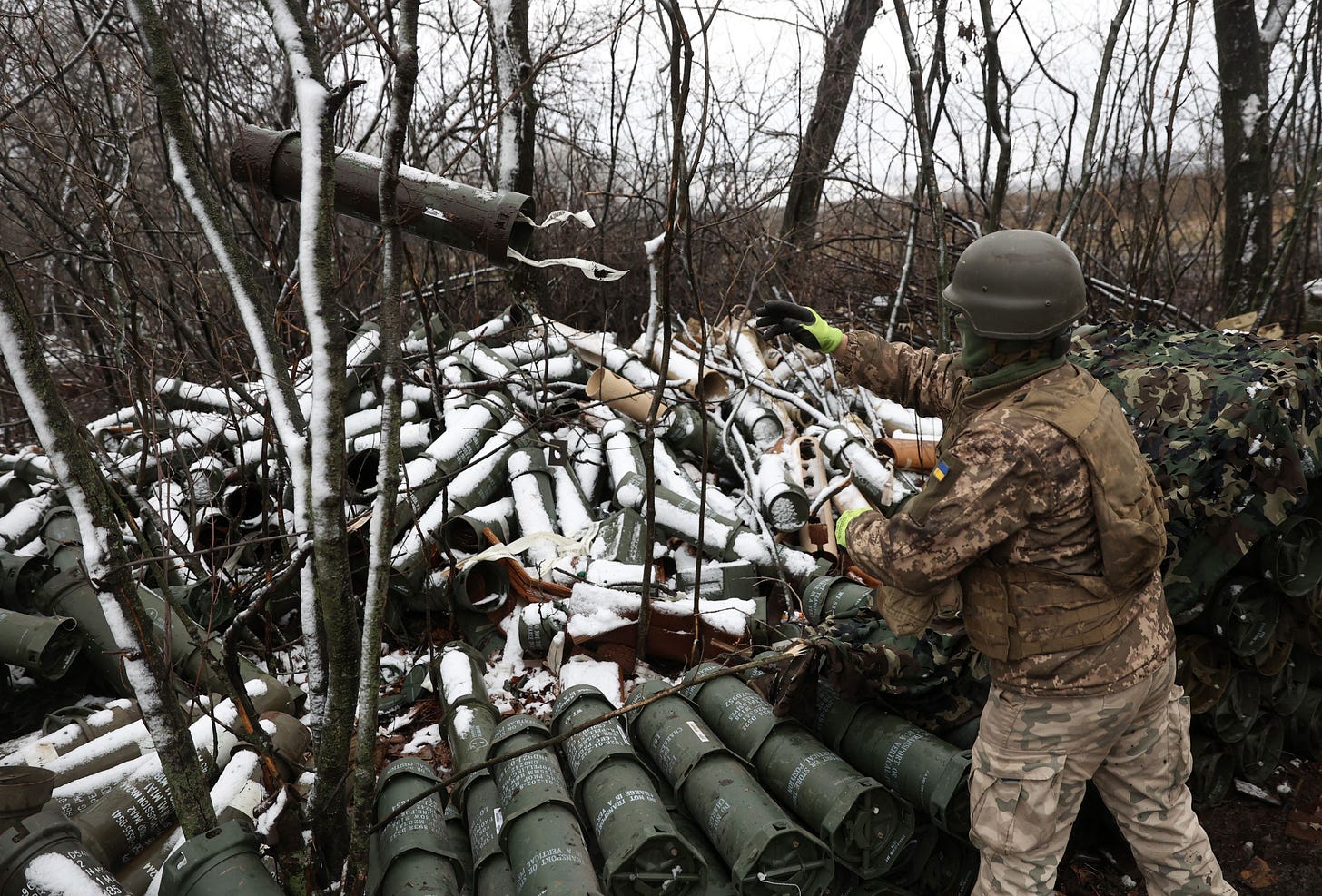
The situation can be vaguely likened to a person in crisis, who wears themselves down biologically and emotionally through a lack of sleep and stress, while also burning away their assets - selling their car and other critical possessions to pay for immediate necessities like food and medicine. This is an unsustainable way to live, and cannot stave off catastrophe indefinitely.
The Russians are doing everything they can to encourage this process, methodically reactivating grinding attacking operations across the breadth of the front, including not only Avdiivka but also at Bakhmut and Kupyansk, in an intentional pinning program designed to keep Ukrainian assets in combat after being exhausted over the summer. The 47th is emblematic of this - attacking all summer only to immediately be scrambled into defense in the Donbas. As one associate of mine put it, the last thing you want to do after running a marathon is begin a sprint, and this is where the Ukrainians find themselves after losing the strategic initiative in October.
It is not just Ukraine, however, that faces strategic exhaustion. The United States and the NATO bloc find themselves in a similar situation.
The entire American strategy in Ukraine has worked its way into an impasse. The logic of the proxy war lay in assumptions about a cost differential - that the United States could stymie Russia for pennies on the dollar, supplying Ukraine out of its surplus inventories while strangling the Russian economy with sanctions.
Not only have sanctions failed to cripple Russia, but the American approach on the ground has come up bust. Ukraine's counteroffensive failed spectacularly, and the depleted Ukrainian ground force now must contrive a full-spectrum strategic defense against rising Russian force generation.
The basic strategic quandary for the west, then, is how to get out of a strategic cul-de-sac. NATO has reached the limits of what it can give Ukraine out of surpluses. In regards to artillery shells (the totem item in this war), for example, NATO allies have openly admitted that they have more or less run out, while the United States has been forced to redirect shell deliveries from Ukraine to Israel - a tacit admission that there are not enough on hand for both. Meanwhile, new production of shells is behind schedule in both the United States and Europe.
Facing a massive Russian investment in defense production and the following enormous ramp in Russian capabilities, it's not clear how the United States can proceed. One possibility is the "all-in" option, which would require industrial restructuring and de-facto economic mobilization, but it's not clear how this could be achieved given the parlous state of both the western industrial base and its finances.
Indeed, there are unmistakable signs that bringing western arms manufacturing out of its deep freeze will be enormously expensive and logistically challenging. New contracts demonstrate exorbitant cost runup. For example, a recent Rhenmetall order clocked in at $3500 per shell - an astonishing increase when one considers that as recently as 2021 the US Army was able to procure at a mere $820 per shell. No wonder the head of NATO's Military Committee complained that higher prices are defeating efforts to build up stockpiles. Meanwhile, production is constrained by a lack of skilled workers and machine tools. Going "all in" on Ukraine would require a level of breakneck economic restructuring and mobilization that western populations would likely find intolerable and confusing.
A second option is "freezing" the conflict by pushing Ukraine to negotiate. This has already been broached in public by American and European officials, and was received with mixed reviews. On the whole, this seems rather unlikely. Opportunities to negotiate an end to the conflict were rebuffed on multiple occasions. From the Russian perspective, the west deliberately chose to escalate the conflict and would now want to walk away after Russia answered with its mobilization. It's not clear then why Putin would be inclined to let Ukraine off the hook now that Russian military investments are beginning to bear fruit, and the Russian army has the real possibility of walking away with the Donbas and more. Even more troubling, however, is Ukrainian intransigence, which seems bound to sacrifice more brave men attempting to prolong Kiev's fingerhold grip on territories that cannot be held indefinitely.
In essence, the United States (and its European satellites) have four options, none of which are good:
Commit to an economic mobilization to substantially ramp up material deliveries to Ukraine
Continue the extant trickle of support to Ukraine and watch it suffer a progressive and slow defeat
End support for Ukraine and watch it suffer a more rapid and totalizing defeat
Attempt to freeze the conflict with negotiations
This is a classic formula for strategic paralysis, and the most likely outcome is that the United States will default to its current course of action, supporting Ukraine at a trickle level commensurate with the financial and industrial limits in place, keeping the AFU in the field but ultimately overmatched in myriad dimensions by rising Russian capabilities.
And this, ultimately, brings us back where we started. There is no wonder weapon, no cool trick, no operational contrivance coming to save Ukraine. There is no exhaust port on the Death Star. There's only the cold calculus of massed fires over time and space. Even Ukraine's isolated successes only serve to emphasize the enormous disparity in capabilities. For example, when the AFU uses western missiles to attack Russian ships in drydock, this is only possible because Russia has a navy. The Russians, in contrast, have a wide arsenal of anti-ship missiles that they are not using, because Ukraine does not have a navy. While the spectacle of a successful hit on a Russian vessel makes for nice PR, it only reveals the asymmetry in assets and does nothing to ameliorate Ukraine's fundamental problem, which is the steady attrition and destruction of its ground forces in the Donbas.
As 2024 brings a steady erosion of the Ukrainian position in the Donbas - isolation and liquidation of peripheral fortresses like Adviivka, a double pronged advance on Konstyantinivka, an ever more severe salient around Ugledar as the Russians advance on Kurakhove - Ukraine will find itself in an ever more untenable place, with western partners questioning the logic of funneling limited weapons stocks into a shattered state.
In the third century, during China's Three Kingdoms era (after the Han Dynasty broke apart into a trifurcated state in the early 200's), there was a famous general and official named Sima Yi. While not as oft quoted as the better known Sun Tzu, Sima Yi has one pithy aphorism attributed to him which is better than anything in the Art of War. Sima Yi put the essence of warmaking the following way:
In military affairs there are five essential points. If able to attack, you must attack. If not able to attack, you must defend. If not able to defend, you must flee. The remaining two points entail only surrender or death.
Ukraine is working its way down the list. The events of the summer demonstrated that it cannot successfully attack strongly held Russian positions. Events in Avdivvka and elsewhere now test whether they can defend their position in the Donbas against rising Russian force generation. If they fail this test, it will be time to flee, surrender, or die. Such is the way of things when the time for reckoning comes.
26 Oct 2023 | 9:32 pm
10. The Last Effort: Germany's Final Battle in the West

In competitive sports, there is a concept which Americans call Garbage Time. The premise is fairly simple - sometimes, a team attains a lead so substantial that it is fundamentally impossible for its opponent to win. A victory is essentially certain, but the rules dictate that the game must continue to be played until time expires (although in some baseball leagues there is a "Mercy Rule" which ends the game prematurely if one team falls behind too far) - this remainder of the game is called garbage time because it is played only as a formality, even though all involved know who is going to win and who is going to lose.
There is no such thing as garbage time when states engage in armed conflict. Certainly, as in sports, wars often reach a point where the ultimate outcome is no longer in doubt, but so long as armies remain in the field all of their strategic and operational decisions matter. On the most intimate level, the outcome of wars remain in doubt until the very end, in the sense that every man fighting still faces the possibility of death. By the autumn of 1944, for example, there was no longer any doubt that Germany faced strategic annihilation - but this was cold comfort to America, British, Canadian, French, or Soviet soldiers, who still faced the very real immanence of their own potential death. Millions of people would die in Europe in 1945, long after the outcome of the war had become a foregone conclusion. Wars are not over until the last shot is fired, and homes, lives, and families face destruction until that moment.
Operational decisions matter a great deal, therefore, both because they have the potential to accelerate or delay the end of the war (thus reducing or increasing casualties) and because they change the geopolitical outcome - particularly in the case of coalition warfare. It was clear, for example, that the allies would win, but the arrangement of that victory was an open question - who would take Berlin? Would the Anglo-Americans invade the Balkans? Who would get custody of coveted German assets, including her many gifted scientists, engineers, technologists, and operational planners? In this context, German strategic decisions mattered a great deal, in that they had the potential to change the particular way that her empire was overrun by the allied coalition.
This makes the closing nine months of World War Two an object of intense intellectual curiosity. Facing annihilation, Germany continued to operate as a strategically intentional entity. The Wehrmacht planned operations, German industry churned out replacement equipment as best as possible and produced monstrously powerful new systems, like the mammoth Tiger II tank, innovative infantry anti-tank weaponry, and the cutting edge ME-262 jet fighter. The Germans conscripted replacements, trained and armed large numbers of increasingly young (and old) soldiers, hung soldiers and civilians alike for cowardice, and generally remained capable of powerful violence and surprising tactical effectiveness right up until the very end. And amid it all, the nervous system of the Wehrmacht - the officer corps - remained in the field, leading a brutal fight to the death.
The Inescapable ClausewitzOur last entry left the Wehrmacht dangling at the end of a thread, reeling from one of the worst defeats in history. The summer of 1944 had been most unkind to the Germans, with simultaneous operational catastrophes unfolding in sequence. June and July saw Army Group Center in the east being swallowed up by the Red Army's Operation Bagration, and then August saw another army group thrashed in France at the Falaise Pocket. In an essentially unbroken chain of disaster, the most critical high level formations in both the eastern and western theaters were torn apart in the span of a few months.
What might be surprising, therefore, was that amid conditions that suggested a general collapse, the Germans managed to restore a cohesive front in both theaters. This fact is owed, above all, to the particular talents of one of Germany's most famous and infamous commanders - Field Marshal Walther Model.
Model is a rather difficult personality to parse, even by the standards of Nazi era German field commanders. Model was brilliant. That much is essentially indisputable. He seemed to be capable of mastering virtually any operational catastrophe, no matter how extreme, and this fact earned him the nickname "the Fuhrer's Firefighter." His prowess as a defensive expert who could fix gaping operational problems seems a bit overblown at times, but for our purposes consider that in the aftermath of Germany's three great operational cataclysms in 1944 - the winter collapse in Soviet Ukraine, Bagration, and the Falaise Pocket - it was Model who was rushed in to take charge in all three cases. After Bagration, he managed to stop the Soviet offensive with a timely counteroffensive in front of Warsaw (a topic for our next piece), after which he was almost immediately flown to the west to salvage the situation in France. It's not an exaggeration to say that in 1944, you could tell where the Wehrmacht was hurting the most by checking where Model was. Like a firefighter or a trauma surgeon, he had a gift for staving off disaster.

Model was brilliant indeed. But that made his larger character even more confusing, because he was also a true believing Nazi - and not just in the sense of checking boxes and giving the necessary platitudes. He genuinely believed in Hitler and his historical mission, and even late in the war he spoke with absolute confidence of Germany's inevitable victory. Every bit of evidence that we have suggests that Model truly believed, deep down, that Hitler was a strategic genius, that the fighting qualities of the German soldier could transcend material factors, and that Germany would win the war. These beliefs firmly entered the realm of delusion, and this makes Model rather, shall we say, weird. It is difficult to understand how someone so gifted, talented, so obviously intelligent could also range into overtly cultish territory. Many of Germany's other great talents would grumble that Hitler had lost the plot, push back, complain, or defy. To the point, most of Germany's greatest operators were forced into retirement for being too argumentative. Virtually all of the most famous commanders - Rommel, Guderian, Manstein, Bock, Hoepner, Hoth - were fired (or even executed) before the war ended. Not Model. Uniquely along Germany's talents, he believed and pushed his subordinates to fight fanatically to the end.
One motif of Model's command was a fairly regular stream of missives exhorting his men to fight, invoking German superiority, the perils of Bolshevism, and their inevitable victory under Hitler's leadership. One such order proclaimed that "No soldier in the world may be better than we, the soldiers of our Führer, Adolf Hitler!" We can accuse Model of lying here, but as the great philosopher George Costanza reminds us, "It's not a lie if you believe it."
Model's exceptionally strong relationship with Hitler had two tangible operational implications which became a matter of life and death for hundreds of thousands of men.
First, it meant that Model was generally quite good at getting priority access to replacements and material, both because he had Hitler's ear and approval and because Model had learned early on that it was wise to massively over-ask. Model made it a habit to demand outrageous - nay, impossible, reinforcements, knowing that this could cajole high command into at least allocating something. Demand a dozen additional Panzer Divisions, and maybe you'll get 2. Ask for 800 tanks, and Hitler might give you 100. In the grand scheme of things, it sounds silly, but it became crucially important that Model's command generally enjoyed privileged access to reserves and equipment and were thus, by extension, often in better shape than the allies expected them to be.
Secondly, because Model was such a trusted subordinate, he was able to get away with things that other commanders could not - like retreating. Model was certainly capable of standing in place and fighting to the death when he felt like it, and this gave him some leeway to withdraw and give ground without being punished by Hitler. Probably, Hitler had some sense that if Model felt that it was necessary to pull back then there must have been a very good reason indeed. In any case, Model could operate with some level of impunity in a way that few others could.
Therefore, it genuinely mattered that Model was the man tagged to salvage the operational situation in France after the disaster at Falaise.
When Model arrived, the situation map might as well have been a flaming trash barrel. The tattered remnants of "Army Group B" were straggling out of western France towards Paris and the Seine, vaguely wandering towards a rendezvous with German 19th Army, which was retreating from southern France in the wake of an allied landing on the Mediterranean Coast. Probably the best look at the generally ragged state of the German force in France was an October 15th report from German High Command West which determined that the 41 infantry and 10 mechanized divisions in France had at most the combat power of a mere 27 infantry and 6.5 Panzer Divisions - a meager force to hold back the allied wave that was preparing break upon them.
Few would have judged allied command for feeling borderline euphoric. But it was at this juncture, as the mighty allied force rolled eastward out of Normandy towards Paris, the German border, and Berlin, that a dead hand reached from the grave to dampen their joy.
Carl von Clausewitz is perhaps the single most quoted and referenced writer on what we may call the philosophy of military operations, to the point where mentioning him is practically cliche. One of his critical concepts was the idea of friction and culmination - that attacking forces wear down over time and eventually have to stop. In Clausewitz's own day (the Napoleonic era) this in practice meant that horses and marching men got tired, fodder and powder ran low, wagon wheels broke, and armies generally became more disoriented and had a harder time navigating as they got farther from their bases of support. Furthermore, by definition the attacking army continued to move farther and farther from home, while the defending army got closer and closer, shifting the balance of fighting power in the defense's favor as time went on. The "culmination point", as Clausewitz called it, referred to the moment when the attacking force simply could not go any farther, and the attack subsided like the ocean at high tide. In a framework analogous to physics, we might say that attacking requires an energy expenditure which eventually subsides due to friction and resistance in the environment.
Clausewitz wrote his famous book, On War, before anyone had dreamed of trains or trucks or tanks or aircraft. For this reason, we must praise him, because his concept of friction and the culmination point long outlasted the technology of his era, and proved to be an enduring military reality - he had tapped into something genuinely true. And although Clausewitz had been dead for nearly 170 years, his damnable culmination point arose from the mist and confounded the all-conquering Anglo-Americans.
The allied force fanning out into France was genuinely astonishing. In a relatively short period of time it would expand to seven field armies, four of which were American, with a fifth (the French 1st Army) being equipped and supplied entirely by the Americans as well. This vast and seemingly all-powerful host had an astonishing level of material and fuel consumption, and unfortunately for the allies there was a rather limited logistical capacity. The allies had captured several potentially valuable ports, like Cherbourg and Calais, but the Germans successfully demolished the shipping infrastructure, to the effect that by September the allies were still relying on their improvised harbors on the Normandy beaches to supply their great advance.
In essence, the allies had won one of history's greatest operational victories in France and created a similarly colossal logistical mess. There were two problems - both how to land the supplies and then how to transport them overland. The only way to supply such enormous armies reliably was by rail, but the French rail network was trashed precisely because the allies had bombed it thoroughly to prevent the Germans from deploying and supplying forces to Normandy. It presents an interesting operational problem - when the enemy's supply system of today is your own supply system of tomorrow, what do you do?
The allies tried to instead lean on their prodigious truck lift. To be very fair, the American truck transport capacity in 1944 was genuinely astonishing - more than enough to drive the Germans green with envy. But it simply was not enough. The famous "Red Ball Express" - an improvised American truck convoy system - managed to move a little over 12,000 tons of supplies per day. This was an astonishing number for a purely truck based system. But by comparison, the port and rail net at Antwerp (in Belgium) could move some 40,000 tons per day. This represents a reality of engineering. No matter how hard one tries or how competent the organization, a trucking network simply pales in comparison to a large port and a working rail network, which the allies did not have. It is a credit to the American trucking system that it managed to sustain the allied advance for any meaningful length of time at all, but it could not work miracles and the advance eventually began to grind to a halt.

The slowing of the allied advance gave Model just enough breathing room to once again perform an apparent work of magic and create a cohesive front out of a routed army. The task required a litany of narrow escapes, half solutions, delaying actions, and improvisations. Model had to withdraw his battered high level units (7th Army and 5th Panzer Army) from France, evacuate elements of the 15th Army by sea from various Belgian peninsulas and islands, contrive a way to insert the new 1st Fallschirmjäger (airborne) division into the line, and try to scrape together a variety of shattered units which were now streaming eastward out of France in a chaotic rout.
Some of the measures that Model had to resort to were rather shocking for this once proud army. Hastily assembled battlegroups were thrown at critical bridges and roadblocks to harass and delay the allied advance, small counterattacks were launched by tiny handfuls of panzers, and retreating personnel were ordered not to waste time looking for their own units but report to the first command post they could find. And crucially - because he was Model - reinforcements were on the way. Two veteran panzergrenadier divisions were en-route from Italy, and the first four of the brand new "Volksgrenadier" divisions were assigned to Model's command.
The Volksgrenadier formations were rather emblematic of late war Germany's predicament. Not to be confused with the Volksturm (untrained militia good only for dying), the Volksgrenadier were regular army formations with standardized weaponry and training, but organized far differently from the idealized early war infantry division. They drew their personnel from a variety of disparate sources, like "jobless" Kriegsmarine and Luftwaffe staff (since these arms still had bloated manpower despite very few operative ships and aircraft), administrative personnel, and the straggling survivors of destroyed eastern front units. Instead of the typical nine infantry battalions in a standard infantry division, a Volksgrenadier division had six, and instead of a motorized component they were largely equipped with bicycles for transportation (this is not a joke). Most importantly, they were light on heavy weapons but liberally equipped with submachine guns and man portable antitank weapons, like the vicious panzerfaust.
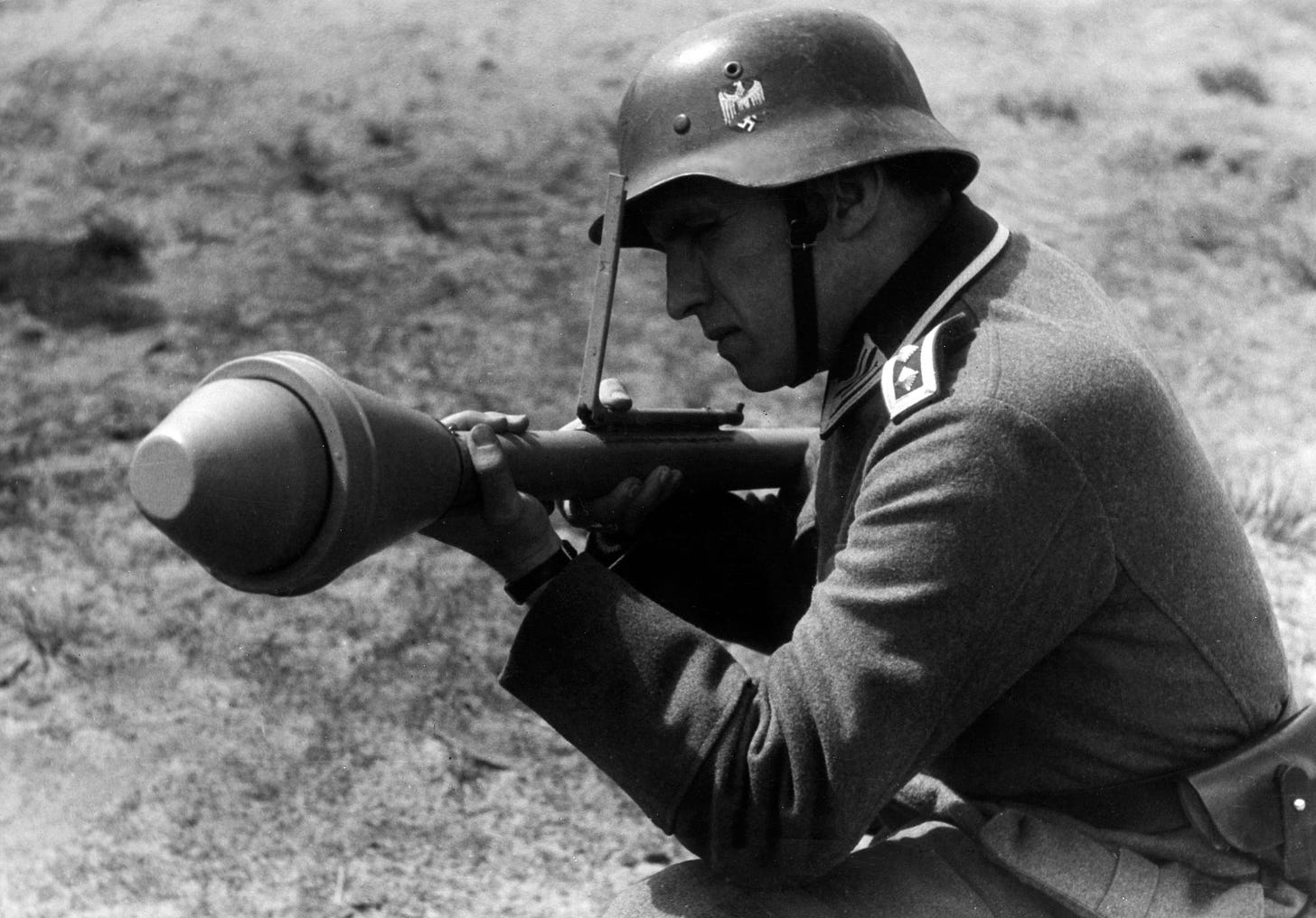
Needless to say, astride their bicycles and with very little artillery, the Volksgrenadier divisions were completely unsuitable for offensive action, but they were surprisingly combat effective in close-quarters defense, and this made them wonderful units for Germany's purposes, since this was no longer an army fighting to win a war but only to make its defeat as painful as possible for the enemy.
Narrowly extracting his forces from France, inserting precious reinforcements into the line, and reassembling shattered units on an ad-hoc basis - by the end of August, Model had recreated a continuous front across northern Belgium, and crucially had managed to hold the islands and peninsulas northwest of Antwerp, which ensured that the allies could not use the port despite capturing it on September 4th. General Omar Bradley described Model's resurrection of the German position the following way:
In one of the enemy's more resourceful displays of generalship, Model stemmed the rout of the Wehrmacht. He quieted the panic and reorganized the demoralized German forces into effective battle groups. From Antwerp to Épinal, 260 miles south, Model had miraculously grafted a new backbone on the German Army.
Model's stoic nerves and deft touch reassembling his line always draw high marks from the peculiar military historian caste, but we should not overemphasize or romanticize the Werhmacht's strength. This was a self-cannibalizing force reeling from a sequence of catastrophic defeats, building its line through self-destructive expedients, like using specialized airborne assets (the Fallschirmjäger) as line infantry, pulling resources from other fronts, and assembling ad-hoc battlegroups and Volskgrenadier formations.
Nevertheless, this was sufficient to greatly frustrate the allied camp. They had won a tremendous victory, driving the Wehrmacht from France and shattering its strength at Falaise, but they now faced the limits of their logistical network (the relevant chapter in Bradley's memoir is simply titled "Famine in Supply") and - crucially - the realization that they were losing the opportunity to translate their operational victory in France into a total strategic victory; in other words, Model had denied them the chance to exploit the rout in France by getting into Germany proper and winning the war outright.
It was this realization, that the war would likely not be won in 1944, that prompted British Field Marshal Bernard Montgomery to draft one of the most ambitious and heavily scrutinized allied operations of the war. One last chance to end the war by Christmas.
The Bridge at ArnhemOperation Market-Garden was a plan conceived in frustration. The allies had achieved a great feat of arms by shattering the German position in France over the summer months, but the seemingly miraculous reconstitution of the Wehrmacht under Model's command, along with the ongoing supply headaches stemming from the lack of an operative port, indicated that there was a lot more fighting ahead. This was dispiriting and irksome to the allies, who had felt (rightly) that only a few weeks previously the Germans were on the run. The sense now was that the reward for the victories of the summer was only a brutal winter campaign in a war that now seemed unlikely to end soon. Bradley later wrote that "Montgomery winced as we did over the sudden reappearance of German opposition on his front" - but Montgomery was doing more than just wincing.
In the first weeks of September, Montgomery drafted (and Eisenhower approved) Operation Market Garden. As is often the case, Market-Garden was simple in concept and dreadfully complicated in execution. The premise was cozy enough - the war could be won in 1944, it was thought, if the allies could get their mechanized forces over the Rhine River and into Germany. Therefore, Montgomery proposed to thrust the British 2nd Army northeast through the Netherlands to cross the branches of the lower Rhine (what the Dutch call the Nederrijn) at Arnhem - from there they would roll down into the German plain and have no terrain features of note between them and the German heartland.

The problem with this seemingly simple plan (drive to the river and cross it) was the peculiar geographic nature of the Netherlands, with its low lying wetlands and woods which are entirely unsuitable for armored operations. The terrain meant that the British advance would be confined largely to the main highway from Eindhoven to Arnhem (what is today the A50 highway, but in 1944 was called Highway 69) - creating a long, thin advance vulnerable to counterattack. The second problem was that this path of advance crossed no less than five significant rivers and canals. If the Germans managed to detonate any one of these bridges, the operation was kaput. Thus, a two part operation was necessary - the armored thrust up the highway to the Arnhem bridge (Operation Garden) and a series of paratrooper drops to prevent the Germans from blowing the bridges (Operation Market).
The mountain of postwar literature on Market-Garden tends to criticize the complexity of the plan. For the operation to succeed, the airborne forces had to secure all five bridges - even losing one would scuttle the whole thing. Furthermore, a shortage of air transportation meant that the drops would have to take place in waves, rather than all at once. As for the ground advance, it does not take a genius to understand that trying to push multiple armored brigades up a single highway is a tricky proposition. All things considered, Market-Garden was an operation that really had no margin of error. Everything had to go right - five bridges on one road - for it to succeed.
These were all real problems, but they rather miss the point. The allies wanted to end the war in 1944 for very obvious reasons, and the only way to do that was to get sizeable armored forces over the Rhine, and the only way to do that was to drive to Arnhem and cross the river, and the only way to do that was to push up the highway and secure the whole series of bridges along the way. Add it all up, and you get Market-Garden or something very much like it. If you wanted to end the war by Christmas, this was the play. So, the allies played it.
The problem with Market-Garden was not so much the complexity of the plan, but the fact that there were German forces who worked to foil it. Contrary to the common trope that Montgomery was surprised by the presence of Germans in the operations zone, he knew full well that they were there but believed that they would be largely combat ineffective units due to the mauling they'd received in France. In fact, one contemporary allied assessment concluded that, though Market-Garden was a risk, German forces were assessed to be so weak and disoriented that it would be negligent not to try it.
In fact, there were several operations-capable German entities of note at Arnhem, directly in the path of Montgomery's planned advance. One was an entire SS Panzer Corps, with its two panzer divisions: 9th SS Panzer was stationed only a few miles to the northwest of Arnhem, and the 10th was loitering a few miles to the south. Just as notable was the presence of Model himself, who had located his headquarters in a small town just to the west of the Arnhem bridge. Thus the most critical aspect of the whole operation - the air drop to seize the Arnhem bridge over the Lower Rhine - happened to land almost directly on top of Model and a pair of Panzer Divisions. In other words, the critical objective of the operation was occupied by nothing less than Germany's best defensive operator and a pair of the Wehrmacht's best tactical units.

The critical task of capturing the main road bridge in Arnhem fell to the British 1st Airborne division, and so it was this unit that received the dubious honor of dropping over Model's headquarters when the operation was launched on September 17. Market Garden was essentially doomed the moment the airborne troops hit the ground - within an hour, Model had organized battlegroups that established blocking positions and hemmed much of the 1st Airborne into a few small pockets. A battalion or so worth of men did manage to reach the all-important bridge, but they lacked the combat power to capture it and remained trapped on the north bank of the river, exchanging gunfire with the Germans on the other side of the bridge. By the end of the day, 1st Airborne was trapped in a pair of pockets - one around their original landing zone, and the smaller one around the north end of the Arnhem bridge - and could do nothing except dig in and wait for the ground forces to link up with them.
Unfortunately, the ground advance was having all manner of difficulty building up steam. The problem, once again, was unexpected German combat potential. The first stage of the assault, around Eindhoven, drove directly in between a pair of German units - 59th Infantry Division to the west, and 107th Panzer brigade, equipped with Panther tanks, to the east. Meanwhile, the road itself was clogged up with doggedly defended German roadblocks.

Because Operation Market Garden had called for only a single axis of advance, the British ground forces had no prospect for outflanking or avoiding these German defenses, and were obliged to slog their way up the road while fighting off counterattacks from either side. In fact, the terrain made any notion of fighting off-road almost impossible. The commander of the ground forces, General Brian Horrocks, flatly insisted that "The country was wooded and rather marshy, which made any outflanking operation impossible." It was the highway or bust.
With the ground advance behind schedule, the decision was made to proceed with a reinforcement of the airborne forces by dropping in the Polish 1st Independent Parachute Brigade to back up the British paratroopers around Arnhem. Unfortunately, the Poles landed on the south side of the Neder Rhine (the British were still stuck on the north bank) and were soon trapped against the river as well.

The whole thing ended rather quickly. With ground forces stuck in a slow and painful slog up the road, the allied paratroops at Arnhem were fundamentally doomed. The SS Panzer divisions around Arnhem wheeled in to crush the immobilized allied airborne forces, and it was all over by September 27. The Wehrmacht still held the Arnhem bridge.
Operation Market Garden is a much autopsied episode in the war - a fact that is perhaps odd, given how small it was. Total Allied casualties were a little over 16,000, with the Germans losing some 7,000 men at most. The worst of the damage by far fell on the poor British 1st Airborne, which took 1,500 killed and 6,500 captured (wiping out two-thirds of the 12,000 man unit). Still, in a war that was burning through divisions of all nationalities like cheap kindling, this wasn't a particularly grand or horrific battle.
The implication of Market-Garden's failure, however, was massive. It marked the end of an open and highly mobile phase of the war in the west and largely froze up the front for the following three months. The opportunity to exploit the rout in France had vanished, and the Wehrmacht once again manned a continuous front barring the path into Germany. The war would not end in 1944, and there would be no end-run over the top of the Rhine into Germany.
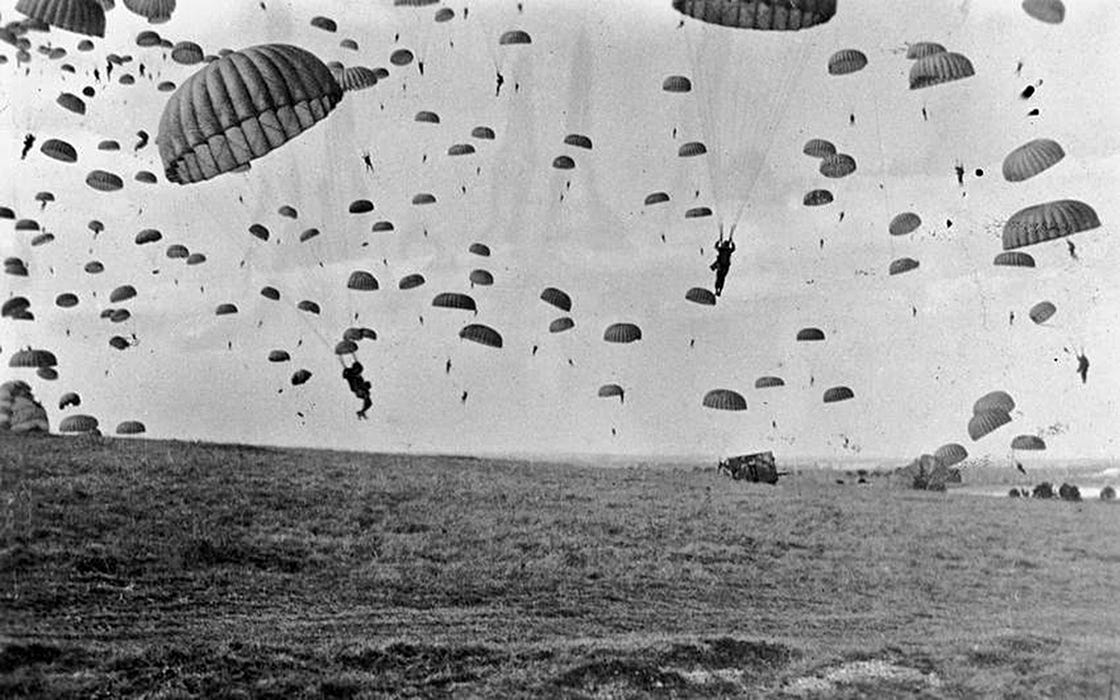
Part of the endless fascination with Market Garden stems, to be sure, from the nagging American dislike of Montgomery, which leads to something bordering on an ill-placed schadenfreude at "Monty's" failure. Naturally, American patriots did not extend the criticism to Eisenhower, who signed off on Market Garden with full agreement. Of course, on the other side, the British tend to be highly defensive of Market-Garden (and Montgomery by extension), and both Churchill and Montgomery argued that the operation was "90% successful" in that it liberated a swathe of Dutch territory. In any case, all manner of finger pointing ensued, with some Americans blaming Montgomery, Eisenhower blaming the weather, and Montgomery blaming both a "lack of support" and the Polish paratroopers, whom he accused of performing poorly.
They all should have blamed the Wehrmacht, and Model in particular. Operation Market Garden would have been a perfectly viable operation if the Germans had been in a state of disarray and general combat ineffectiveness, as they indeed had been as recently as the end of August. Model demonstrated - as if this war had not provided more than enough proof already - that modern armies have absolutely astonishing recuperative powers, so long as the command apparatus remains intact and the men in the field feel that the war is still worth fighting. In Holland, in 1944, Model's personal presence was significant, both through his skill in returning order and cohesion to his forces, and in his privileged access to replacements and equipment. In the case of Market Garden, a mere two weeks was sufficient for the Germans to sort themselves out and defeat Montgomery's audacious push for the Rhine.
The Germans had suffered two extraordinary defeats, in Soviet Belarus and in Normandy, which by all accounting ought to have pushed them past the breaking point and yet here they were, still fighting hard with a continuous front in both theaters - in both cases thanks in large part to Model's fanatical and competent handling of the operations map. The Germans could not win the war, of course, but the force regeneration powers of the Wehrmacht remained prodigious, German men of increasingly disparate ages still believed that the Reich was worth fighting and dying for, and no single defeat - no matter how catastrophic - was sufficient to knock the Germans out of the field. And so, with the front congealing into a solid wall, the summer maneuver period gave way to something far more primitive and horrible.
The Things Their Fathers SawWith the end of Market Garden and the failure of the allies to fully clear the river lines in a continuation of the summer campaigning season, the western front coagulated into a continuous arc of wall to wall armies, lined up across from each other all the way from the English Channel to the Swiss border. The German line - understrength and overmatched, but still continuous and cohesive - ran from the channel coast just north of Antwerp (where littoral positions still allowed the Wehrmacht to block allied access to the port) due east towards Arnhem and the Rhine; from there it curled southward towards Switzerland passed through the Ardennes, the Moselle Valley, and the so-called Burgundian Gap, in a course that roughly corresponded to the prewar western borders of the Reich.
Overall, this front was nearly 600 miles long, and given the parlous state of German manpower it was hardly a simple matter to man it properly. Crucially, however, the allies were still struggling with endemic fuel shortages (and would continue to do so until Antwerp was unblocked) which forced them to undertake limited offensive actions - in effect, attacking the entire German line frontally all across the board in a firepower-intensive grind.
Wall to wall armies from the channel to the Alps, limited mobility, and fires-intensive frontal assaults across a broad front. If it sounds familiar, that's because it is - and for the last three months of 1944, the Germans and the Allies would fight an attritional-positional battle reminiscent of the First World War: a gruesome homage to the war their fathers fought.
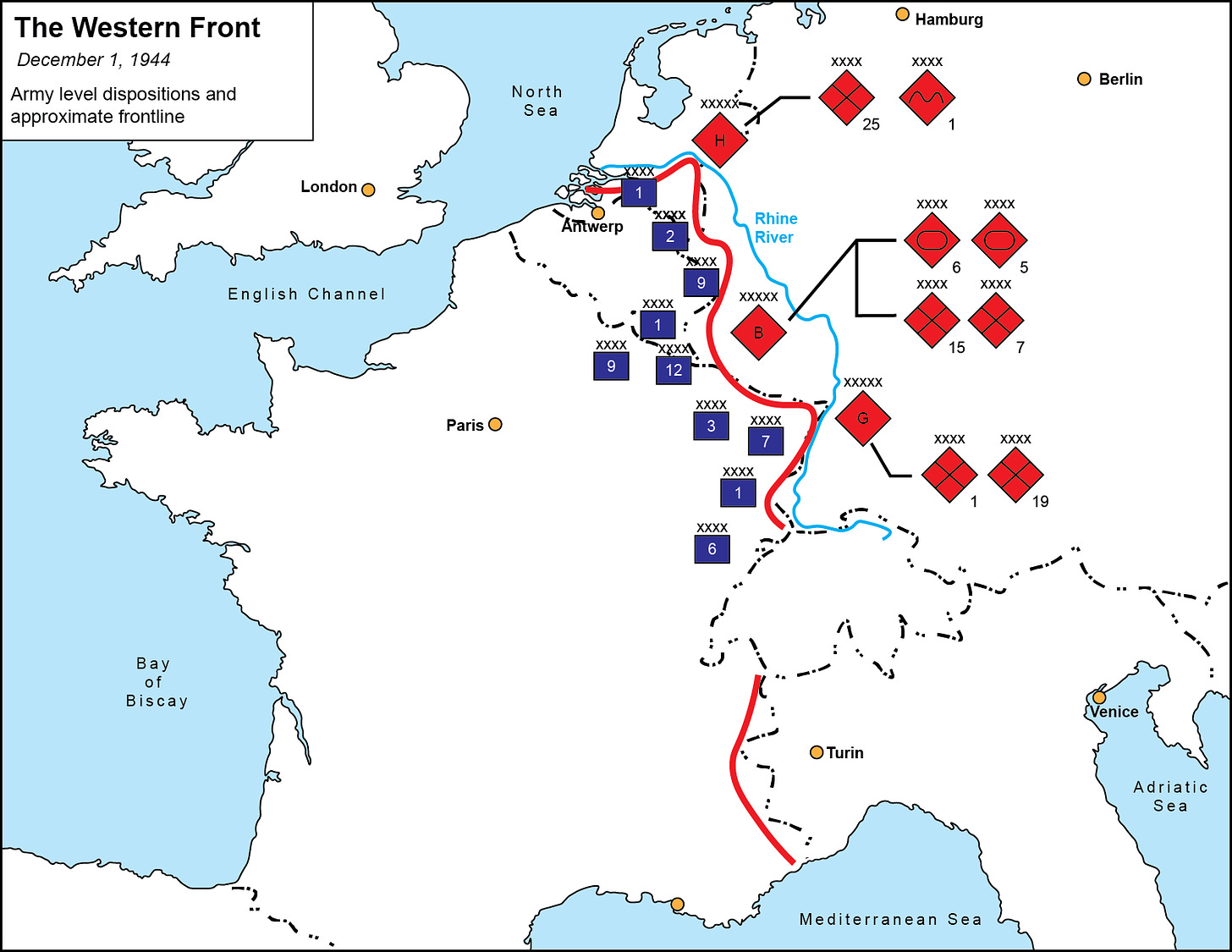
In theory, much of the German defense was now anchored on the infamous "Siegfried Line", or the "West Wall" - a dense nest of German defenses erected in a sort of mirror image to France's prewar Maginot Line. On paper, fighting on a prepared defensive line ought to have accrued significant advantages for the Wehrmacht, and indeed German propaganda relentlessly trumpeted the idea of the Reich's impenetrable western border, defended as it was by both the West Wall and the Rhine.
However, notwithstanding the obvious anachronism of an "impenetrable defensive line", and even ignoring the obviously stark warning from Germany's own experience in 1918, when they had lost the war despite having both the Hindenburg Line and the Rhine to defend behind, it turned out that the mighty West Wall was not all it was cracked up to be. In particular, the West Wall had several specific defects:
Much of the original line had been built in 1938 and 1939, designed to withstand the ordnance of the day - consequentially, many of the emplacements were simply not built to survive the much more powerful weaponry in use by 1944.
Many of the West Wall's heavy weapons (particularly artillery) and equipment (like radios) had been stripped down throughout the war for use elsewhere, and in particular to equip the Atlantic Wall in France.
An emergency construction program designed to get the wall back into fighting shape was entrusted to domestic Nazi party officials (Gauleiter) and civilian construction crews who had no real understanding of military engineering; consequentially, the new portions of the line tended to be haphazard tangles of bunkers, pillboxes, trenches, barbed wire, and tank obstacles which were not arranged in a systematic way - for example, there was relatively little thought given to lines of sight or fields of fire.
Thus, despite the ostensible impregnability of the West Wall, German troops found a disappointing mixture of sloppily built new fortifications and outdated prewar bunkers that would be pulverized by modern allied munitions - and underlying it all, an endemic shortage of heavy weapons, communications equipment, ammunition, mines, and men. Probably the best thing that can be said for the West Wall is that it did at least have plenty of obstacles to complicate the allied assault, and the presence of the belt helped give confidence to inexperienced Volksgrenadier units who did not know any better - green troops always feel and fight better in fixed defenses. But certainly, no German soldier with even a modicum of realism believed that they could hold the line in the west indefinitely.
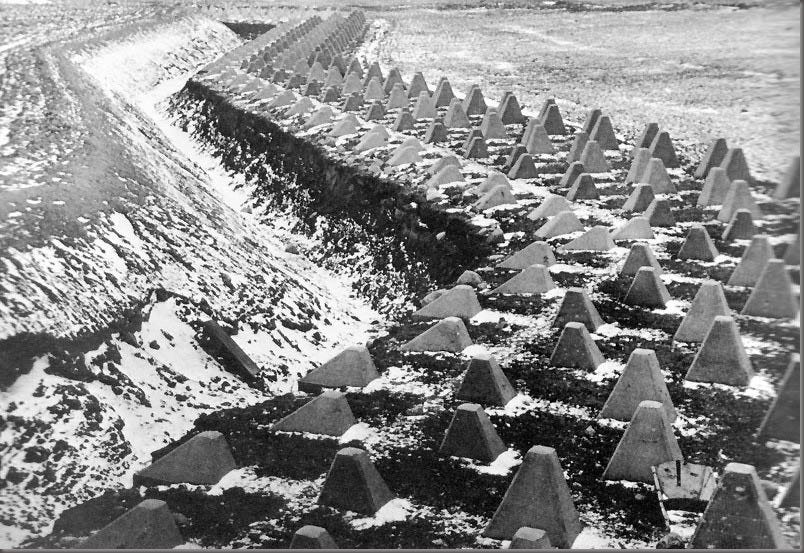
In the short term, however, a lack of allied fuel and logistical capacity - combined with Eisenhower's decision to keep up the pressure across the entire front - meant that there was nothing to be done for the allies except to attack the German position head on. This became an ignominious and inglorious period of the war - the allies continued to churn their legs and grind forward, but their advance was slow and characterized by general carnage.
The allies would launch a series of limited offensives - virtually unremembered today - which generated enormous casualties on both sides as they bashed their way through static German defenses. General Bradley would orchestrate Operation Queen - intended to drive over the Ruhr River up to the Rhine to establish a launching pad for a future offensive into Germany proper, but the assault devolved into an agonizingly slow and bloody fight, with the Germans defending effectively in the dense confines of the Hürtgen Forest. Operation Queen failed to reach the Rhine - in fact, it did not even cross the Rhur - and cost US 1st and 9th Armies some 40,000 casualties.
Meanwhile, farther to the south, General Patton' 3rd Army had a damnably difficult slog trying to clear the Germans out of the Loraine Region. In particular, the Germans put up a fierce resistance at the fortress complex around Metz, and Patton's attack - which began on September 27 - could not clear out the last pockets of resistance until December 13.
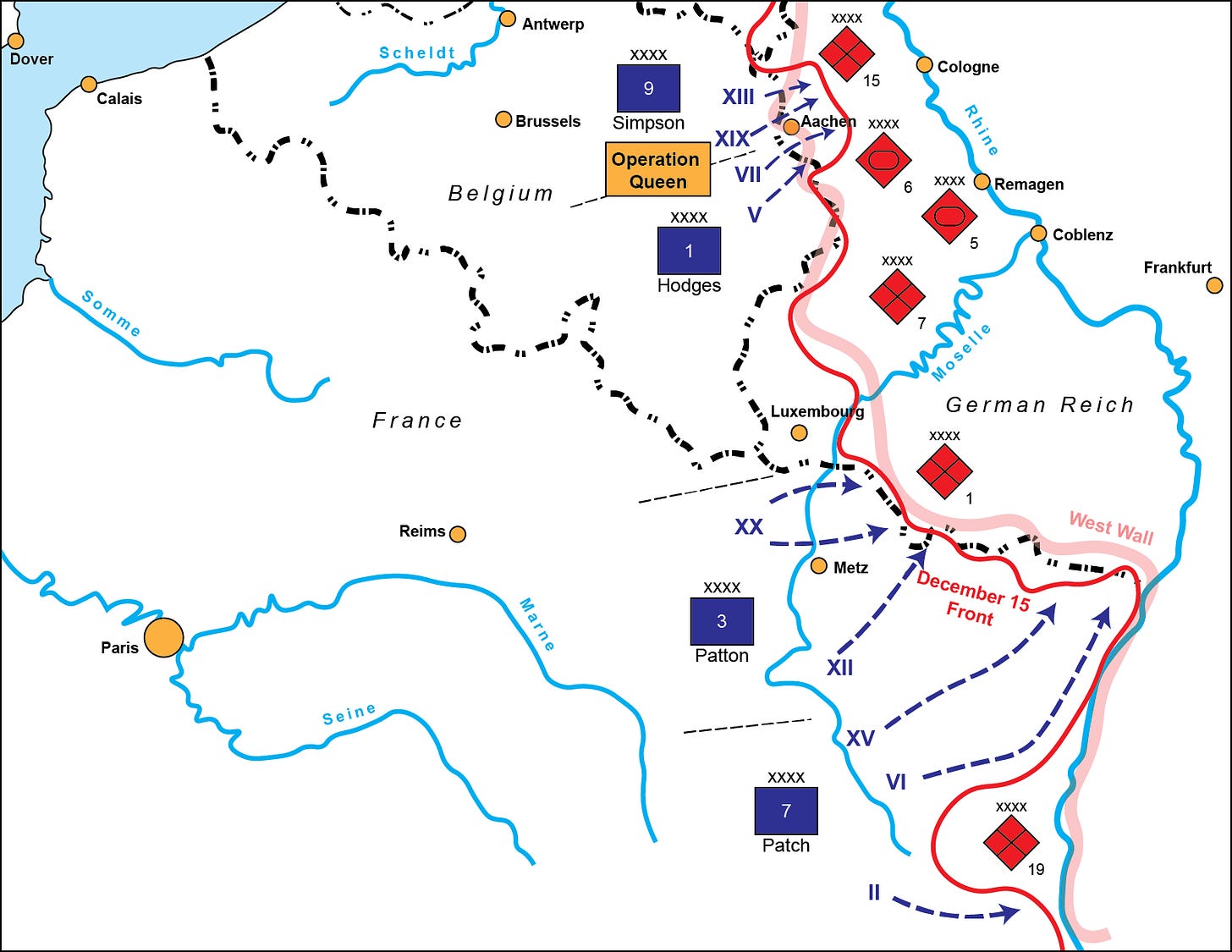
The Lorraine Campaign became a topic of notoriety and great criticism against Patton (though today most people have never heard of it). Like the rest of the allied operations in the autumn of 1944, Patton's assault towards Metz was nothing more than a frontal assault which generated huge casualties, with the American advance greatly complicated by both incessant rain and logistical difficulties. Patton became somewhat obsessed with Metz, which he grandly (and incorrectly) proclaimed had not been captured in centuries. However, Patton the cavalryman was completely out of his element in a grinding positional slog, and really did very little to direct the battle - he communicated only infrequently with his subordinates, rarely intervened in battle management, and generally spent most of his time griping at his command post and in his diary. He speculated that his army was being deliberately starved of fuel as a sop to Montgomery, and that the supply difficulties were somehow being manufactured to influence the presidential election back home in the USA. Meanwhile, he wrote to his wife asking her to send him Pepto-Bismol - what he called "pink medicin" - claiming that the rain and the slogging attack were giving him an excess of bile.
By any measure, the Loraine Campaign was not Patton's finest moment. He was essentially missing in action, exerting little control over the operation, preferring to gripe and pout in his headquarters. Meanwhile, his Third Army created a meatgrinder in its assault, suffering 55,000 casualties in addition to some 42,000 "nonbattle" casualties - frostbite, sickness, trench foot, and the like. The latter in particular had become an epidemic among American troops, who found that the army regulation footwear was simply inadequate for cold or wet weather. The American quartermaster in Europe, General Robert Littlejohn, admitted that in snow the standard issue boots were "nothing but a sponge tied around the soldier's foot." But boots or no boots, the attack went on. When Bradley urged Patton to break off the attack on Metz - "For God's sake, lay off it", he said, "You are taking too many casualties for what you are accomplishing" - Patton ignored him and railed about Bradley's timidity in his diary.
But Bradley had a point - Lorraine was remarkably costly to Patton's Army. According to a 1985 US Army study of the campaign (which emphasized Patton's indifference to overstraining his logistics) fully a third of all the casualties suffered by Patton's 3rd Army in the entire war were incurred in Lorraine during only a three month period. Probably the most poignant summary of the autumn fighting came from a war reporter embedded with Patton's 5th Infantry Division, which took tremendous losses reducing one of the Metz forts. He wrote, simply: "We were attempting to assault a medieval fortress in a medieval manner." But perhaps we are being too hard on Patton - Bradley's Operation Queen fared no better, nor were the British going anywhere fast up in the Netherlands.

It was by any reckoning a miserable autumn, one which has been largely forgotten in the historiography simply because it seems to be such an aberration - an archaic throwback to the last war. Instead of sweeping mechanized operations, the war had devolved into ugly frontal assaults that burned through entire infantry battalions to advance 200 yards through the forest and the mud. Losses were severe enough that American units became chronically understrength, and casualties routinely outstripped replacements. Patton, in an effort to keep his frontline units as strong as possible, began rounding up rear area personnel - clerks, administrative personnel, drivers, and so forth - to be added to his rifle units after a cursory infantry training. By December, fully 10% of Patton's rear area personnel had been thus "drafted" into the infantry. We are of course used to the idea that the Germans had to increasingly resort to emergency stopgap measures to fight the war, but the idea that the powerful American Army would have to do likewise is more troubling.
Of course, the brutal and firepower-intensive frontal allied advance generated plenty of German casualties as well, and the Wehrmacht indeed frequently got the worst of it due to their lack of artillery and other heavy weapons. In the long arc, this sort of casualty trading remained a terrible game for the Wehrmacht, but that did not make it any more pleasant for the Anglo-Americans, who were universally frustrated with the slow pace and exorbitant cost of this phase of the war. Bradley would at one point confide that he now feared that the Germans could continue fighting "bitter delaying actions" until 1946. Few could doubt that the allies were winning, but victory seemed to be much farther off and much more costly in lives than they had reckoned.
But the Wehrmacht was not particularly interested in delaying actions. The entire arrangement of the war had become abhorrent to them, with the allies holding all the initiative and slowly grinding the Germans to dust. This was no way for a German army to die - it ought to die as it lived, which is to say attacking, moving, operating - not fighting a reactive defense out of static positions. The Wehrmacht was not a rodent, to die cowering in a burrow, but a wolf that lived and died by the hunt. It was time for the last hunt.
Watch on the RhineThe Germans had been looking for an opportunity to counterattack almost from the first moment that the battle began to go wrong for them in Normandy, and they never really stopped. No sooner had Bradley breached the German line with Operation Cobra than the Wehrmacht jumped to put together an ill-fated counterattack (Operation Luttich) which led directly to the catastrophic firebag at Falaise. Undeterred by this debacle, the Wehrmacht continued to seek opportunities to regain the initiative, but found this to be very difficult given the pace of the American explosion into France. A plan to have 5th Panzer Army counterattack from the Dijon area (southeast of Paris) proved futile when Patton overran the staging area in a fury, and by late August it was clear that no proactive occupations could be launched in the near term, given the state of the German forces fleeing from France. Indeed, it was all Model could do to get them sorted out into a coherent front, as we have seen.
Given the beating the Wehrmacht had taken in France, it is perhaps surprising that they even dreamed of attacking, but Hitler and the OKW (Wehrmacht High Command) talked themselves into an optimist scenario in which the Germans would have a strategic window during the winter to go on the offensive. Specifically, a winter offensive was viewed as not only possible but even advantageous for four reasons:
Poor winter weather could be expected to intermittently ground allied aircraft, neutralizing the enemy's advantage in the air.
Allied logistics were (correctly) viewed as inadequate and fragile, such that allied frontline units were expected to be poorly supplied in the winter.
Winter mud and snow were expected to further strain allied truck-borne logistics and the mobility of allied reserves.
Finally, the interim period from October to December could be used to outfit a mechanized strike force with new equipment.
The general impression was that the winter months would present an opportunity to unleash a powerful new mechanized package, complete with brand new Panzer Divisions, against an allied army with overstretched logistics and an air force grounded by blizzardous conditions. All in all, this was an overly rosy assessment which required all manner of optimistic assumptions, but for a German army that was preternaturally conditioned to attack, it represented the only remotely reasonable hope. And so, the decision was predestined: the Germans would attack in the winter.
But where? And with what objective? These questions fell to the OKW planning staff.
Remarkably, despite nearly a full six years of war for Germany, by the autumn of 1944 the OKW had never planned a major operation. Here, we dovetail into the troublesome German organizational chart. Nazi Germany had two major military planning bodies: the OKW (Wehrmacht High Command), and the OKH (Army High Command). In theory, the OKH was subordinate to the OKW, with the Wehrmacht Command acting something like a Joint Chiefs of Staff. However, due to Hitler's own unique management style, a decision had been made years prior to instead divide operational jurisdiction, such that the Army (OKH) ran the war in the east against the Red Army, while all the remaining theaters (air defense, naval operations, the Mediterranean and North Africa, France, and so forth) were run by the OKW. In a more simplified sense, the Soviets fought German forces under the OKH, while the Anglo-Americans fought in the OKW's theaters.
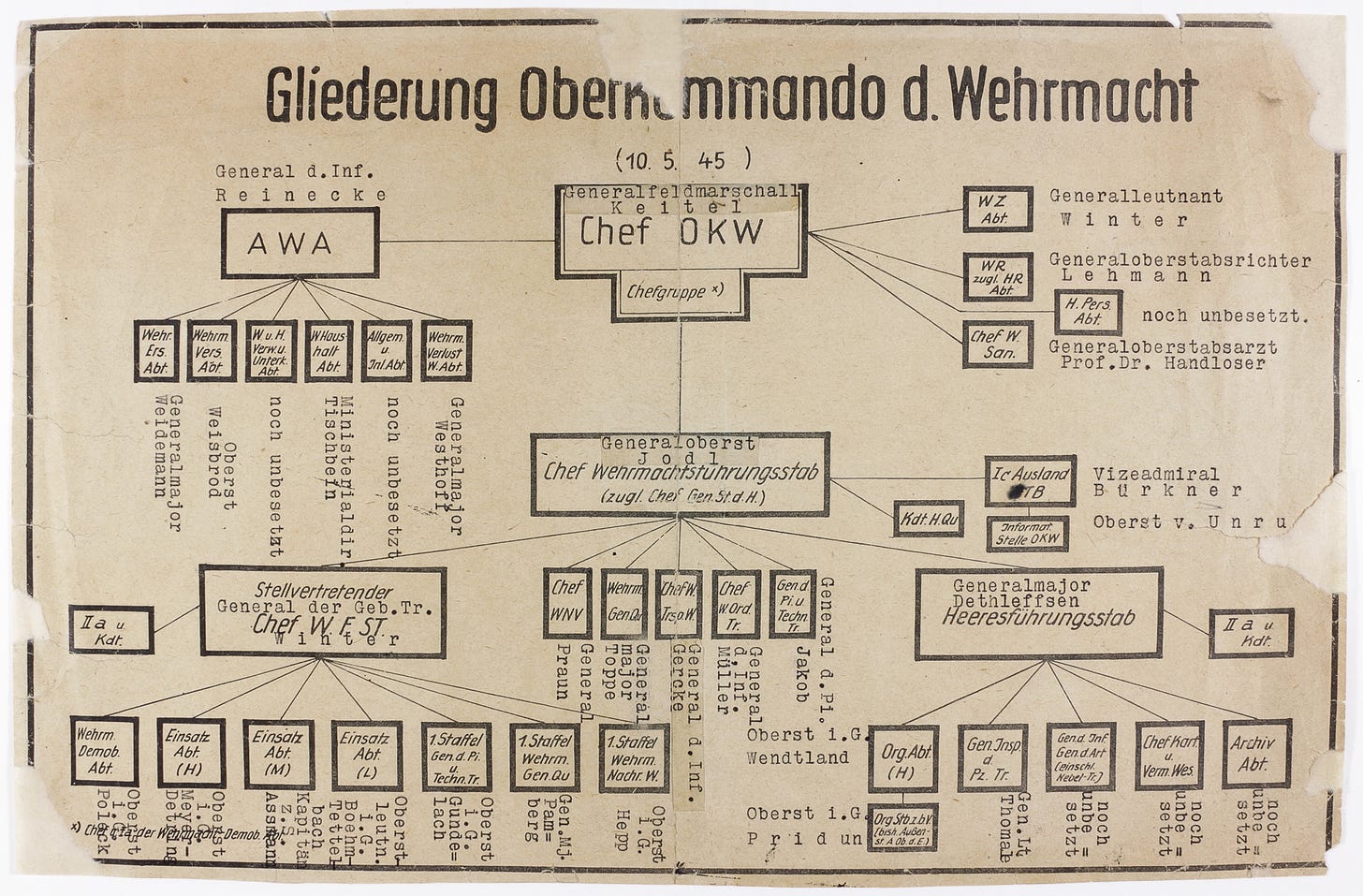
The level of disharmony is notable. While the allies managed to coordinate military operations at the international level, with Britain, the United States, and Commonwealth forces operating in the field together and the USSR kept closely in the loop, Germany in effect fought two separate wars, with separate high commands managing the various theaters. Remarkably, Hitler himself was the only real point of coordination between the OKW and the OKH. In 1944, however, what mattered most was that all of the Wehrmacht's major ground operations had been planned by the OKH. The OKW had mostly been running a strategic defensive, with attacking actions planned by commanders in the field.
Thus (and this is a point of genuine importance) the great German winter counteroffensive, on which all their hopes rested, was to be planned by an OKW planning staff (under General Alfred Jodl) who had never planned a major ground operation before. The army staff, which had been fighting a vicious war with the Red Army for years, had plenty of experience, but this was not their theater. Unsurprisingly, their proposal bore all the hallmarks of amateurism and "by the book" planning.
The eventual OKW plan, named Wacht am Rhein - "Watch on the Rhine" after an old German patriotic song, somehow managed to be both unrealistic, audacious, and completely unoriginal and repetitive. The plan called for three German armies (5th Panzer, the newly created 6th SS Panzer, and 7th Army) to be concentrated in the region of the Ardennes forest south of Aachen. They were to assault the positions of the US 1st Army under General Courtney Hodges, and overrun them en-route to the Meuse River. 7th Army would break off its advance and take up a blocking position to the east of the Meuse, protecting the flank of the two Panzer armies, which were to cross the Meuse in the gap between Givet and Liege. From there, 6th SS Panzer would drive north to Antwerp while 5th Panzer covered the gap between Brussels and the river. If all of these objectives were met, the Germans would have retaken or at the very least blocked up Antwerp (the vital port feeding the ally war machine) and encircled no less than three allied armies on the northern bend the Meuse.
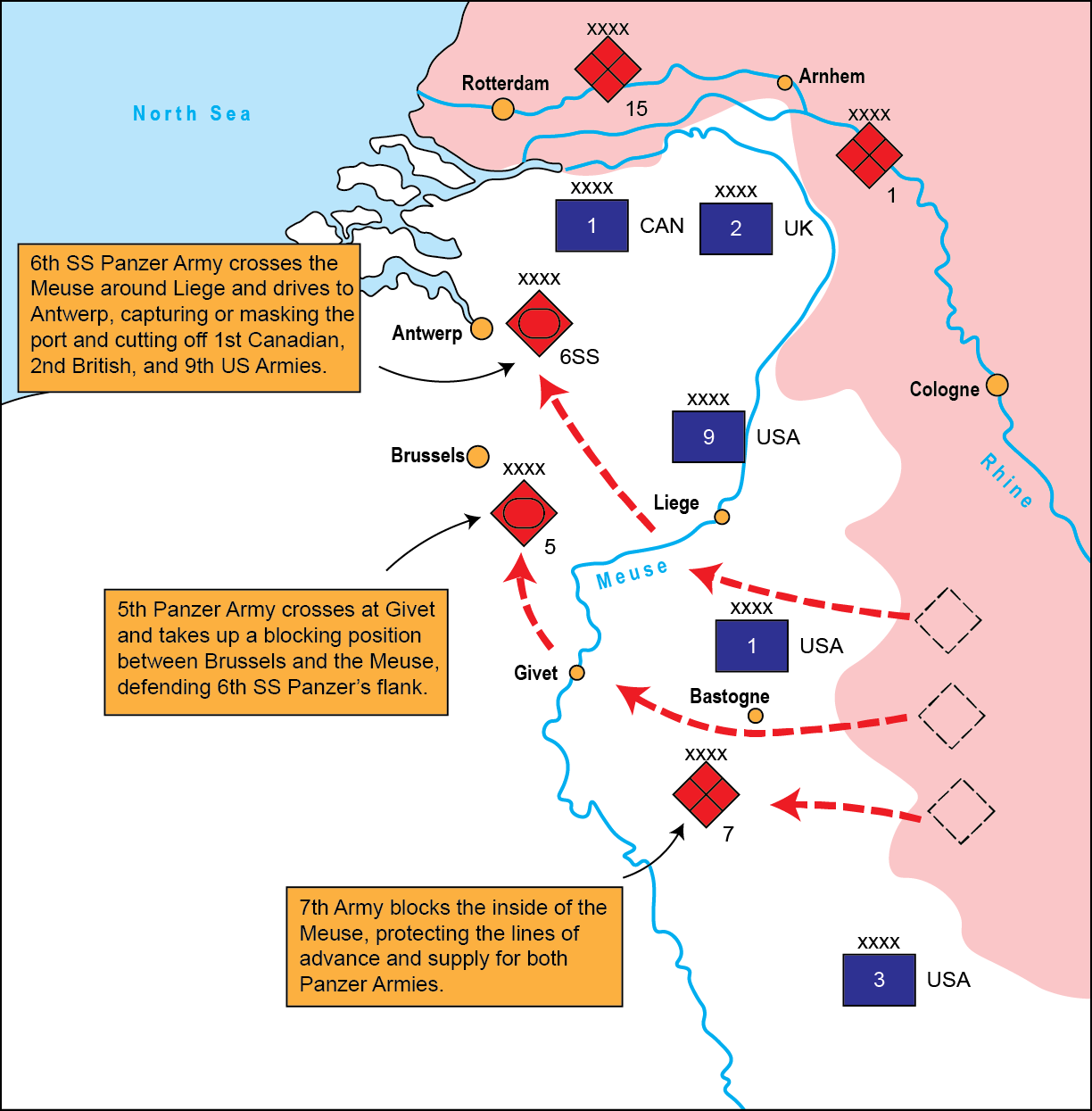
Purely as a map exercise, there was nothing overly creative about Watch on the Rhine. In fact, it bore a clear resemblance to Manstein's famous "sickle cut", by which the Wehrmacht had defeated France four years previously. All in all, it was a fairly textbook operation for a German officer corps that had been thinking about (and fighting) wars in this region for generations. Yet the plan was also hilariously, naively optimistic - it relied on very tenuous assumptions that the allies had no reserves and would react slowly and weakly to the attack (as the French and British did in 1940). It also called for the panzers to cover ground outrageously fast - the lead elements were expected to reach the Meuse (more than 100 miles from their start lines) on the first day. Finally, the operation assumed - as if this were a trivial matter - that the Panzers could refuel themselves on the go from captured allied fuel depots, and that the allied air force would be grounded by bad weather. Indeed, in something approximating a mental cheat code (or delusion), Jodl and his staff simply did not consider allied air power as a factor, writing in the assumption that the weather would be bad.
When the OKW finally revealed its plan to the men who would have to implement it - Model and Rundstedt - the initial reaction was something less than enthusiastic. Rundstedt argued that Antwerp was simply too far - "If we had reached the Meuse, we should have got down on our knees and thanked God—let alone try to reach Antwerp" - he said. As an alternative, Rundstedt proposed (and eventually cajoled Model into cosigning) Operation Martin - it would start similarly to Watch on the Rhine, but instead of crossing the Meuse and trying to bag a whole slew of allied armies, it would curl up the inside of the Meuse and encircle a smaller grouping of American divisions (elements of 1st and 9th armies) around Aachen. This was more reasonable, they argued, and most importantly of all would keep all the German forces on the east side of the Meuse, to avoid the complication of operating over a major river.
But of course, Operation Martin was a nonstarter. This was a classic example of a "small solution", whereas Watch on the Rhine - which promised to encircle nearly half of the allied formations in Europe and capture their arterial port - was a "big solution." This was familiar language that German planners had used many times before, and both the aggressive culture of the German military caste and Hitler's own nature as an inveterate gambler forbade the small solution. Hitler and the Wehrmacht always went for broke, and in 1944 they did so again - and even Model and Rundstedt, whatever their reservations, gave full agreement to Watch on the Rhine and did their duties to implement it.
As was to be expected, of course, assembling the force for Watch on the Rhine was not a trivial task for a German army and state that had been pushed to the limits. Most readers are familiar with the fundamentals of late war German weakness - shortages of trained manpower, fuel, vehicles, and munitions - but there were other, more specific issues at play in the Ardennes region in 1944. The German assembly area was quite road-poor, and allied airpower meant that equipment largely had to be moved at night to avoid detection. Throw in a shortage of motor transport and you have a serious problem moving the requisite forces into their staging zones - a problem completely separate from the larger strategic quandary of building enough tanks and training enough men. The hilly forests of the Ardennes are not an easy place to congregate forces in ideal circumstances, let alone when the enemy is watching from the sky. It made for a great many night marches and laborious trips hauling ammunition and equipment in with teams of horses.
Military intelligence and deception had never been a strong suit for the German army - this was always a marked advantage for the allies, with the Anglo-Americans in particular specializing in cryptography and code breaking, and the Soviets having their particular form of military deception, famously called maskirovka. But with Watch on the Rhine the Germans gave it their best effort, seeking not only to hide their deployment with night approaches, but giving an overall impression that they did not intend to attack at all. They generated a stream of fake radio traffic referring to a "defensive battle in the west", and even the name of the operation - Watch on the Rhine - carried a defensive connotation. Most importantly, however, the Germans generated an elaborate scheme designed to hide the headquarters of their various armies. Even as Sixth SS Panzer Army congregated for the attack, a fake headquarters for the army remained operational almost eighty miles to the north, complete with radio and railroad traffic in and out, giving a realistic impression that the army was in the line around Cologne. Additionally, an entirely fictional army (the ""25th Army") was created in occupied Holland, with a facsimile army headquarters and the 10 fake divisions. Meanwhile, men and vehicles continued to trickle into the staging area in the east of the Ardennes.
Painstakingly, and with many delays, the Wehrmacht managed to assemble a genuinely impressive assault package for Watch on the Rhine - Nazi Germany's last great force accumulation. Model had his three armies in the line (under his overall command in Army Group B) containing no fewer than 200,000 men, 600 Panzers, and nearly 2,000 assault guns, tank destroyers, and armored vehicles. In the grand scope of the war, this was not a world-beating force, but for the battered Hitlerian Empire it was an impressive package - as good as it was going to get. The Luftwaffe was even ready to make a rare appearance. Bad weather was expected to ground the air forces, but in the event that the weather cleared, the Germans had assembled more than 60% of their remaining inventory of fighter craft - nearly 1,700 planes - to contest the skies. One last army for one last battle. The date was set: December 16. It was snowing.